OSV
The UK's Trusted Leader in Car Leasing and Sales
Nissan Qashqai Review: The ULTIMATE Family SUV?
- Watch Nissan Qashqai review
- What is the exterior design of the Nissan Qashqai like?
- What is the boot like?
- How does the interior of the Nissan Qashqai feel?
- What tech is on offer?
- What kind of engine does a Nissan Qashqai have?
- What is the Nissan Qashqai like on the road?
- Which Nissan Qashqai makes the best company car?
- Which Nissan Qashqai model is best?
- What is our verdict on the Nissan Qashqai?
Is it time for a new family SUV that’s stylish, spacious, and packed with safety tech? In our Nissan Qashqai review, we tackle the question: Is the new third-gen Nissan Qashqai your ideal family car?
The original Qashqai, introduced in 2006, set the trend with its sleek exterior, roomy interior, and elevated driving position. It inspired rivals like the Ford Kuga and Volkswagen Tiguan, shaping the SUV market.
Despite not having an electrified version, the Qashqai dominated the UK market in 2021, ranking as the best-selling SUV with over 30,000 registrations and the 7th best-selling vehicle overall.
It faces competition from electrified models like the Peugeot 3008 and Ford Puma, as well as premium alternatives like the BMW X1, Mercedes GLA, and Volvo XC40.
In this comprehensive Nissan Qashqai review, we’ll dive into the latest third-gen model, examining its evolution from its predecessor and determining if it’s the top choice for a family SUV today.
What is the exterior of the Nissan Qashqai like?
Let’s jump into the Nissan Qashqai review, starting with the facelifted front end. It’s bolder than the second-gen Qashqai, with striking LED headlights giving it a feline touch. The grille impressed us with its piano black trapezoidal design and chrome accents.
The massive bonnet and side crease lines add to its distinctive, powerful, and sleek appearance, making it stand out among family SUVs.
In our review, we chose Ceramic Gray paint, which we loved, and paired it with a contrasting pale black roof, one of the available two-tone options.
These cost around £1,145, and there are more choices, including metallic colours. Feel free to reach out to our team for further details on customization.
While the new Qashqai offers personalization, if you prefer the standard colour, it’s Flame Red, also seen on the Nissan Juke. These colours enhance the car’s design.
The crease lines continue along the side profile, leading to alloy wheels ranging from 17 to 20 inches. We opted for the top-tier “Tekna+” trim with 20-inch alloy wheels, which impressed us with their design. However, note that larger wheels can transmit more road imperfections, affecting the ride comfort. Keep this in mind when choosing your configuration.
Following those crease lines, let’s look at the door mirrors. These electronically folding mirrors are not only heated for those chilly mornings but also fully adjustable from the inside for your preferred angle.
They include a handy blind-spot monitoring feature, lighting up when a car passes closely and featuring indicator lights on the mirror’s end, adding a high-tech touch to the Qashqai.

We also appreciated the chrome inlay along the windows and colour-matched door handles. The chrome roof rail, while stylish, may not be the most practical feature.
On the bright side, there’s a beautiful glass sunroof that really enhances the cabin’s ambience and is a standout feature of the Qashqai. It adds a delightful touch of brightness and life to the interior.
Moving to the back, the Qashqai offers rear privacy glass, a shark-fin antenna, and a sporty rear spoiler—a nod to the crossover SUV trend. The rear light clusters merging around the tailgate add a nice touch, although the overall rear design is somewhat generic for a family SUV.
Despite the typical SUV appearance, the Qashqai maintains its identity, especially noticeable in the changed front end. The rear features a large privacy glass panel, Qashqai badging, and a silver-finished rear bumper.
What is the boot like?
The Nissan Qashqai now features an electronically operated tailgate, a first for this model, making it convenient for handling heavy shopping bags. While its boot space isn’t as generous as the Skoda Karoq or Volkswagen Tiguan, it still offers practicality.
The available space varies by trim level. Entry-level Visia and Acenta Premium trims provide 504L of boot capacity. However, higher-spec trims (N-Connecta, Tekna, and Tekna+) reduce it to 479L due to a height-adjustable boot floor.
While this lowers capacity, it’s a practical feature, and you can remove it for extra space, making it worthwhile, especially with the top-tier Tekna+ trim.
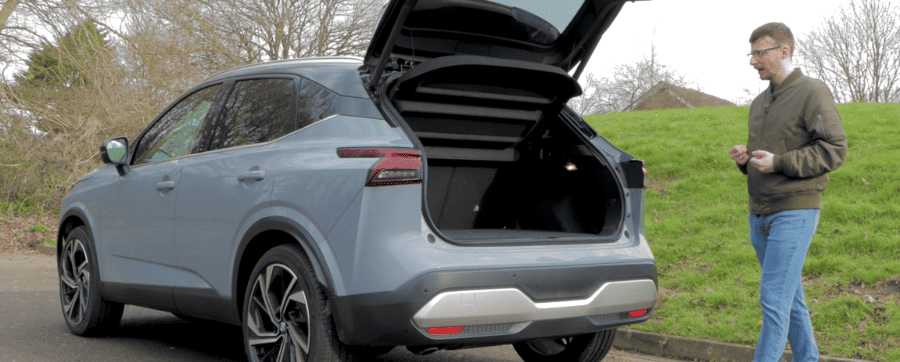
It’s worth noting that the Bose sound system, present in the top-spec model, occupies an additional 40L of space, which might disappoint those looking for maximum utility in the highest trim.
The Nissan Qashqai’s boot comes with practical features like a 12-volt socket on the right, a tethering hook on the left, hooks on the base for securing objects, and useful cubby holes for items prone to rolling.
To expand the boot capacity, simply fold down the rear seats; they’re spring-loaded for easy folding in a 60/40 arrangement. The height-adjustable boot floor, aligns with the seats, eliminating any floor gap. This SUV offers between 1379 and 1447L, depending on the variant.
For more details, including information on entry-level trims with extra boot space, reach out to OSV’s Vehicle Specialists at 01903 538835 or book a FREE consultation using the banner below, at your convenience.
What does the interior offer?
The latest Qashqai has transformed its once uninspiring interior into a smarter, more appealing space. Highlights include a premium leather steering wheel and dash with elegant stitching.
This attention to detail extends to the rear cabin, a rarity in affordable SUVs. The air conditioning unit, adorned with Piano Black buttons, complements the infotainment screen border.
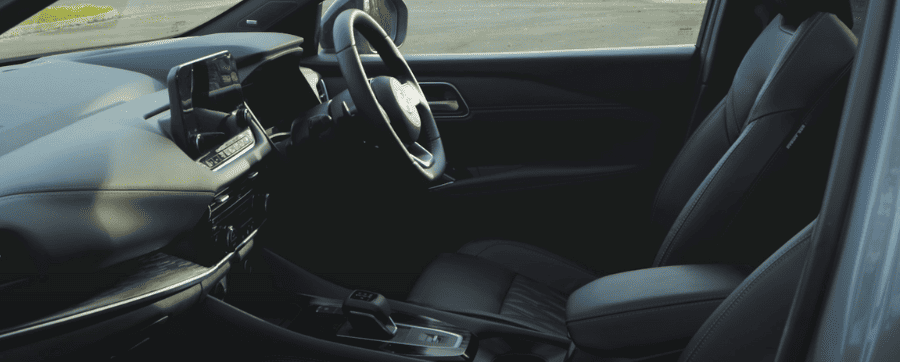
While some areas, like the dashboard and footwell, feature cheaper materials, the overall build quality is commendable, especially considering its affordability in the family SUV segment.
With five upholstery options available, the Qashqai offers a range of choices as you move up the trim levels.
The seats in the Qashqai offer excellent adjustability for finding your ideal driving position, allowing for a high vantage point on the road. Visibility is outstanding thanks to slender side pillars, reducing blind spots at junctions.
Models from “Tekna” upwards even feature electrically adjustable lumbar support. However, sitting all the way back can become uncomfortable on longer journeys due to an uncomfortable spot.
The front cabin is spacious, ensuring you won’t feel cramped beside your front passenger. The bulky centre console effectively separates the spaces without feeling confining.
The impressive glass sunroof floods the cabin with light when retracted, creating a calming atmosphere, making it a must-have feature in the Qashqai.
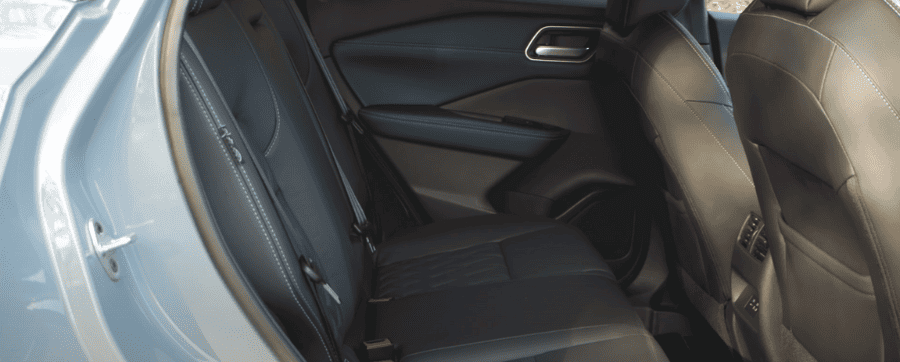
Moving to the rear cabin, the doors open nearly 90°, making it easy to install a child’s seat using Isofix fittings. The new Qashqai’s increased length creates ample headroom, even with the optional glass sunroof. Legroom is reasonable but depends on front seat positioning, and the supportive rear seats ensure comfort.
Backseat passengers have seat-back pockets for magazines or tablets. However, rear door bins are small and oddly shaped. The windows don’t fully wind down, a common feature in many modern vehicles.
While rear passengers share the front climate control, there are USB and USB-C ports for their convenience.
If there’s no middle passenger, the centre armrest offers cupholders but is somewhat uncomfortable due to the plastic design. The middle seat is tolerable for shorter journeys, but the transmission tunnel, while not massive, could be flatter for comfort and space optimization. Note that the middle seat is higher than the others.
What tech is on offer?
On the left of the steering wheel, you’ll find media controls for the infotainment system and a scroll wheel to navigate the driver display. On the right, there are cruise control settings, and paddle shifters, and even with an automatic transmission, you can switch to manual mode for on-the-fly gear changes.
The driver display is sharp and easy to read. It includes a rev counter on the left and a speedometer on the right, displaying speed limits, fuel levels, and basic info.
You can access various options, like a drive computer, tire pressure, compass, music controls (via Apple CarPlay), and customizable driver assistance features like blind-spot monitoring, forward collision warning, and lane keep assist. The display is 7 inches standard but upgrades to 12 inches from the Tekna trim onwards.
Additionally, higher-spec trim levels offer a 10.8-inch heads-up display, a favourite feature. It projects speed limits, your speed, and turn directions onto the road ahead, eliminating the need to look away from the road for crucial information.
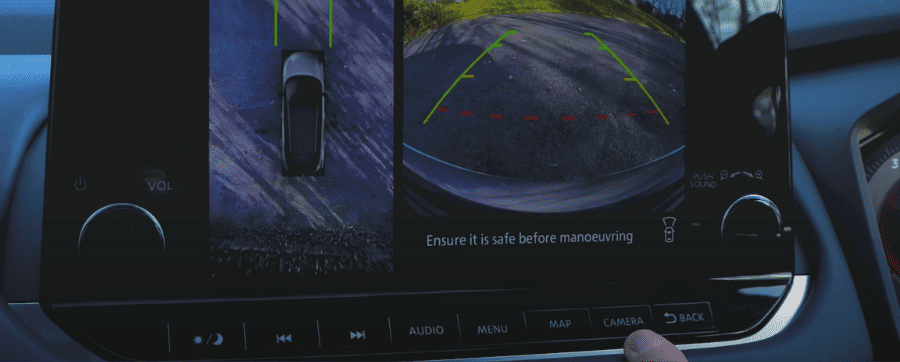
The media display, surprisingly smaller than the driver display, measures about 9 inches in the Tekna+ trim. Despite some critics, Nissan’s infotainment system has its merits.
It’s responsive, features sharp graphics, and large icons for quick glances while driving. Shortcut buttons at the bottom offer easy access to essential functions. Navigation is relatively speedy, and you can connect your smartphone through Apple CarPlay or Android Auto.
Other amenities include DAB radio and Bluetooth. With the top-tier “Tekna+” trim, you get the impressive Bose premium 10-speaker sound system.
Below the “Tekna+” centre console lies the neatly designed air conditioning cluster. It houses buttons for the heated steering wheel and seats, along with satisfyingly tactile controls for air conditioning intensity and temperature.
Further down, you’ll find a wireless charging pad, a 12-volt socket, and the start/stop button. The electronic parking brake, featuring an auto-hold function, is conveniently located for easy use.
However, the placement of the driving mode selector in front of the centre console might not be ideal for some, and there are a couple of cupholders between the seats.
Between the seats is a centre compartment with a handy tray for keys. Lift the tray, and it locks to the lid, revealing a deep compartment with USB-C and USB ports. The glove box, unfortunately, has limited space due to a fuse box on the left side. However, door bins are generously sized, providing good overall cabin storage.
Additional features in the Qashqai include an auto-dimming rear-view mirror to reduce glare from vehicles behind. Lighting controls are on the ceiling, along with the controls for the retractable glass sunroof. The interior is a significant improvement over the second-gen Qashqai.
If you’re considering it for your growing family or practical needs, feel free to explore your options with one of our Vehicle Specialists. Call us at 01903 538835 or click the banner below to schedule a chat with our experts; we’re here to assist you.
Visibility remains a standout feature in this Nissan Qashqai review, with a wide windscreen providing an excellent view of the road. Thin side pillars reduce blind spots at junctions and roundabouts, though slightly larger mirrors would have been a plus.
The rearview mirror offers fantastic visibility, but rear privacy glass can limit visibility when checking blind spots. Overall, the Qashqai excels in visibility, a key reason many choose it over rivals.
The Qashqai’s suspension offers a soft ride, particularly with 17 or 18-inch wheels, effectively absorbing pothole impacts. However, with 19 or 20-inch wheels, as in the Tekna+ trim, the ride becomes less comfortable, transmitting road imperfections into the cabin.
The larger wheels can also create a slight roar during acceleration on dual carriageways or motorways, but they provide a relaxing and comfortable cruise once at speed. Your choice of wheel size should align with your driving needs and conditions, considering factors like road quality and speed.
What kind of engine does a Nissan Qashqai have?
Under the hood, you have a choice of two 1.3-litre petrol mild hybrid powertrains. These mild hybrids use a small lithium-ion battery recharged through regenerative braking, capturing energy when you slow down.
You can select from two power outputs and pair it with either a six-speed manual or a CVT automatic transmission, which we chose.
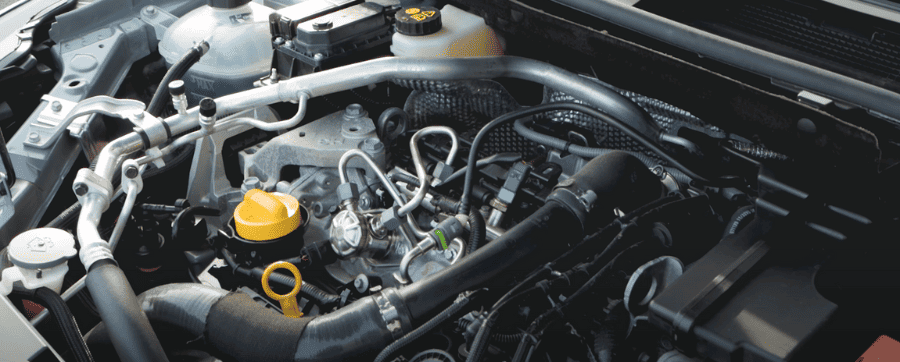
However, we found the CVT automatic experience less satisfying. Starting from a standstill can be jolty, making it a bit slow to accelerate, and requiring careful traffic judgment. Engaging the “Sport” mode helps for quicker overtaking on highways.
While not thrilling, the Qashqai prioritizes family-friendly practicality, which has made it popular in the UK. It offers comfort and style for your A-to-B journeys.
Standard models feature torsion beam rear suspension, but higher-spec versions with 20-inch wheels and all-wheel drive have a multi-link suspension setup. This improves body control, especially in tight turns, thanks to the sturdy side cushions that keep you securely in place despite some body roll.
What is the driving experience like?
The Qashqai’s steering is light, making it easy to navigate city streets, though the turning circle could be tighter for easier parking between cars. The panoramic view monitor and front/rear parking sensors, available with top-tier trims, provide helpful assistance when parking.
For safety, choosing the automatic transmission enables the ProPilot safety tech, including Navi-link, advanced autonomous cruise control that works in busy motorway traffic. This feature is exclusive to the CVT automatic.
If you opt for the manual, you’ll have adaptive cruise control and standard safety features like autonomous emergency braking and blind-spot monitoring. Nissan’s strong safety record means you can trust its safety features.
Which Nissan Qashqai makes the best company car?
The first available hybrid is the 1.3L DIG-T petrol mild hybrid, delivering 138bhp. It behaves similarly to the more potent powertrain but comes at a more affordable price point.
With a 0 to 62 time of 10.2 seconds, it’s respectable for a large SUV. The combined cycle offers a fuel efficiency of 44.7mpg, reducing your visits to the fuel station.
However, for company car considerations, this unit emits 143g/km of CO2, placing it in a higher benefit-in-kind tax band for 2022 to 2023. An option like the Nissan Leaf, which is fully electric with zero emissions, might be worth exploring for lower tax implications.
It’s important to note that the X-Tronic automatic gearbox is only available with the more powerful 156bhp unit, with the manual as a £1,600 saving over the automatic. The manual is fairly responsive.
With the more powerful unit, you can choose between two or four-wheel-drive, though the latter is exclusive to the automatic gearbox. The four-wheel-drive variant achieves 41.2mpg and may be suitable for towing needs, but CO2 emissions can rise to 156g/km, impacting company car considerations.
The two-wheel-drive variant offers three driving modes: “Eco,” optimizing fuel efficiency; “Standard”; and “Sport” for faster acceleration.
The four-wheel-drive variant adds “Snow” and “Off-Road” modes, useful for challenging conditions.
Nissan’s e-power technology uses a 1.5L petrol engine to generate electricity for a lithium-ion battery, powering electric motors on the front axle.
This technology, adapted from the all-electric Leaf, offers superior fuel efficiency and lower CO2 emissions compared to traditional combustion engines. The e-pedal technology, found in the Nissan Leaf, allows for regenerative braking to enhance fuel efficiency.
It’s a great option for those interested in some of the benefits of EV driving without range anxiety or charging infrastructure concerns. For more details, feel free to reach out to our Vehicle Specialists.
Which Nissan Qashqai model is best?
Let’s break down in this Nissan Qashqai review the different trims, including which could be the best for you.
Nissan Qashqai Visia
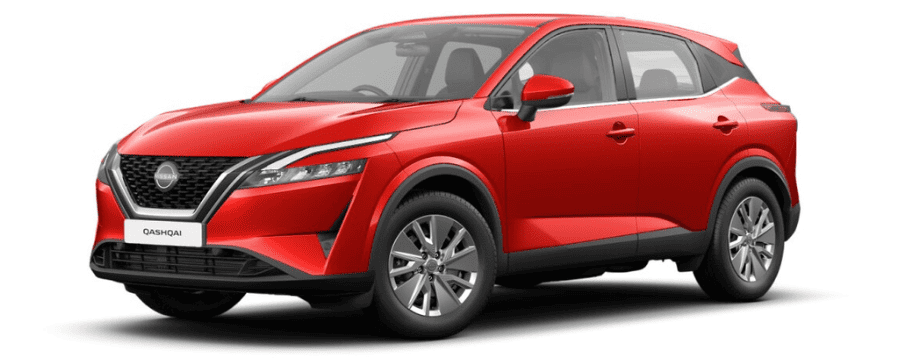
As for trim levels, the entry-level variant is “Visia” and prices start from £24,555. With this trim, you receive a whole host of standard equipment with the Nissan Qashqai.
However, the “Visia” trim includes a shark fin antenna, manual air conditioning, rear parking sensors, a seven-inch driver display behind the steering wheel, Bluetooth, the driving as mentioned above modes, and the smallest 17-inch steel wheels, which could be a benefit if you want your Qashqai to have a smooth ride quality.
Nissan Qashqai Acenta Premium
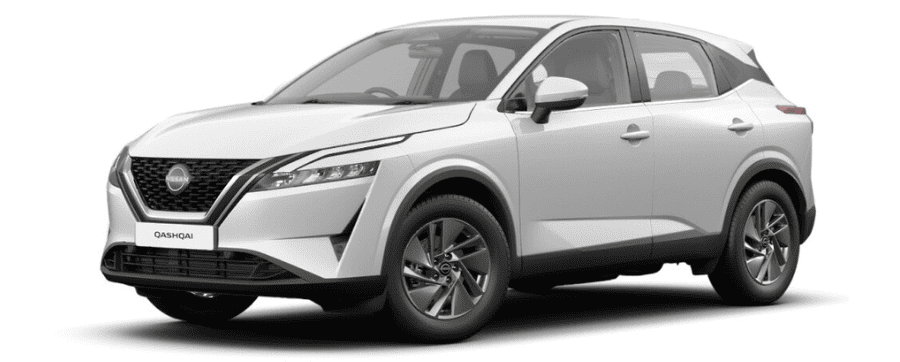
Next up the ladder is “Acenta Premium”, the second of five trims available. Prices start from £27,155 depending on whether you’ve gone for the six-speed manual or X-Tronic automatic transmission.
This variant adds auto-folding door mirrors, a two-way manually-adjustable lumbar support for the driver’s seat, a rear-view camera, Apple CarPlay and Android Auto, and an eight-inch media display in the centre console, meaning you have to go for this trim level to receive any kind of infotainment.
Nissan Qashqai N-Connecta
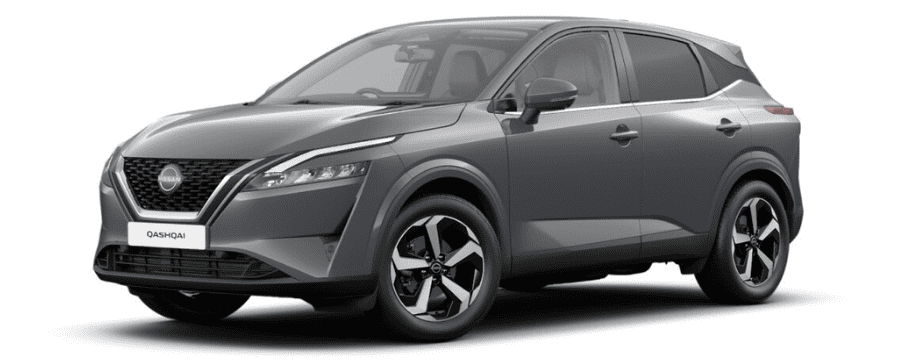
If you want even more tech, go with “N-Connecta“. Prices start from £29,190 and you get larger 18-inch alloy wheels and rear privacy glass.
In terms of tech, you get front parking sensors to complement the rear parking sensors, and around view 360° monitor (which makes parking a breeze), you also get a larger nine-inch media display integrated with the NissanConnect services.
Nissan Qashqai Tekna
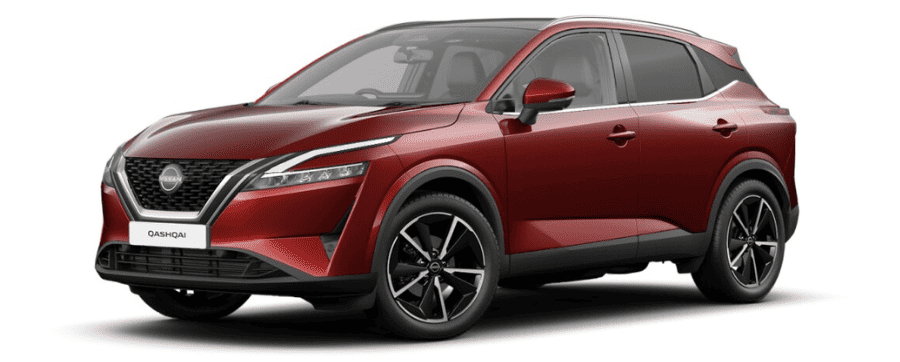
At the top of the range is the “Tekna” trim, starting at £31,865. For an extra £2,675, you get valuable additions: an eight-way electric driver’s seat adjustment, a wireless charging pad, and a power tailgate for convenience.
Tech-wise, there’s a 10.8-inch heads-up display, a larger 12.3-inch driver display, and the heat pack with heated front seats, steering wheel, and windscreen for chilly mornings.
Styling enhancements include 19-inch alloy wheels, ambient lighting, a glass roof with roof rails, and the option for a premium Bose sound system. “Tekna” is our standout trim, offering comprehensive tech at a competitive price compared to rivals.
Nissan Qashqai Tekna+
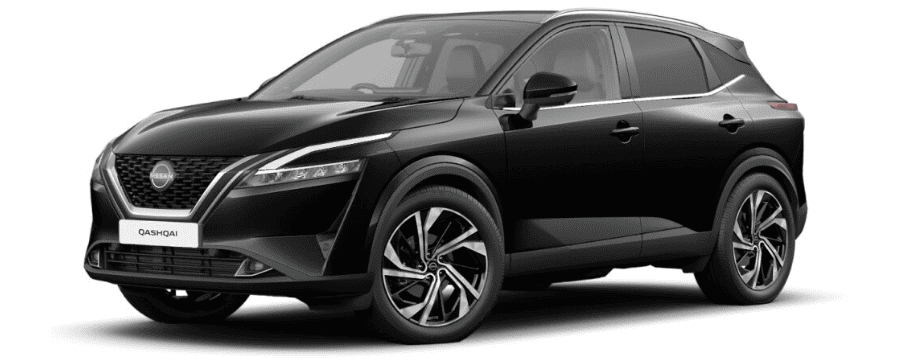
The highest-spec trim level is “Tekna+” and this starts from £35,195, which is quite a significant premium over the previous “Tekna” trim. Unfortunately, it doesn’t justify those extra costs in our opinion.
With this trim, you get the premium Bose sound system as standard and the biggest selling point is the larger 20-inch alloys.
You also get full weight adjustment for the lumbar support and quilted premium leather seat fronts, but is all this worth an additional thousand pounds? We don’t personally think so, but we’ll leave it up to you.
If you want to maximize your specification as much as possible then opt for “Tekna+” and you will benefit from everything previously mentioned.
Nissan doesn’t make it that easy to understand the different trims, so if you’d like to dive into these in a bit more detail, and chat through your options with one of our Vehicle Specialists, we’d be more than happy to find your perfect variant. Please get in touch on 01903 538835 or just click the banner below to book a date or time that works best for you for a quick chat.
Nissan Qashqai review: Should you buy, lease, or finance the new Nissan Qashqai?
As we come to the end of this Nissan Qashqai review, let’s evaluate what we’ve covered so far. The Nissan Qashqai has several compelling reasons to consider. Its elevated driving position provides an excellent view of the road, offering the same advantage it’s known for in the small SUV segment.
It excels in comfort, especially during cruising, providing a smooth and relaxing ride. Inside, you’ll find premium materials and improved tech, creating an intuitive and functional interior.
The safety features are impressive, and higher-spec trims offer excellent practicality, including a height-adjustable boot floor. While this feature impacts overall boot space, you can expand it by folding down the rear seats, making it ideal for family outings or accommodating bikes.
On the downside, the Nissan Qashqai may not excite those seeking a punchy performance; it offers a smooth and relaxing drive instead, emphasizing family-friendly practicality in this review.
The automatic CVT transmission, while smooth, has occasional gear change sensations and starting jolts that could have been refined. With larger wheels on the highest-spec trims, road imperfections are more noticeable, potentially causing discomfort.
Despite these minor drawbacks, the Qashqai is an excellent choice for growing families. If you’re considering it, explore our latest offers on the Nissan Qashqai and connect with our Vehicle Specialists at OSV for personalized advice. Visit our YouTube channel for official OSV Car Reviews, including the Nissan Qashqai review, or read our written car reviews if you’re still exploring your options.
Kia e-Niro Review: Which trim should you go for?
- What do you need to know about the Kia e-Niro batteries and motors?
- Is the Kia e-Niro a good company car?
- What are the different Kia e-Niro trims on offer and their prices?
- What should you do next?
Want to switch to electric with the Kia e-Niro, but not sure which battery or trim level to choose? Read this Kia e-Niro review to find out which one will work best for your individual needs.
Winning multiple awards, such as Best Company Car at the 2021 Business Motoring Awards, Best Small Electric Car for Long Distances and Best Electric Small SUV at WhatCar’s 2021 Awards, Kia has certainly made its mark on the electric vehicle market.
But what does each model feature? Which of the batteries should you go for? And which trim is your best option? This Kia e-Niro review will answer any questions you may have.
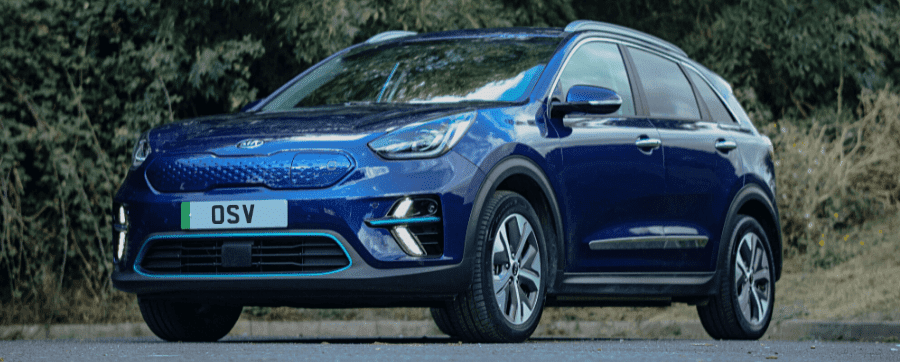
What do you need to know about the Kia e-Niro batteries and motors?
39-Kilowatt-Hour Battery
We’re going to start by talking about the entry-level version 39-kilowatt-hour battery. It’s paired with a 134-brake-horsepower electric motor, delivering 350 Newton metres of torque.
As for top speed, you’re looking at 96 miles per hour so you won’t be breaking any Nürburgring records in this SUV. It can go from 0 to 60 in 9.5 seconds, so it’s not the quickest off the block, but it’s a little faster than the Citroën ë-C4.
If you want to eke as much performance as possible out of the e-Niro, you will need to consider the higher-level variant, which we’ll talk about in a moment.
Both of the e-Niro models are one-speed auto and while this doesn’t sound like much, the transmission is fantastic. As soon as you put your foot down on the accelerator, that performance is immediate and it’s very exhilarating.
While Kia claims an official range of 180 miles, realistically, you’ll be able to travel around 140 miles on a single charge.
This does, of course, depend on how you drive on a day-to-day basis. Kia also claims a city driving range of 251 miles, and while this does sound rather impressive, this is more for people who live in a congested city and don’t regularly drive above 30 MPH.
You can squeeze quite a lot of range out of this vehicle but you will need to consider whether you want a vehicle of this size to drive around the city, perhaps a city car or another vehicle such as the Honda e or the Renault ZOE would be more suitable for your needs.
How fast will this car charge?
The charging cables will plug into your mains, 230-volt unit, and when you do, this e-Niro will top up from 0 to 100 in a whopping 18 hours.
It’s not the quickest in the world but if you’re having a lazy weekend and you just want the car to get up to 100% battery by the time you start work on Monday, this is an absolutely fine solution.
However, if you do need it to charge a bit faster than 18 hours, then you can install a 7.2-kilowatt AC wall box and this will charge the car from 0 to 100 in 6 hours and 10 minutes so perfect for when you come back from work and plug it in – it will be at full battery by the time you set off again the next morning.
If you’re travelling up the country and you get a bit of range anxiety, perhaps it’s dipping below what you expected and you need to pull over and top that battery up, you can do it from a 50-kilowatt DC charger and that will top up the battery from 0 to 80% in just 57 minutes, so enough time to just grab a magazine or grab some lunch and wait for the car to recharge.
Alternatively, you can plug it into a 100-kilowatt DC charger, it’ll do it slightly faster, in 54 minutes. As you can tell, you’ve got quite a few options when it comes to charging the Kia e-Niro and it all depends on how quickly you want to charge it.
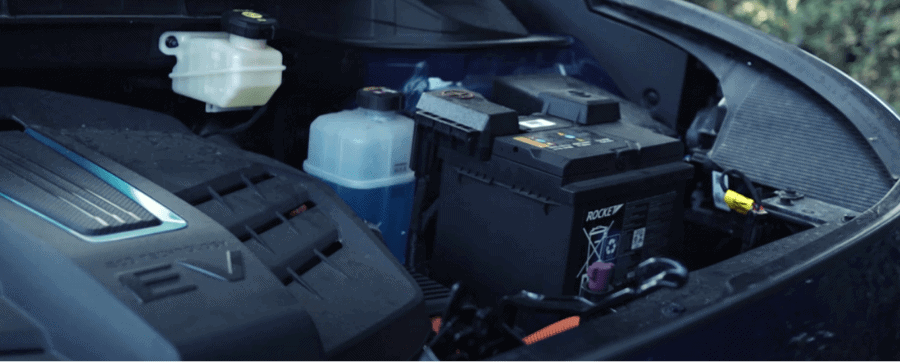
64-Kilowatt-Hour Battery
Next up, is the 64-kilowatt-hour battery variant. It’s paired with a 201-brake-horsepower electric motor, producing 395-Newton-meters of torque and as such, performance is improved: top speed now reaches 104MPH and it can go from 0 to 60 in 7.5 seconds.
That performance is immediately sent to those front wheels, making it feel very rapid for a car of this size. This is absolutely the version to go for if you want to get the most performance possible out of the e-Niro.
Now, this is where things get interesting: Kia claims a maximum electric range of a whopping 282 miles, which is incredibly impressive for an electric car.
It outperforms the Škoda ENYAQ iV 60 and the Renault ZOE. Kia has stated a city range of 382 miles, so if you’re driving this quite sensibly throughout the city, you won’t need to plug it in very often, especially when using the regenerative braking to pump some extra juice back into the battery.
So, if you’re looking for a small electric SUV with one of the best ranges out there in 2022, the Kia e-Niro is simply a fantastic choice.
A larger battery unfortunately does mean slower charging times: using the 230-volt AC socket, you’ll get a 0 to 100 slow charge in 29 hours, hopefully, you won’t need your car for a while because it’s going to be stuck in your garage charging away.
If you do need to charge just a bit faster than that, you can plug it into a 7.2-kilowatt AC charger and it will charge from 0 to 100% in about nine and a half hours so not too bad, just make sure to plug it in as soon as you get home from work.
When you’re travelling up the country, a DC 50-kilowatt charger will achieve a 0 to 80 charging time of around one hour and 15 minutes, so a little bit longer than the 39-kilowatt-hour battery variant but still enough time to grab some lunch and have a bit of a chill out at the motorway service station.
From a 100-kilowatt-hour charger, it will take 54 minutes just like the last model, again, pretty quick for charging an electric car.

Is the Kia e-Niro a good company car?
It has no exhaust as it’s fully electric, so it emits zero grams per kilometre of CO2.
That puts it firmly in the 1% benefit-in-kind tax bracket for 2021-2022, so you’re already taking advantage of some significant savings in terms of company car tax.
This is a very cheap car to run: you’ll already be taking advantage of the fact that recharging is cheaper than refuelling, and if you charge at night, you can take advantage of discounted rates as well.
You’ll also be exempt from congestion charges in London, as well as Clean Air Zones in other cities across the UK and you won’t have to pay any road tax.
All these benefits add up to what is quite a significant saving over time – although the initial outlay may be higher than a petrol or diesel car, you do reap the rewards quite early on.
If you’d like to find out a bit more about the benefits of switching to electric, check out OSV’s Electric Vehicle Hub, as it has all the information you need, plus offers on the latest electric cars.
Alternatively, you can check out our article on the (plug-) ins and outs of electric cars. If you’d like to explore your options further with one of our vehicle specialists, we’ll be happy to tell you a little bit more about each of those power trims to help you find the one that best meets your particular needs.
Perhaps, you want to find the best balance between performance and range. We can help you do that, so do get in touch on 01903 538835 or just click the banner below to book your free consultation today.

What are the different Kia e-Niro trims on offer and their prices?
Kia e-Niro 2 Trim
As for trim levels, it starts with the entry-level “2” variant. That starts from around £32,895.
Highlights of this trim include the eight-inch touchscreen display in the centre console, a seven-inch digital instrument cluster behind the steering wheel, Apple CarPlay, Android Auto, and smart cruise control comes as standard.
You get a wealth of equipment as standard with this entry-level trim.
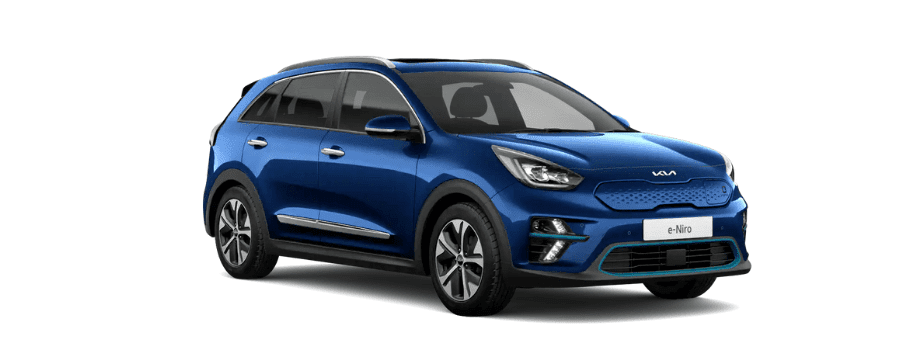
Kia e-Niro 3 Trim
The next trim is the “3” variant and it starts from £37,400. With this, you get the larger 10.25-inch central display, a wireless phone charger, and black leather upholstery on the now-heated seats.
You will need to weigh up if these extra little bits and bobs are worth the significant premium over the previous variant.
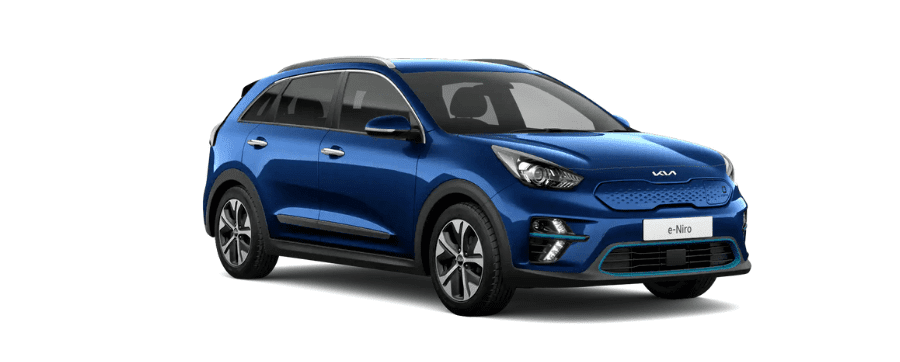
Kia e-Niro 4+ Trim
Lastly, we’ve got the “4+” variant which starts from £39,695. This is the model we chose for our car review, meaning if you watch our video and you love pretty much everything you see, it’s the one to go for.
Highlights include an eight-speaker JBL sound system, the rear parking sensors are now complemented by front parking sensors, an 11-kilowatt 3-phase charger, and ventilated seats which are well-suited for those hot summer days.
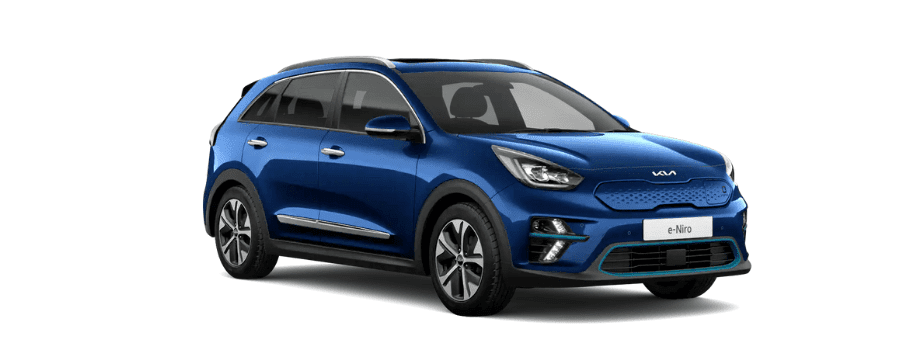
What should you do next?
Whether you’re looking to use a Kia e-Niro as a company car or for personal use, one of these models will surely cater to your needs.
Hopefully, with the help of this Kia e-Niro review, you’re ready to make an informed decision on which model will be your new EV.
But if you’d like to find out more about what this car offers, check out our full Kia e-Niro review article. Alternatively, you can also check out our detailed Kia e-Niro review video on our YouTube channel.

However, if you would like to discuss your options, make sure to call us at 01903 538 835 or click the banner below to arrange a free consultation with one of our Vehicle Specialists.

Is Kia e-Niro still the BEST Electric SUV?
- What is the exterior design of the Kia e-Niro like?
- How does the interior of the Kia e-Niro feel? What tech is on offer?
- What is the Kia e-Niro like on the road?
- What is our verdict on the Kia e-Niro?
Worried about how the 2030 petrol and diesel ban will affect you and your family? Maybe you’re thinking about going electric with a practical small SUV? The Kia e-Niro could be the car that convinces you to make that switch.
When the all-electric version of Kia’s popular SUV launched back in 2018, it shook up the electric vehicle segment. This is a car that offers the extended range of a Tesla for a fraction of the cost, all in a body style that’s suitable for a growing family.
As such, it’s pretty unsurprising that it’s been the recipient of numerous awards over the years. For example, it was named “Crossover of the Year” at the UK Car of the Year awards as well as “Best Small Electric Car” at WhatCar’s 2021 ceremony.
All the high praise is very beneficial for the e-Niro as it helps it stand out in a very competitive segment. As such, it faces an incredible amount of competition, not only from other electric SUVs but electric cars in general, of all shapes and sizes, vying to be the first car customers choose to make that all-important switch to electric with.
On the SUV side of things, its biggest competitors are the Citroën ë-C4, the Peugeot e-2008 and the Hyundai KONA Electric, if you want to stick with a Korean branding model. They’re all significant rivals to the Kia e-Niro.
Then, you’ve got the hatchback EVs. These are generally more affordable than their SUV brethren and include the Nissan Leaf, the Renault ZOE and more recently, the Volkswagen ID.3.
If you’re thinking about going electric with your next car, will the e-Niro fit your needs perfectly or should you consider one of its competitors? We’re going to help you decide by giving you a comprehensive rundown of this EV.

What is the exterior design of the Kia e-Niro like?
Starting with the exterior, we chose Yacht Blue for our e-Niro review. Our presenter, Tom, usually isn’t keen on blue cars but found this one surprisingly appealing, highlighting its design features.
Yacht Blue is a premium colour, costing more than the standard Silky Silver. Other premium options include Midnight Black, White Pale, and Interstellar Grey.
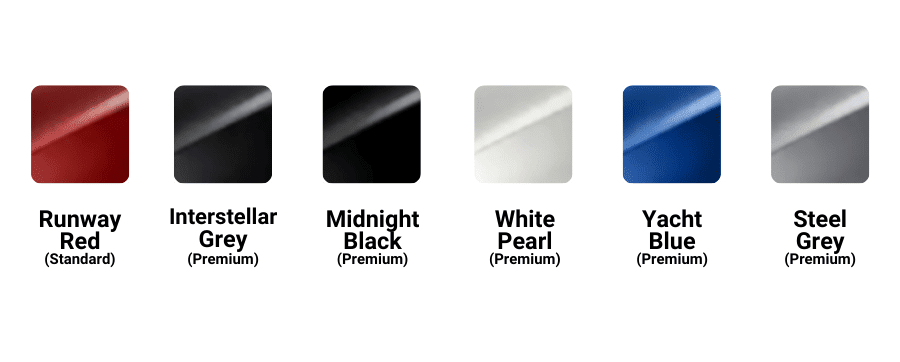

The e-Niro boasts chrome-coated door handles, which, while shiny, tend to show fingerprints. The SUV features electrically adjustable and heated door mirrors that fold in when locked and out when unlocked.
They also light up when overtaking and sending notifications. Roof rails are handy for trips, and it comes with 17-inch alloy wheels (not upgradable).
The wheelbase is 2851mm, providing extra cabin space. The width is 1,805mm, making it not too large but still convenient in tight spaces. The height is 1560mm.
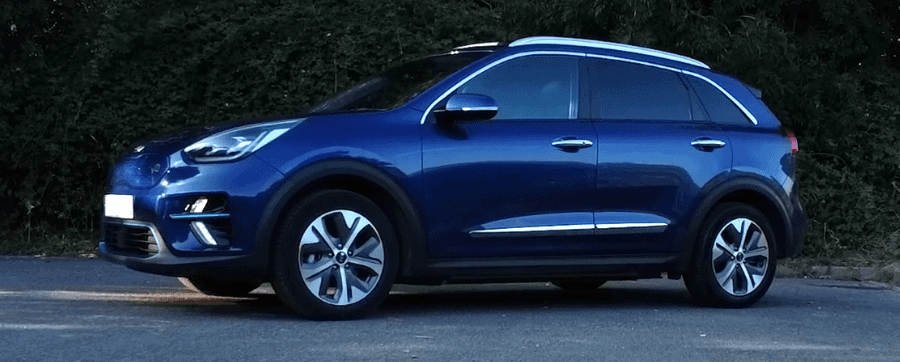
The e-Niro’s front design includes “solar glass” on the windscreen and windows to reduce heat buildup and intense sunlight. It handles sunlight well, even without needing to pull down the mirror.
LED daytime running lights and rear combination lamps come standard on all trims. We opted for the top-spec “4+” trim with bright LED headlights featuring automatic mode for convenience. Unlike traditional cars, there’s no grille; instead, a large intake cools the battery.
The charging point easily pops out from the front plastic strip, unique among electric cars. The turquoise strips on the lower front add vibrancy and personality.
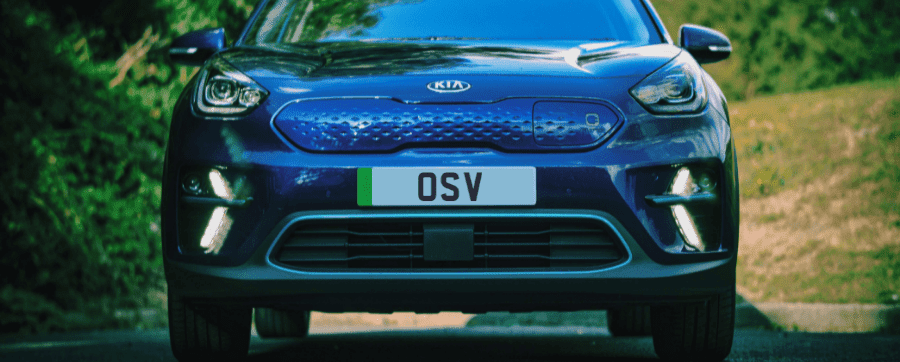
At the rear, the e-Niro features rear privacy glass on the boot lid. However, it lacks an automatic tailgate, requiring manual operation.
With 451 litres of luggage space, it surpasses both the standard e-Niro and the Nissan Qashqai by 70 and 20 litres, respectively.
The square-shaped boot offers easy accommodation for items of varying sizes, with a low lip for convenient loading. It’s spacious enough for sports equipment like skis and golf clubs when necessary.
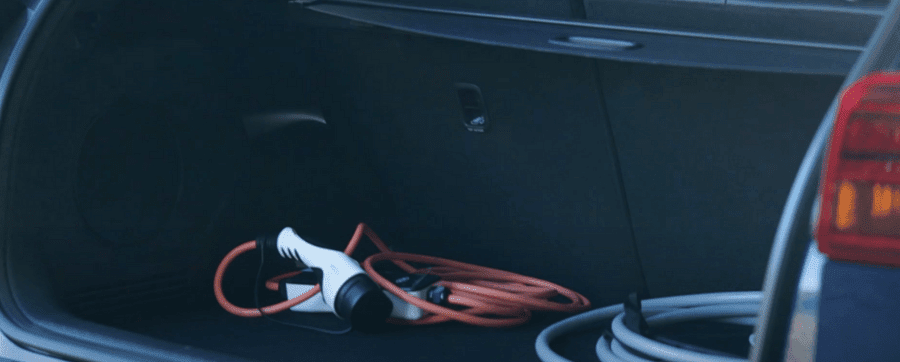
Additional features include convenient covers with hooks to secure rolling objects in the boot. Under the boot floor, there’s space, ideal for charging cables or valuables.
Notably, not all electric vehicles offer this feature. If more space is needed, the rear seats fold down in a 60/40 arrangement, providing a total of 1,405 litres of space.
Unfortunately, a 40/20/40 arrangement isn’t available, so consider alternative solutions for bulky items.
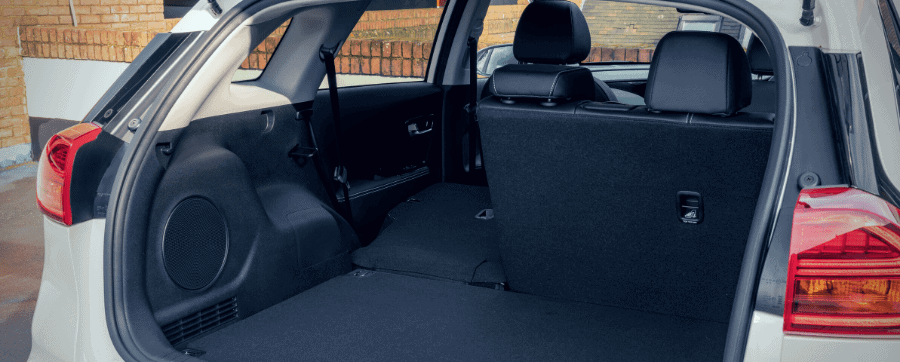
If the e-Niro is piquing your interest and you’d like a little bit more information, get in touch with one of OSV’s vehicle specialists!
They will be more than happy to help, just click the banner below to book your free consultation today or you can just pick up a phone and call us right now on 01903 538 835.

How does the interior feel? What tech is on offer?
Inside the e-Niro, the “2” trim offers Black Part Cloth with leather upholstery, while the “3” and “4+” trims feature black leather seats with premium white stitching reminiscent of BMW.
The interior feels both luxurious and comfortable. However, upholstery choices are limited to these options. All trims come with power-adjustable lumbar support for the driver’s seat, a commendable standard feature.
The “2” trim has manual seat adjustment, while the “3” and “4+” trims offer eight-way power adjustability for a customized driving position. Ample headroom and generous legroom are provided, and heated seats are included in the “3” and “4+” trims for added comfort during cold weather.
The interior boasts a heated steering wheel (available on “3” and “4+” trims) and an auto-dimming rear-view mirror. You’ll find a 12-volt socket below the climate controls and two USB ports for device charging, though they’re not USB-C.
The centre compartment features two cup holders and extra storage, including another USB port. Side bins offer additional storage space. The cabin impresses with numerous cubby holes and ample storage options.
We added a panoramic sunroof for sunlight, and there’s a sunglasses compartment, a rare find in newer cars. A standard glove box provides storage for manuals and other items.
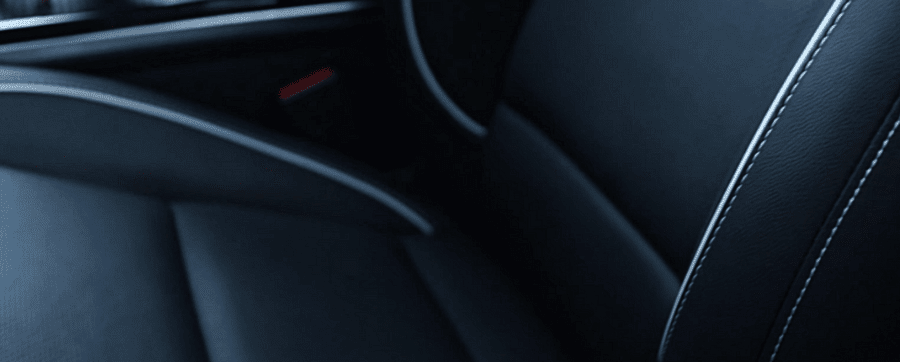
The dashboard design, though minimalist, complements the cabin nicely. While we spotted some cost-effective materials, we weren’t bothered given it’s a Kia, not a BMW.
We especially liked the glossy material in the infotainment setup and digital cockpit. A standout feature is the abundance of physical buttons for climate, radio, and screen controls, a welcome departure from the touch-sensitive buttons in many new cars.
The “2” trim features an 8-inch touchscreen with DAB radio, Bluetooth, and standard Apple CarPlay and Android Auto. Opting for the “3” and “4+” trims gives you a larger 10.25-inch display. While the infotainment screen takes a bit to start up, it’s user-friendly, intuitive, and responsive with clear graphics. Unfortunately, there’s no rotary dial like in BMWs and MINIs; you’ll need to tap the screen, which may accumulate fingerprints and require occasional cleaning.
The “3” and “4+” trims include a wireless charging pad. The “2” and “3” trims offer a decent six-speaker audio system suitable for everyday use. However, for audiophiles seeking higher fidelity, the “4+” trim boasts an eight-speaker JBL sound system. Additionally, there’s a 7-inch digital cockpit display behind the steering wheel for essential driving information, easily adjustable using buttons on the steering wheel.
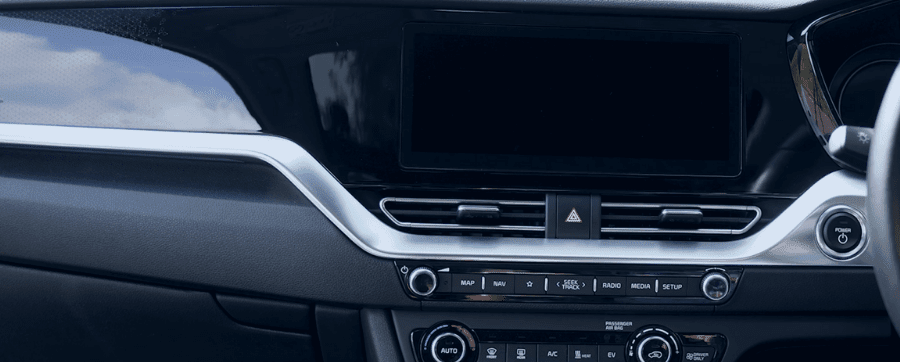
In the rear of the e-Niro, headroom and legroom surpass the Peugeot e-2008 and Hyundai IONIQ Electric. The sloping roof offers ample headroom, and tall passengers won’t touch the roof lining.
Legroom is good, but the raised floor due to the battery can make sitting feel slightly awkward—a common feature in electric vehicles.
Despite the central armrest with cup holders, the rear seats lack sliding or reclining options and can’t fold for additional cargo space. While reasonably comfortable, it could be more practical.
Share your thoughts on the interior in the comments, and for more information, contact our vehicle specialists at 01903 538835 or visit our EV Hub for comprehensive electric vehicle details.

What is it like on the road?
Driving the e-Niro is a pleasant and comfortable experience. The driver’s seat offers excellent adjustability, allowing for a commanding view of the road.
The seats are comfortable, and the electric motor’s quiet operation eliminates the noise associated with combustion engines. The subtle hum when accelerating takes some getting used to but isn’t bothersome.
Enabling the VESS (Virtual Engine Sound System) adds a nostalgic, electric ambiance to the drive, reminiscent of Disneyworld’s monorail or Epcot’s test track ride—a positive aspect of this car’s electric character.

Let’s talk about regenerative braking. You can adjust its intensity with the switches on the steering wheel, offering three levels. When you lift off the accelerator, power goes back into the battery, slowing the car.
At level 3, you can essentially drive using just the accelerator, lifting off to brake. While it may seem daunting at first, it provides a convenient and relaxing driving experience.
What is our verdict on the Kia e-Niro?
Considering a Kia e-Niro? If you want a compact yet spacious electric SUV with an impressive range, great standard features, and awards to its name, it’s a strong choice.
The 282-mile range with the 64-kilowatt-hour battery is remarkable. The e-Niro stands out as one of the best electric SUVs available, ideal for families who want range assurance and Kia’s reliable reputation. For more on trims and models, check our Kia e-Niro models article.
To get the ball rolling on your brand-new Kia e-Niro, book a free consultation with one of OSV’s vehicle specialists by clicking the banner below or just grab your phone and give us a call on 01903 538 835 and we’d be more than happy to help you get behind the wheel of this fantastic electric vehicle.
Make sure to check out our Kia e-Niro car review video if you’d like to see it in action, head over to our list of official OSV Car Reviews to consider your perfect vehicle and subscribe to our YouTube channel for even more motoring content.

Citroën e-C4 Review: Electrifying Comfort?
- What does the interior of the Citroën e-C4 offer?
- What tech does it offer?
- How is the Citroën’s rear space?
- How is the Citroën e-C4’s exterior styled?
- How big is the boot on a Citroën e-C4?
- How was our Citroën e-C4 test drive?
- What are the Citroën e-C4’s specifications?
- What is the electric mile range?
- How long does it take to charge?
- What Citroën e-C4 trims are available?
- Should you buy, lease, or finance a Citroën e-C4?
Looking for an electric family car? Meet the Citroën e-C4, the electrified version of the popular C4 Coupe SUV. It’s part of the growing trend of electric SUVs. Competing with models like the Peugeot e-2008 and Kia e-Niro, as well as hatchbacks like the Nissan Leaf and Volkswagen ID.3, what sets the e-C4 apart?
This car shines with exceptional cabin comfort, advanced tech, practicality, a good electric range, and a remarkably smooth, quiet ride. If you seek these qualities in your an electric car, the e-C4 could be the perfect fit.
What does the interior of the Citroën e-C4 offer?
Our initial impression of the Citroën e-C4 was highly positive. The interior exudes a premium and plush feel, showcasing excellent build quality. In contrast, the Volkswagen ID.3 disappoints with its abundance of cheap, hard plastics.
The e-C4 boasts a cohesive interior with a high-quality dashboard material that extends throughout the cabin. While it leans towards a consistent design, it complements the central display beautifully.
Gloss black surrounds enhance the infotainment screen, and silver accents grace the air vents. Citroën’s interior design here takes inspiration from Mercedes and BMW, resulting in a fantastic outcome.
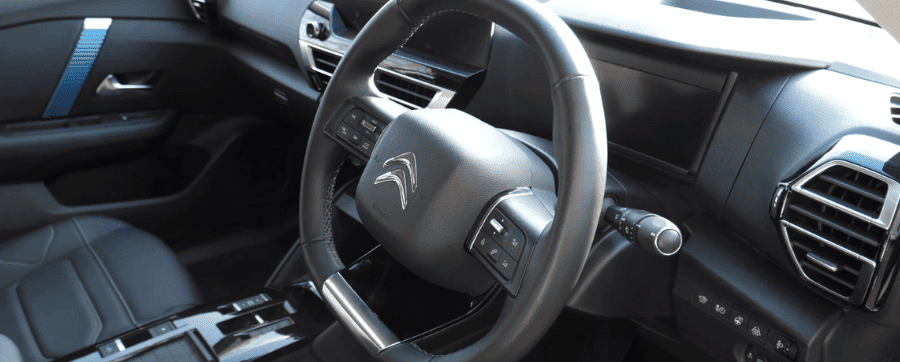
Citroën’s seats offer standard lumbar support across the range, ensuring comfort for long motorway journeys. While adjustability is ample, there’s no electric memory seat option.
Instead, you’ll find manual levers on the right side of the seat to control height, slide, and recline. It’s straightforward to find your perfect driving position.
However, the wide side pillars leading to the roof can make the front feel a bit cramped, though headroom remains sufficient.
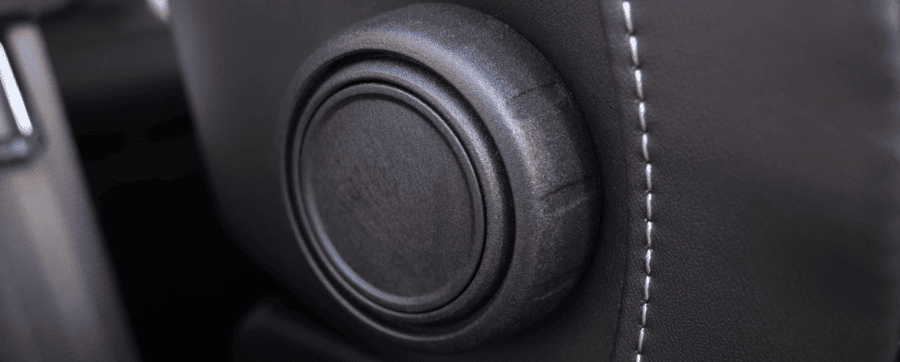
What tech does the Citroën e-C4 come with?
The Citroën e-C4 features a 10-inch HD touchscreen with Bluetooth, DAB radio, and standard Apple CarPlay and Android Auto. If you prefer, you can mirror your smartphone apps on the screen.
While there’s some slight input lag, it’s a significant improvement from previous models. The software is well-organized and user-friendly.
Additionally, the elevated dashboard display is easy to see while driving. You can charge your smartphone wirelessly or through USB-C and standard USB ports, offering great convenience.
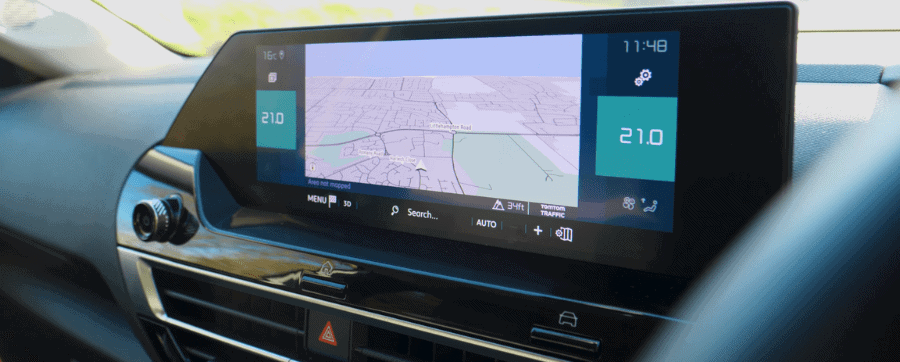
We configured the Citroën e-C4 with the optional heads-up display. This pops up when you turn the car on and it projects the speed and speed limit directly in front of the driver, which is handy.
However, if you don’t want to configure the vehicle with this display, you do get a driver display behind the steering wheel that shows your speed, mileage left on the battery, and the selected drive mode.
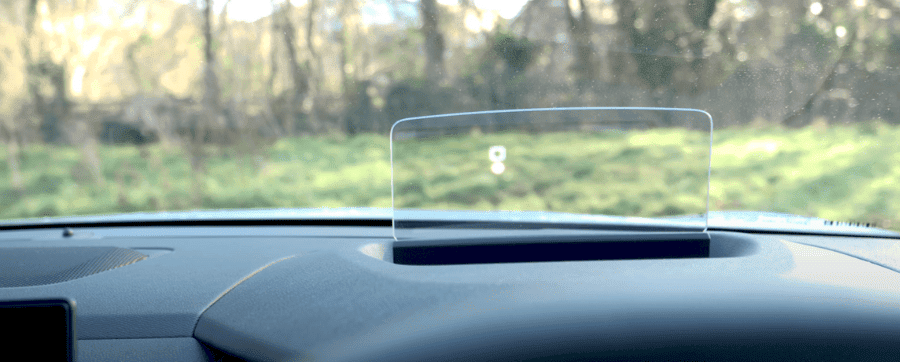
Inside, we truly appreciate the physical climate control buttons. They’re a preferred choice over touch-sensitive controls found in the Volkswagen ID.3 or integrated infotainment screen buttons like the Citroen C3 Aircross. If you’re interested in other Citroën models, check out our C3 Aircross review.
Additionally, there are handy storage cubbies throughout the cabin, including one with a 12-volt socket for your smartphone. Hidden cupholders slide under the front seats, and the glove box offers standard size and decent storage.
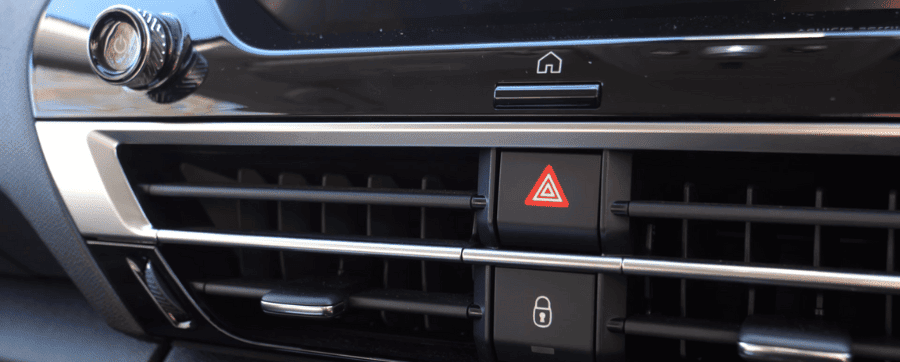
How is the Citroën e-C4’s rear space?
The rear space in the Citroën e-C4 is decent, offering sufficient legroom and generous headroom. However, the middle seat is slightly elevated due to the battery underneath, resulting in compromised headroom and a less comfortable experience. We recommend it for short journeys only.
We were also disappointed by the absence of a sliding rear bench, a practical feature found in the Citroën C3 Aircross. This addition could enhance the e-C4’s versatility. Otherwise, the rear space is standard and functional.
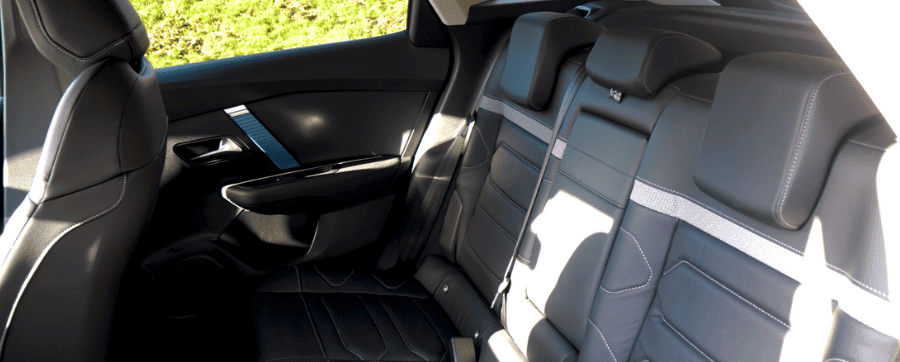
Other features in the rear of the cabin include a pouch in front of the rear seats, perfect for an iPad or magazines, you also get your own climate controls which allow you to adjust the intensity of the airflow, and a couple of USB ports.
Also, if there isn’t a middle passenger, you can fold part of the middle seat down, providing you with a couple of cup holders. Overall, we were pretty impressed with the back.
How is the Citroen e-C4’s exterior styled?
Let’s begin with the front end of the Citroën e-C4’s exterior design. LED headlights are standard on all trims, accompanied by striking V-shaped daytime running lights.
These lights also feature a charming “welcome and goodbye” function, adding personality.
The front lacks a traditional grille, typical for electric cars. Instead, it has a small air intake at the top and a larger one at the bottom for battery cooling.
The only drawback we noticed was the two large indents on the bonnet. Nevertheless, overall, it’s a sleek and uncomplicated design, making it one of Citroën’s best-looking models currently available.
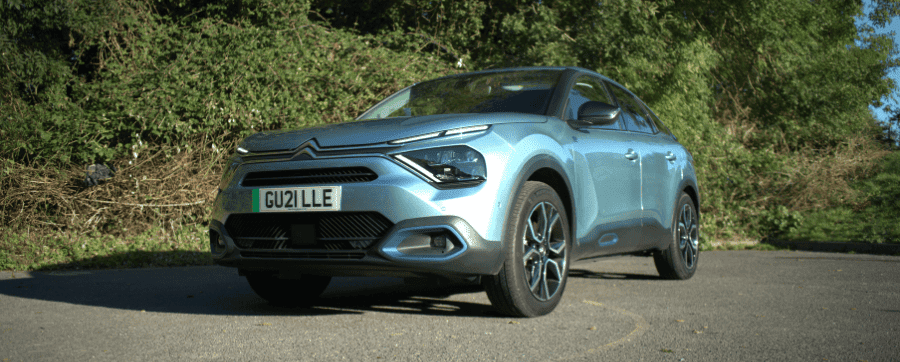
As for the Citroën e-C4’s wheels, you’ll receive 18-inch CROSSLIGHT diamond-cut alloys.
You get these regardless of which e-C4 trim level you opt for and they look fantastic as they nicely complement the rest of the exterior design.
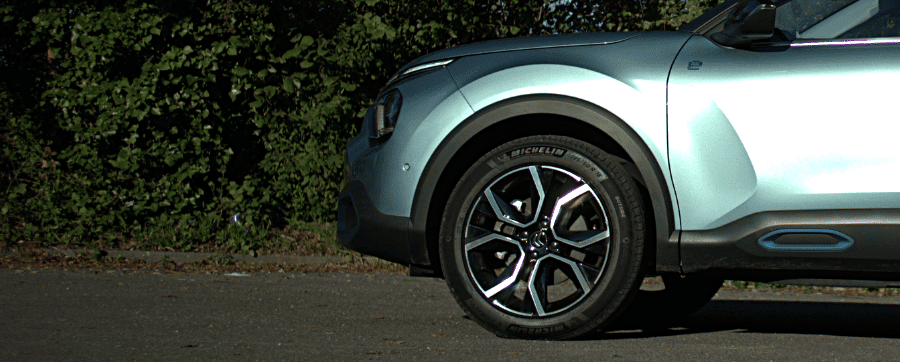
Just in case you need reminding that it’s an electric car, you have some e-badging near the wing mirrors. Speaking of which, the body-coloured door mirrors fold electronically inwards when you lock the car and outwards again when you unlock it.
They also feature indicators on the side. Sitting nice and flush against the doors are the body-coloured handles, matching the rest of the exterior.
You also get tinted rear glass with the charging flap, just underneath the left rear glass.
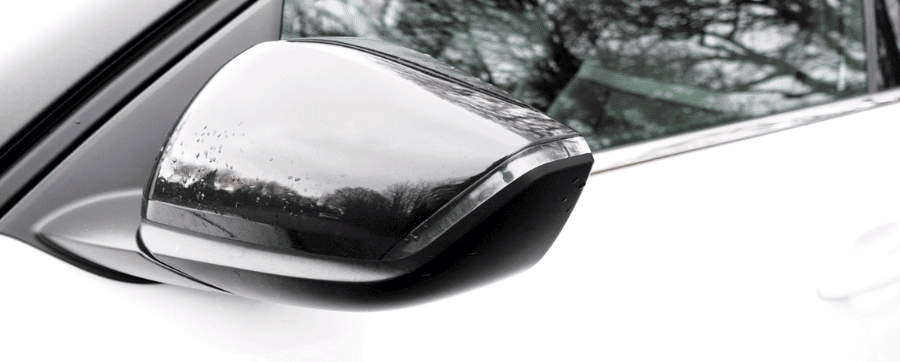
The wheelbase, which is the difference between the front and rear axles, is 2,670 millimetres, which is exactly the same as the standard C4.
In fact, dimensions are pretty much identical to the standard C4, however that car is only five millimetres longer and wider.
It’s nice to see that by going electric with this vehicle, you’re not sacrificing any practicality or space that may be available with the non-electric version.
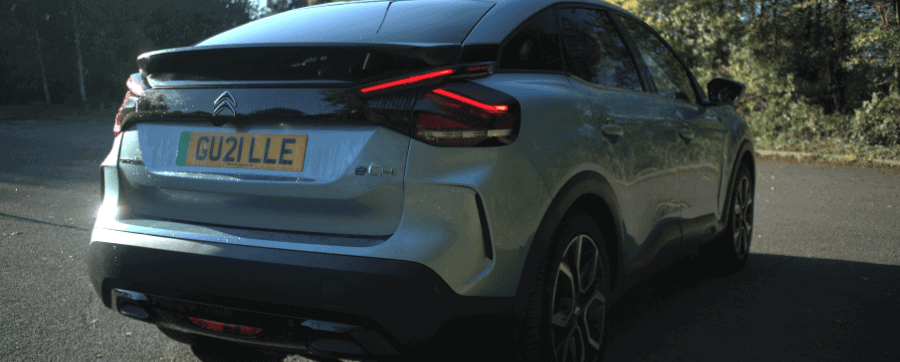
On the rear end of the Citroën e-C4 are the darkened LED light clusters, a slight spoiler (which we were slightly confused at as it’s not a particularly sporty car), and a rear-view camera, hiding just underneath the Citroën logo.
Otherwise, that’s it for the rear. We quite liked the rather angular and aggressive design on the rear end, but let us know what you make of it.
How big is the boot on a Citroën e-C4?
Let’s move on to the boot storage. The Citroën e-C4 offers 380 litres of luggage space, which is around the same size as the Volkswagen ID.3, but 70 litres less than the larger Kia e-Niro, so that’s something to bear in mind.
The loading lip is quite low, making it really easy to load luggage into the back. You can fit about five carry-on luggage underneath the parcel shelf, and by removing the shelf, it gives you some more space to play with.
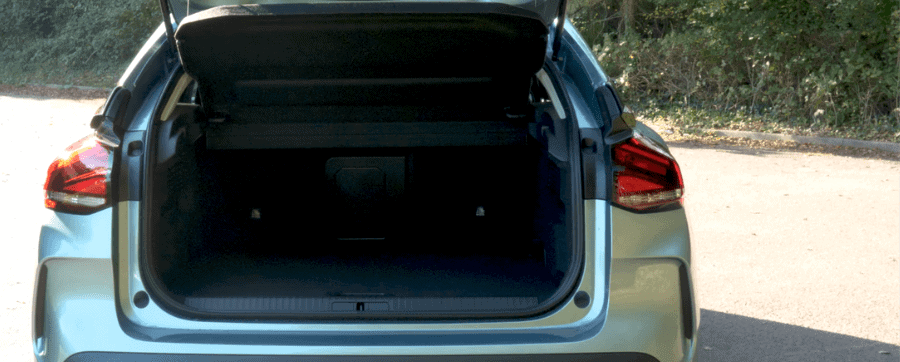
On either side of the boot, are some hooks to attach any objects that like to roll around while on the move, and a storage compartment.
You also get a height-adjustable boot floor, and when it’s completely flat and you fold down one of the rear seats, there’s no awkward gap, making it really easy to slide awkwardly sized items like golf clubs or camping equipment into the rear space.
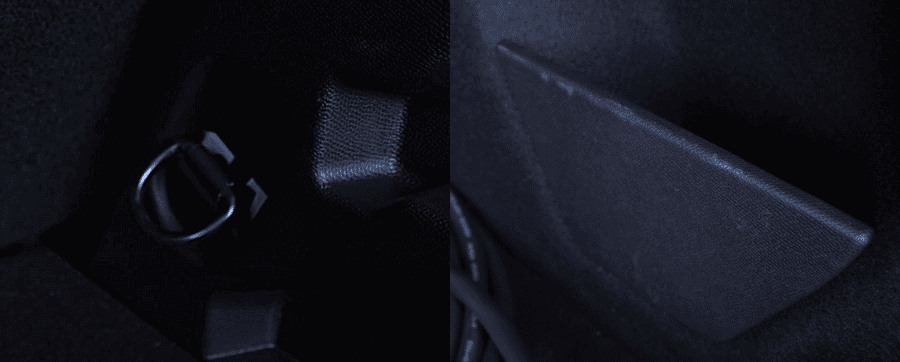
To maximize luggage space, fold down the rear seats, and you’ll have a total of 1,250 liters of room, which we find ample for large suitcases or trips to the tip.
There’s also convenient space beneath the boot floor for your charging cables. Our main gripe is the lack of 40/20/40 rear folding seats, which would allow passing objects into the rear cabin by folding down the middle seat.
However, this is a minor concern. Overall, we’re pleased with the practicality of the boot space.
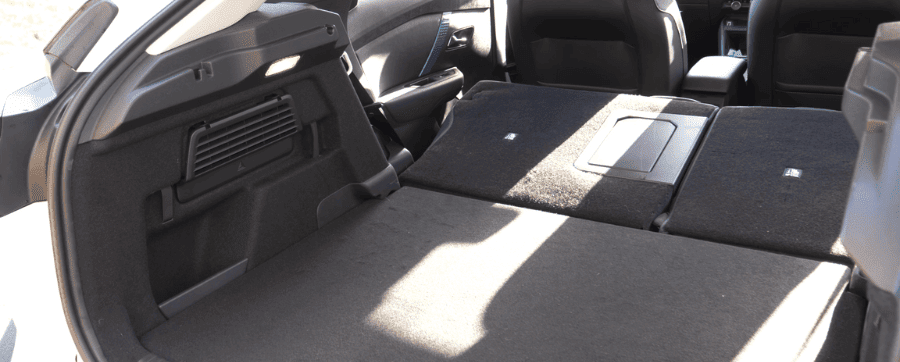
How was our Citroën e-C4 test drive?
The Citroën e-C4 may feel somewhat sluggish compared to other electric cars, especially at speeds of 50 to 70 MPH, which is a downside.
However, it excels in comfortable and quiet city driving at around 30 MPH. While not sporty, it boasts light steering and handles well with good road grip. There’s a bit of body lean in the corners.
Compared to the Volkswagen ID.3 or Kia e-Niro, it’s less agile. If a more dynamic driving experience is a priority, consider those models. Nevertheless, the e-C4 offers a satisfactory driving experience overall.
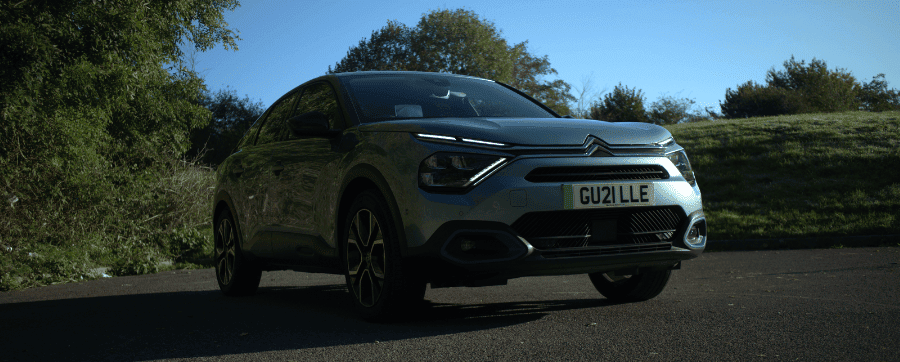
The Citroën e-C4 impresses with exceptional sound insulation, delivering an incredibly quiet ride. This feature is perfect for peaceful trips with tired kids or for maintaining a tranquil atmosphere after a long workday.
As an electric car, it offers regenerative braking, allowing you to recharge the battery while driving. Unlike some electric cars with firm accelerator pedals, the e-C4’s pedals are light, making regenerative braking easy and rewarding.
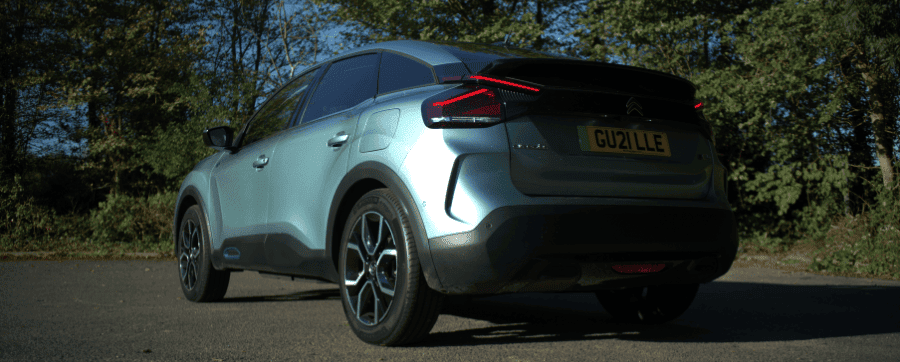
The seating position in the e-C4 is lower than expected, but it gives the car a sporty vibe. However, the angled pillar affects visibility, making it a bit challenging to judge gaps at junctions or roundabouts.
Rear visibility isn’t great either, and while rear parking sensors are standard, it’s not ideal that safety features compensate for design shortcomings.
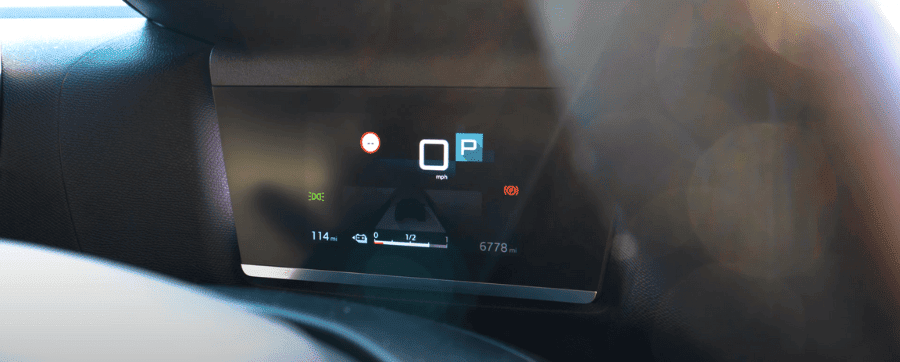
What are the Citroën e-C4’s specifications?
The Citroën e-C4 offers one electric motor and a 50-kilowatt-hour battery, delivering 136hp and 300Nm of torque. It reaches a top speed of 93MPH with a 0 to 60 time of 10 seconds, which, while decent, might disappoint those seeking instant electric acceleration.
Compared to rivals like the Volkswagen ID.3 (6.6 seconds) and Nissan Leaf (around 8 seconds), it falls behind in acceleration. However, it’s important to note that Citroën prioritizes comfort over performance in its design.
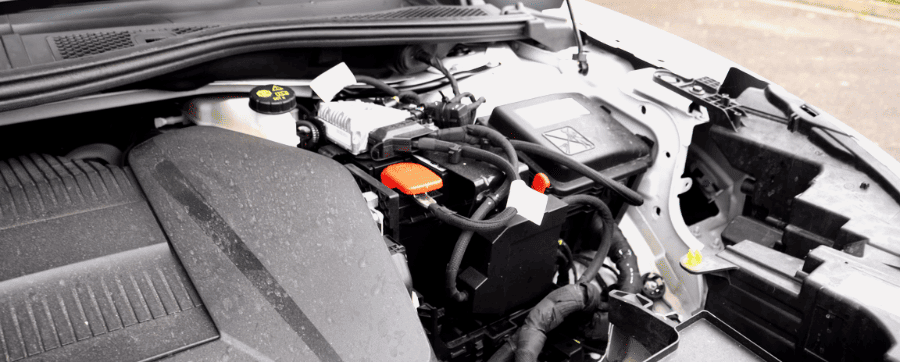
What is the range of a Citroën e-C4?
The e-C4 claims a range of about 217 miles, but real-world conditions like speed, road quality, and weather affect it. In our experience, it showed 200 miles one night but dropped to 144 miles after a cold night.
Generally, expect around 140 miles in real-world driving, sufficient for most daily commutes. Charging at home overnight on cheaper tariffs makes it convenient. Plus, as electric cars emit no CO2, they’re an excellent choice for company cars, offering significant savings.
How long does it take to charge a Citroën e-C4?
Charging the e-C4 from 0 to 100% on a domestic socket takes about 24 hours, the slowest option. We recommend installing a 7-kilowatt-hour home wall box for faster charging.
The included 7.4-kilowatt-hour single-phase charger reduces the time to around 7 and 1/2 hours.
For travel, 100-kilowatt DC chargers at supermarkets and motorway stations provide an 80% charge in just 30 minutes, ideal for a quick break. You can also opt for an 11-kilowatt three-phase charger.
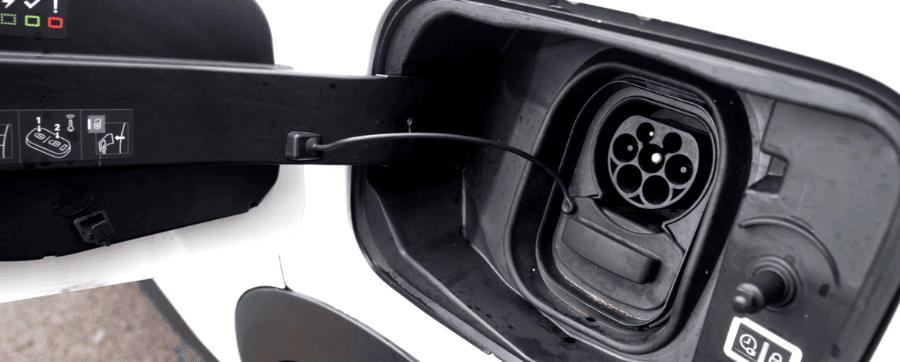
What Citroën e-C4 trims are available?
Sense
The entry-level trim, “Sense” starts at £29,995 and comes well-equipped with features. It includes Glossy Black colour accents, 18-inch Aeroblade alloy wheels, a 10-inch touchscreen with voice commands, Bluetooth, USB, DAB/AM/FM radio, and a wireless mirror screen.
You also get dual-zone automatic air conditioning, heated mirrors, adjustable front seats with lumbar support, and tinted windows with matte black detail.
Safety features like Citroën Smart Pad Support, Connect Box Emergency and Assistance, and the Standard Safety Pack are standard. This pack includes Active Safety Brake, Speed Limit Information, Lane Keeping Assist, Driver Attention Alert, and Forward Collision Warning.
The “Sense” trim offers a great entry-level choice, as higher trims don’t significantly raise the price or add many more features. Ideal for those who don’t need all the extras.
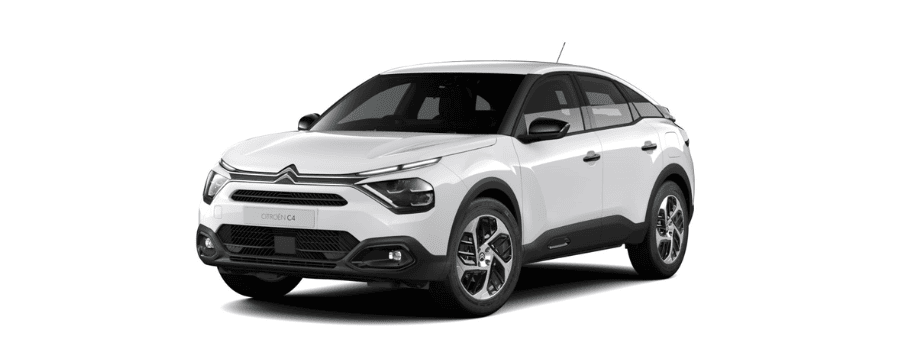
C-Series Edition
Moving up to the “C-Series Edition” at £31,995, you get more for the £2,000 increase. It adds front, rear, and lateral parking sensors with a reversing camera, Blind Spot Detection, Citroen HiFi System, Keyless Entry and Start, heated steering wheel, and Anodised Bronze colour accents.
This trim also includes the Safety Pack Plus as standard, offering Advanced Active Safety Brake, Speed Limit Information, Extended Traffic Sign Recognition, Driver Attention Alert with lane departure detection, and Forward Collision Warning.
It comes with Citroën Connect Nav featuring TomTom Live services, unlike the previous trim where it’s an optional extra. Additionally, you get a Driver’s Head-Up Display, projecting essential driving info onto the road ahead. If you want these extras, this trim is a great choice.
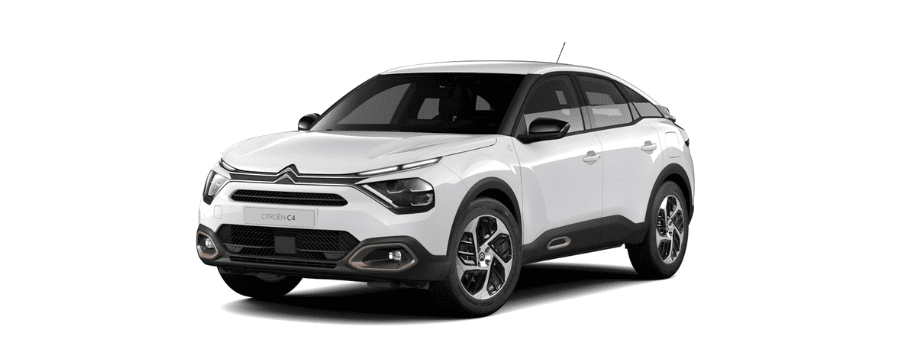
Shine Plus
For the driver seeking top-notch features, “Shine Plus” is the choice, starting at £34,995.
It adds wireless smartphone charging, 18-inch diamond-cut Aeroblade alloy wheels, and an optional driver’s seat with electrically adjustable lumbar support, backrest, height controls, and massage functions (extending to the front passenger seat).
The safety pack is enhanced to the Highway Driver Assist and Safety Pack Plus, featuring Advanced Active Safety Brake, Speed Limit and extended Traffic Sign Recognition, Driver Attention Alert with lane departure detection, and Forward Collision Warning.
If you want the ultimate specification, this trim is the one to go for.
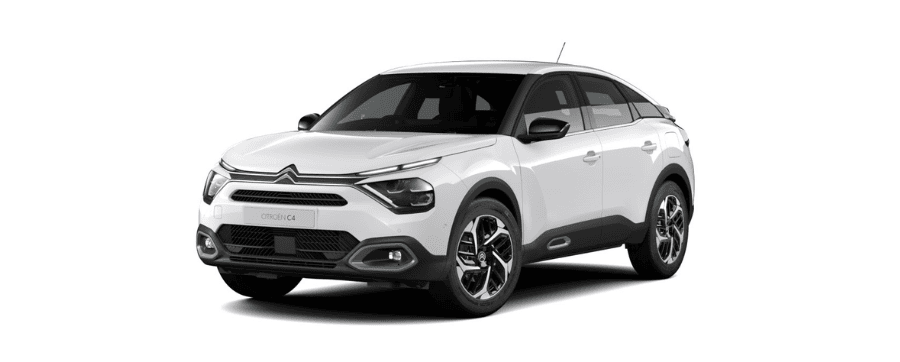
If you have any further questions or want to personalise the Citroën e-C4 to your exact needs, then make sure to get in touch with one of our Vehicle Specialists by calling 01903 538835 or you can click the banner below to book a date or time for a chat at a time that suits you.

Should you buy, lease, or finance a Citroën e-C4?
We absolutely enjoyed our time with this vehicle and found it preferable to the e-Niro. It offers a smooth, leisurely, relaxing, and quiet driving experience. Inside, the cabin is rich with high-quality materials and advanced tech.
Despite its size, the e-C4 accommodates four adults comfortably for long journeys, and it benefits from Citroën’s strong reliability record.
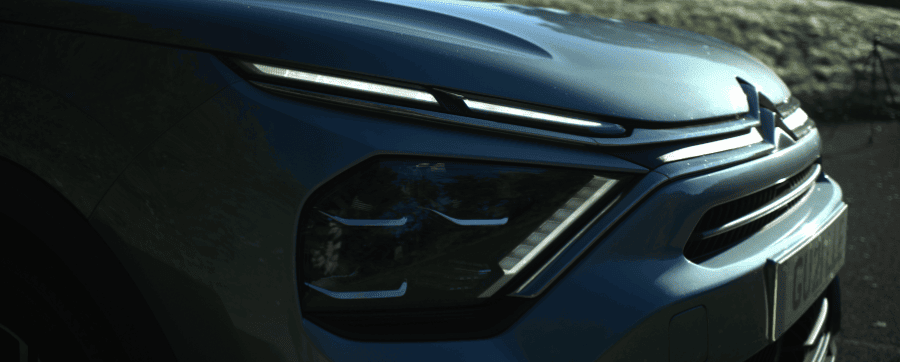
It does have a few downsides though.
The range isn’t as good as the Volkswagen ID.3 or the Kia e-Niro and the acceleration is somewhat disappointing, however, if you flick the car into the “Sport” mode, it is a lot more fun to drive than in the “Normal” mode.
Finally, if we’re being very nit-picky then it could be a bit more spacious.
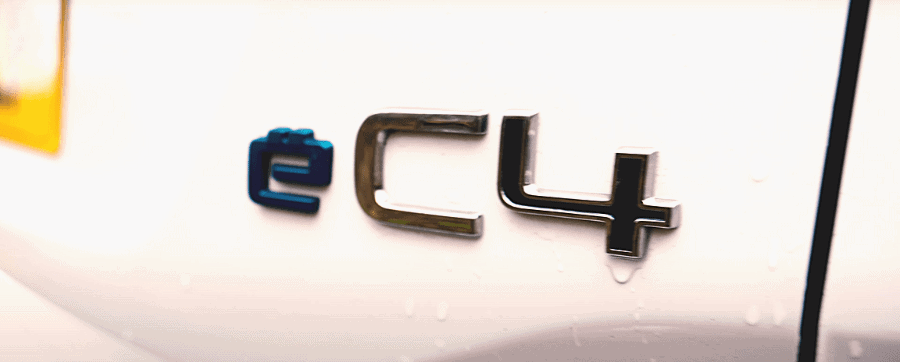
Otherwise, we absolutely loved the Citroën e-C4 and if you’re thinking about making the switch to electric soon, this should definitely be on your list.
To explore the e-C4 more closely with one of OSV’s Vehicle Specialists and get behind the wheel of your brand-new electric car, then get in touch today on 01903 538835 or you can just click the banner below to book a consultation at a time that works for you.
Also, to get a better look at this vehicle, check out our OSV Car Reviews on the Citroën e-C4 on our YouTube channel. Alternatively, you can also read our written car reviews, here on our website.
Nissan Juke Review: Time for a facelift?
- Watch Nissan Juke Review
- What does the Nissan Juke look like?
- How big is the boot of a Nissan Juke?
- What does the Nissan Juke interior offer?
- What tech is on offer with the Nissan Juke?
- What kind of engine does a Nissan Juke have?
- Are Nissan Jukes easy to drive?
- Which Nissan Juke model is best?
- Is the Nissan Juke a reliable car?
- What are the Nissan Juke Pros and Cons?
In need of a spacious, practical, and fun-to-drive SUV with a distinctive personality? Meet the Nissan Juke. Read on for everything you need to know in our official Nissan Juke review.
Launched in the UK in 2019, this second-gen model promised enhanced performance, technology, personality, and a fun driving experience.
The original Juke pioneered the crossover SUV segment, boasting high-riding height, SUV aesthetics, and an appealing design. It sold a million units in Europe, laying the groundwork for today’s competitive small SUV market.
Direct rivals include the Ford Puma, Škoda KAMIQ, and Volkswagen T-Roc, while comfort-focused alternatives encompass the Citroen C3 Aircross, Honda HR-V, and SEAT Arona.
With no shortage of competition, we’ll delve into how the Juke stacks up in this comprehensive review. Discover all you need to know in this Nissan Juke review.
What does the Nissan Juke look like?
Starting with its exterior design, the second-generation Juke features a striking coupé crossover body style with a sporty floating roofline.
In any Juke version, you’ll find five doors, five seats, a roomy cabin, and a decently sized boot, which we’ll discuss later.
Our Car Review model was configured in the “Tekna” trim, one level below the top-spec “Tekna+”. Notable features include 19-inch alloy wheels, an upgrade from the standard 17-inch wheels that get larger as you move up the range.
We also chose the optional two-tone paint, combining Pearl Black for the body with Fuji Red on the roof and door mirrors, enhancing the car’s personality.
Standard paint options offer a choice of 11 colours, and we recommend the two-tone scheme for added flair.
The door mirrors, matched to your chosen body colour, feature integrated turn signals and are heated for fog-free mornings.
They also electronically fold when the car is locked, offering comprehensive functionality. The door handles sit flush with the rear window, a design we appreciate and wish to see more of in the market.
Rear windows are equipped with privacy glass, ideal for shielding young passengers from the sun during naps. A rear spoiler contributes to the sporty appearance, though it doesn’t notably enhance performance.
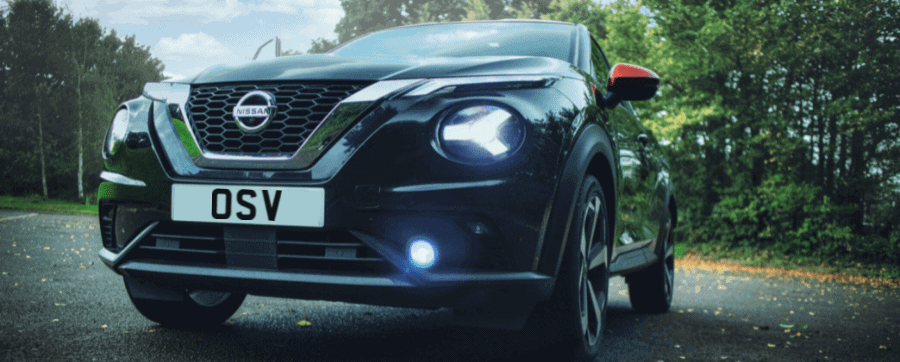
The wheelbase has been extended by 105 millimetres to 2,636 millimetres, creating extra cabin space. The Juke is now 35 millimetres wider (1,800 millimetres) and 75 millimetres longer (4,210 millimetres), giving it a more imposing presence, accentuated by the distinctive honeycomb-designed front grille.
The front features standard full LED headlights in the iconic circular design typical of the Nissan Juke.

How big is the boot?
The Nissan Juke boasts a bold, angular rear design leading to the boot, offering 422 litres of space, a 20% increase from the original model.
While it offers less space than rivals like the Škoda KAMIQ, Volkswagen T-Cross, and Ford Puma, it falls short of the Renault Captur, which provides up to 536 litres.
The square-shaped boot is practical for various items, with a height-adjustable boot floor provided in all trims, reducing loading lip height. Folding down the rear seats is seamless and creates a flat loading surface, useful for larger items.
There’s a hidden deep space beneath the boot floor for additional storage. Folding the rear seats in a 60-40 configuration, with the removal of the parcel shelf, expands the capacity to 1088 litres, quite sufficient for this size of car.
While the rear seats don’t slide like in the Volkswagen T-Cross, it’s a feature more typical of luxury segments in this category.
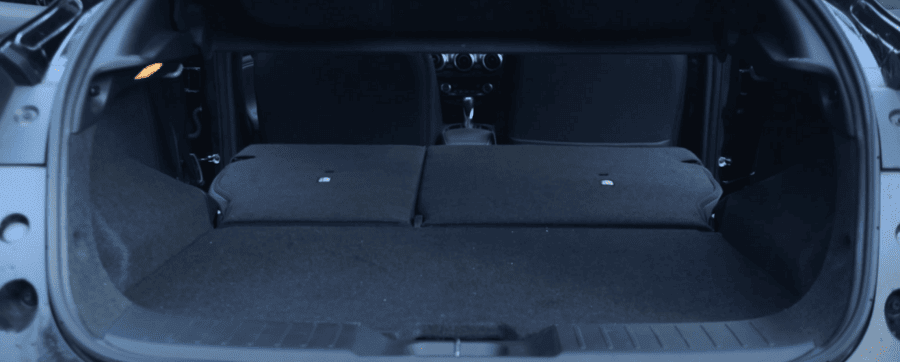
What does the interior offer?
The Nissan Juke’s interior impresses with quality materials, soft-touch surfaces on the dashboard and door trims, and premium Enigma Black leather and Alcantara seats.
Even with mid-range trims like the “Tekna,” you’ll find a comfortable and well-made cabin. While it’s not as luxurious as some premium rivals like the Audi Q2, it offers affordability.
The steering wheel trim choice was less appealing, feeling a bit cheap. However, there’s ample adjustability in the steering wheel and seats to find a comfortable driving position.
The manual seat adjustment, although lacking electric or memory functions, is easy to use. Tall drivers will appreciate the generous legroom.
The Juke’s elevated seating provides a commanding road view, although the windscreen size could be larger. Nevertheless, small pillars and large door mirrors enhance visibility for parking and navigating tight spots.
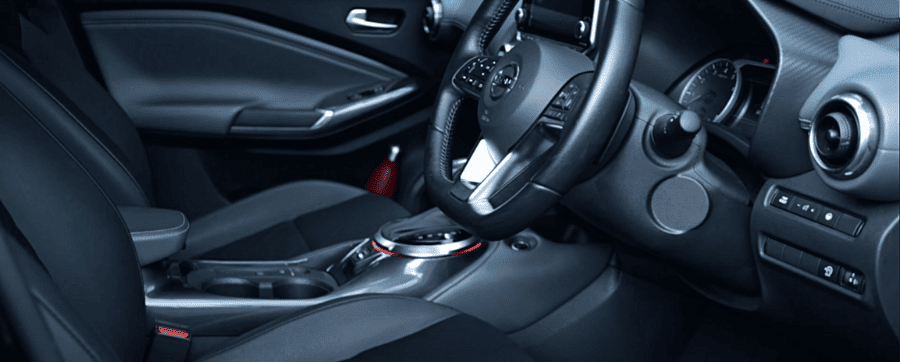
The Nissan Juke provides practical storage solutions. There’s a convenient smartphone storage area near the center console, although it lacks wireless charging.
Two cupholders are available between the front seats, and the door bins can easily accommodate 500ml bottles. Additionally, the center console offers extra storage space. Notably, the glove box is impressively spacious, one of the largest we’ve seen in a while.
In the rear cabin, there’s more room compared to the previous Juke, with 5.8 centimeters of extra knee room and one additional centimeter of headroom. This ensures that even passengers over six feet tall will be comfortable.
The rear seats offer good lumbar support, enhancing overall comfort. However, the aggressively tapered rear window line can make the rear feel slightly compact, creating a cozy environment.
Isofix fittings are available on both rear seats and the front passenger seat. There’s a single USB port to share, along with a small compartment between the two front seats, suitable for storing small items like sweets or a smartphone.
The middle seat is decent for short journeys but not ideal for longer trips, as it lacks comfort. If you sit in the middle, you’ll encroach on the personal space of other rear passengers. Nevertheless, it surprised us with its support.
What tech is on offer?
With the “Tekna” trim we selected, you’ll have an eight-inch central display equipped with the NissanConnect infotainment system. It also supports Apple CarPlay and Android Auto, allowing you to mirror your smartphone apps on the screen if you prefer.
Comparing it to infotainment systems in Mercedes and BMW vehicles, this screen is functional but not particularly exceptional. There’s a slight half-second delay when switching between different options, which can be a bit annoying.
Additionally, the icons on the screen can appear small, especially when you’re glancing at them while driving. It would have been helpful to have an option to increase the font and icon sizes. A slight angle adjustment towards the driver would also improve visibility while driving.
One positive aspect is the presence of physical buttons below the screen for easy navigation to the menu, map, and camera functions, which is preferable to touch-sensitive buttons found in some other models.
The graphics are reasonably sharp, particularly when using the TomTom maps navigation system with live traffic updates. You can also access in-car Wi-Fi for connecting your devices and utilize Google Assistant to control various car functions, including lighting and route planning.
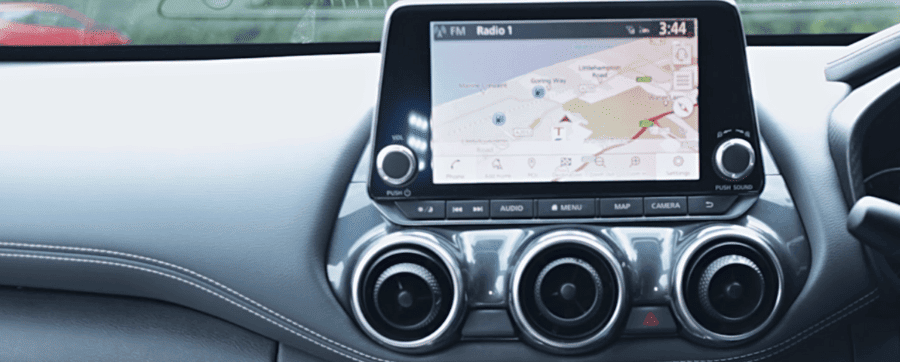
Below the screen, you’ll find unique-looking air vents that offer a satisfying click when adjusted. Further down, the climate controls are thoughtfully designed, featuring physical buttons for temperature adjustment, air intensity, and heated seats.
Beneath these controls, there’s a 12-volt socket and a USB port. The dashboard is logically organized into tiers, with the screen on top, followed by the air vents, climate controls, airbag, and a convenient phone storage compartment at the bottom. Nissan has done a great job with this layout.
Behind the steering wheel, there’s a seven-inch digital driver’s display that shows your speed and activated safety assistance features.
Interestingly, there’s also a traditional analogue speedometer on the right side, providing redundant speed information, which might seem a bit inefficient.
Notably, the “Tekna” trim and above come with the Bose Personal Plus sound system, featuring eight speakers, including two in the front seats. It delivers fantastic audio quality for an enjoyable listening experience on the go.
The NissanConnect Smartphone Companion app, when paired with the car, allows you to lock/unlock the vehicle with your smartphone and check oil and tire pressure, offering added convenience.

What kind of engine does a Nissan Juke have?
115HP 1-Litre DIGT 3-Cylinder Petrol Unit
The bonnet lever is oddly placed on the front passenger side, just below the left-most air vent, but it’s easy to use with a single pull. To fully open it, there’s a yellow latch under the bonnet that needs to be moved all the way to the left.
However, the bonnet doesn’t stay up on its own, so you’ll need to use the rod from the bottom of the bonnet to keep it open.
The Nissan Juke offers only one powertrain option, which is a bit disappointing. It’s equipped with a 1.0-liter turbocharged DIGT three-cylinder petrol engine, producing 115 horsepower and 200 Newton-meters of torque.
With the manual gearbox, it goes from 0 to 62 MPH in 10.7 seconds, and with the automatic gearbox, it takes 11.1 seconds.
Its top speed is 112 MPH. While it might not feel as punchy as equivalent engines in rivals like the Škoda KAMIQ and Volkswagen T-Roc, it performs well for overtaking on the motorway or dual carriageway once up to speed.

The Nissan Juke offers a choice between a six-speed manual or a seven-speed automatic gearbox. The manual is responsive at slow speeds in urban areas but has a slight delay when accelerating from a complete stop, which requires careful judgment at roundabouts.
The seven-speed automatic, which we tested, can feel a bit jerky at slow speeds and tends to downshift unnecessarily on steep inclines, but overall, it performed well.
The Juke is only available in front-wheel drive, with no all-wheel-drive option, making it unsuitable for off-road driving.
In terms of fuel efficiency, the manual gearbox achieves up to 47.6 miles per gallon on the combined cycle, while the automatic achieves 46.3 miles per gallon.
With the start-stop function enabled, it provides feedback on your efficiency. In terms of CO2 emissions, it produces up to 134 grams per kilometer, placing it in the 30 benefit-in-kind tax bracket for 2021 to 2022.
If you’re considering this car as a company vehicle and want more significant savings, you might want to explore Nissan’s electrified options like the LEAF or ARIYA. These models have different body styles but offer better economy.

Are Nissan Jukes easy to drive?
The Nissan Juke offers a leisurely driving experience with its firm suspension, providing a smooth ride over bumps. However, on faster roads, you’ll feel some impact from bumps, even with larger 19-inch alloy wheels.
Despite the wheel size, the ride quality doesn’t significantly change, but the Juke excels in body control, maintaining stability when navigating sharp turns and corners. It exhibits minimal roll and sway for a car in its class, surpassing competitors like the Ford Puma in this aspect.
The Juke features light steering, which is easy to handle but lacks a certain level of feedback, making it less thrilling to drive. Overall, while it’s a comfortable and capable SUV, it may not deliver an exhilarating driving experience.
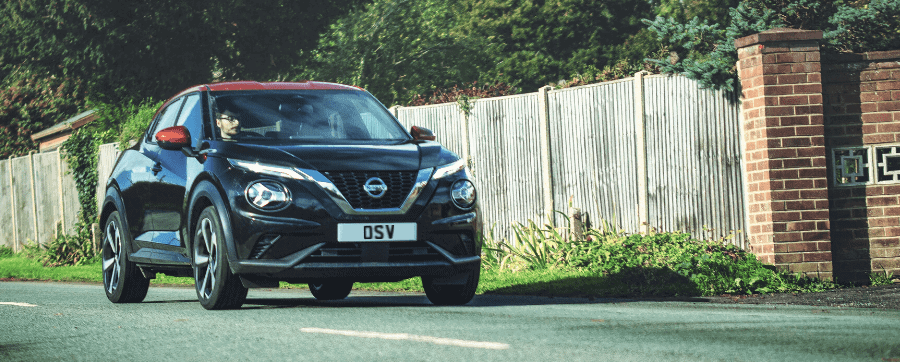
The one-litre petrol engine is generally quiet, but it produces a peculiar whistling sound during hard acceleration, which can be a bit annoying. However, this noise is easily drowned out by the radio or music.
Unfortunately, there is noticeable tire and wind noise in the cabin, possibly due to the 19-inch alloy wheels on our model. Opting for smaller wheels or considering the Volkswagen T-Cross, known for its quietness, may help reduce this noise.
The Nissan Juke offers good visibility thanks to its high-riding height and slim side pillars. However, rear visibility is limited due to the chunky rear pillars and small side windows, a result of the coupe-like body style.
Parking can be a bit challenging, but center trims and above include a rear-view parking camera, upgraded to a 360° camera with “Tekna” and “Tekna+” trims. While not the clearest view, it’s functional and provides a bird’s eye view for precise parking.
Which Nissan Juke model is best?
Nissan Juke Visia
The Juke starts from around £19,200 and climbs up to £27,200 if you opt for one of those higher-spec trims.
The entry-level one is “Visia” and it comes with a great deal of standard equipment: you get electronic windows, air conditioning, a DAB radio, idle stop-start, cruise control, and you’ll see all those controls on the steering wheel.
It also includes a wide variety of other features. You do get a 4.2-inch driver display, however, if you’re into your tech, you’ll want to climb up the range a bit more.
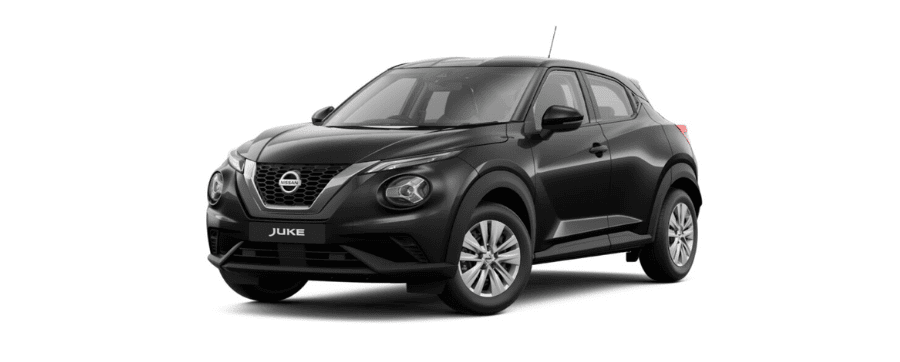
Nissan Juke Acenta
Next up, is the “Acenta”. This is priced from £20,800 and it gets a couple of extra features: you’ll receive 17-inch Sakura wheels, a rear-view camera on a much larger 8-inch touchscreen, you also get Apple CarPlay and Android Auto, so if you want to mirror your smartphone apps onto the screen, that’s the one to go for.
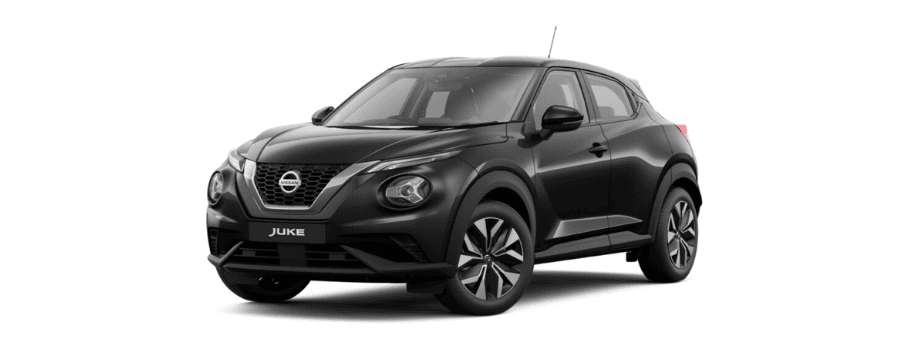
Nissan Juke N-Connecta
In the middle of the pack is “N-Connecta” and that starts from £22,800, so an extra couple of grand over the Acenta trim.
It’s here that you get the seven-inch driver display, you get TomTom navigation and a leather-wrapped steering wheel and keyless start, meaning you can throw your keys anywhere in the car and take off, without worrying about where they are.
The air conditioning has also been upgraded to climate control. You receive some nice extra features with this trim.
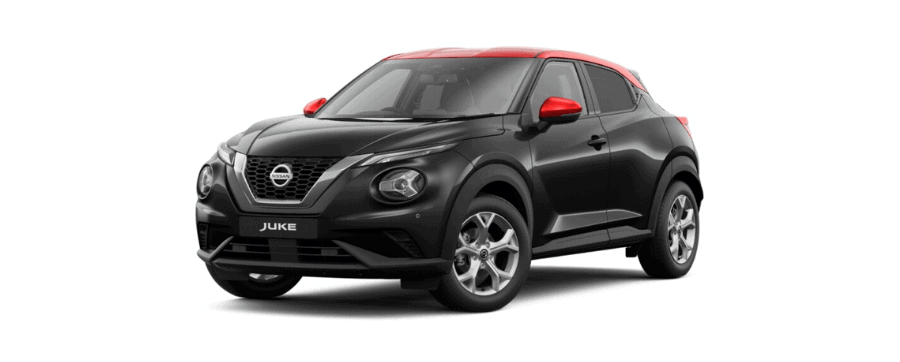
Nissan Juke Tekna
Next up is the trim that we’ve configured our Juke with, the “Tekna”, it starts from £24,300.
With this trim, you get the much larger 19-inch alloy wheels, which look fantastic, you get the Bose Personal Plus sound system that sounds brilliant and you get the heat pack, so you get a heated front seat and a heated front screen as well, so you don’t have to worry about that frosting up.
Meaning, all your winter problems are solved with this trim. In case you’re wondering, the exact configuration we had with the Fuji Red roof, comes to around £25,400.
If you’d like a bit more information about this particular configuration, just get in touch with one of our vehicle specialists and they’d be happy to provide you with all the information that you need.
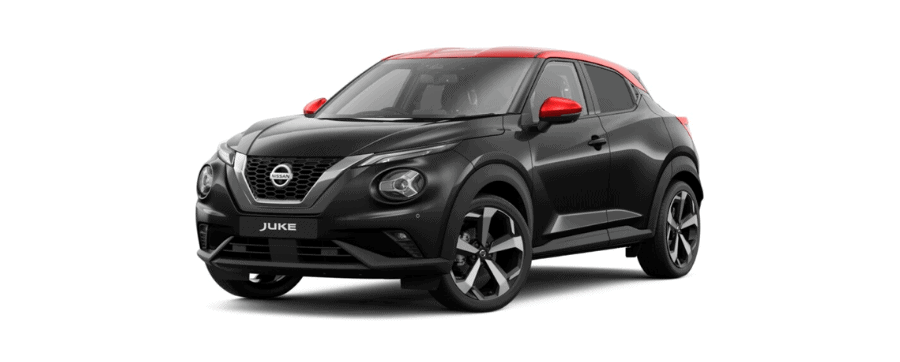
Nissan Juke Tekna+
Last up is “Tekna+”. That’s the top of the range trim and that starts from £25,700. It’s essentially just a cosmetic pack, so you still get those 19-inch alloys, though they are now the Akari alloy wheels, which just look a little bit more elaborate than before.
There are a few interior styling packs to choose from, including Fuji Red, Light Gray, and Pearl Black. You get a satin silver front bumper finisher and a few exterior styling packs to choose from.
So, if you want to get the most out of your Juke and make it your own, personalize it as much as possible, this is the trim that you should choose.
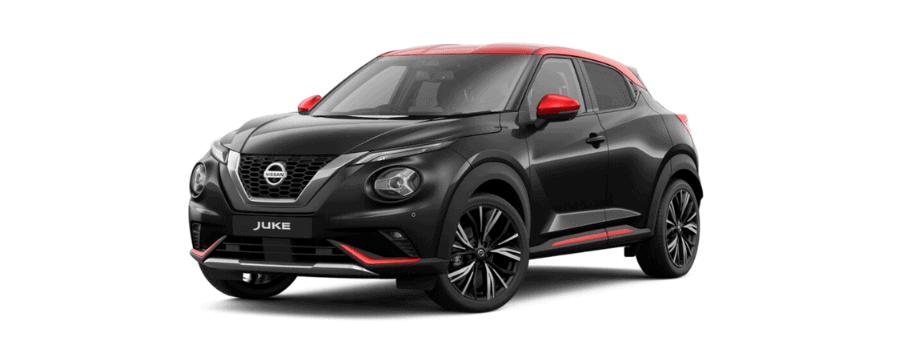
Is the Nissan Juke a reliable car?
The Nissan Juke impressively earned a five-star safety rating from Euro NCAP, outperforming the Škoda KAMIQ in pedestrian and child occupancy tests.
It boasts a comprehensive set of safety features, including intelligent emergency braking with pedestrian and cyclist detection, intelligent lane intervention, and traffic sign recognition.
Opting for the “Tekna” trim adds more safety tech, such as rear cross-traffic alert and blind-spot monitoring. These features enhance safety, making the Juke a great choice for families. For more on Nissan’s reliability, you can refer to our Nissan reliability article.
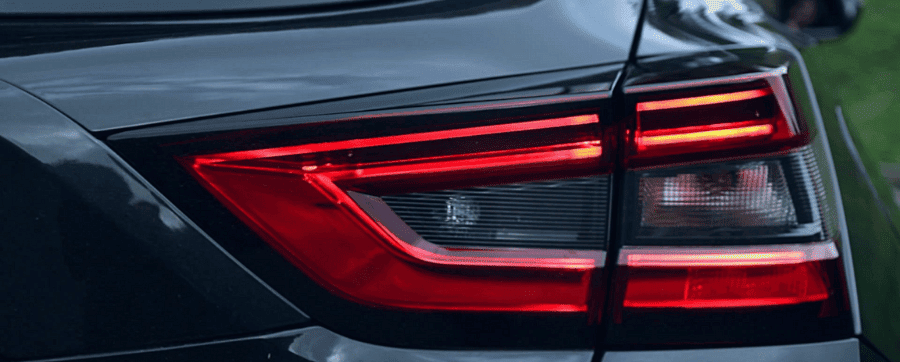
What are the Nissan Juke Pros and Cons?
If you’re considering whether to buy, lease, or finance a Nissan Juke, here’s our take:
Initially, we had mixed feelings about this car, but after spending time with it, we’ve grown to love it. The standout exterior design sets it apart from other small SUVs, making us believe it doesn’t need a facelift.
The interior offers remarkable comfort, even when compared to more expensive cars. While the tech isn’t as advanced as premium brands like BMW, Mercedes, or Audi, it’s well-implemented, and the Juke boasts a five-star safety rating.
The ample boot space, adjustable boot floor, and cozy cabin make the Juke a great choice for growing families. Plus, the entry-level trim comes with plenty of standard features, and as you move up the range, it only gets better. Pricing is also more competitive than key rivals.
However, there’s only one engine option, which is a bit limiting. We hope Nissan introduces a more powerful engine or a plug-in hybrid in the future. But if you prioritize comfortable and stylish transportation from A to B, the Juke is an excellent choice.
For comparisons with similar vehicles, check out our OSV Car Reviews, or reach out to our specialists at 01903 538835 or by clicking the banner below to book a free consultation. You can also find our official OSV Nissan Juke Review on our YouTube channel and explore more motoring content.

Is the Citroen C3 Aircross the Most Comfortable SUV?
- Is the Citroen C3 Aircross comfortable?
- What tech does the Citroen C3 Aircross offer?
- What is the Citroen C3 Aircross’ exterior like?
- How big is the boot on a Citroen C3 Aircross?
- What is the Citroen C3 Aircross like to drive?
- What size engine does the Citroen C3 Aircross have?
- What trim levels does the Citroen C3 Aircross offer?
- Is the Citroen C3 Aircross a good buy?
Looking for a compact, fuel-efficient crossover with a comfortable cabin? The Citroen C3 Aircross might be your perfect choice.
Citroen has a knack for crafting small crossovers, catering to growing families. From the quirky C4 Cactus in 2014 to the more refined C3 Aircross, this model offers a larger, upmarket alternative to the C3 supermini.
Replacing the C3 Picasso MPV, it retains practicality, making it an appealing option for Citroen enthusiasts. Sharing the PF1 platform with fellow PSA Group brands like Peugeot and Vauxhall, it aligns with the likes of Peugeot 2008 and Vauxhall Crossland X.
This 2021 Mid-Life Refresh version maintains the C3 supermini’s extensive customization choices: vibrant body colors, contrasting roofs, and evolving interior designs across trim levels. This model brings exterior tweaks, increased cabin storage, and a new infotainment system.
Standing out in a competitive field that includes the Ford Puma, Škoda Kamiq, Hyundai Kona, and Nissan Juke, the C3 Aircross excels in personalization, practicality, and comfort.
While not the most thrilling SUV to drive, its strength lies in personalization, practicality, and comfort. Discover why in our comprehensive review.
Is the Citroen C3 Aircross comfortable?
Let’s explore the comfort and tech of this SUV. Stepping in, the seats immediately stand out. Each trim level has its own unique upholstery style. In our top-spec “Shine Plus” model, the “Brasilia” black leather effect with grey-flecked upholstery complements the exterior colour perfectly.
These advanced comfort seats, recognizable to Citroen fans, boast a distinctive shape, plush padding, and notable stitching. Beneath the upholstery lies 15 millimetres of memory foam, providing extra support on winding roads. This sets them apart from rivals, earning high marks for comfort.
For compact SUV enthusiasts, the Citroen C3 Aircross delivers the desired high-riding position for optimal road visibility. Even in lower settings, its elevation provides an impressive view, and adjustable options ensure finding your ideal driving setup is a breeze.
Surprisingly, the build quality surpasses expectations, particularly given the SUV’s affordable price.
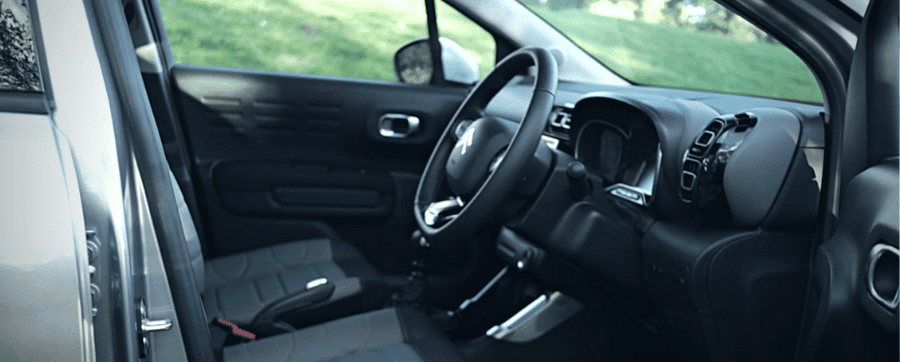
The interior boasts art-deco-style air vents with silver accents, mirroring the silver buttons beneath the central display. This display is elegantly framed in gloss black, lending a premium touch.
The leather-wrapped steering wheel and diverse dashboard materials add to the appeal, showcasing the meticulous design by Citroen.
Cleverly placed cubby holes are scattered throughout the cabin, including cupholders by the handbrake and a deep storage compartment in the centre console.
For smartphones, a dedicated spot sits below the central display, complete with a 12-volt socket and USB port. Ample space in the glove box and door bins easily accommodates essentials like a 500ml bottle. With the C3 Aircross, your storage needs are well covered.
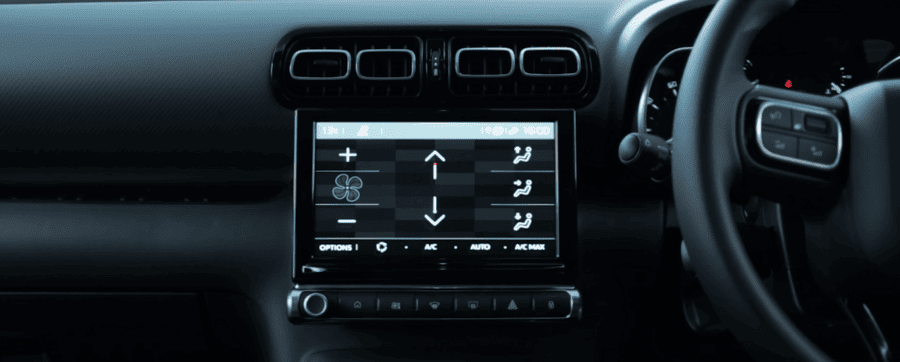
The back of the Citroen C3 Aircross offers generous legroom, comfortably accommodating passengers over six feet tall.
Though knees might touch the soft back of the seat, it’s hardly an issue as they’re quite cushioned. A padded compartment suits an iPad or magazine, while ample storage and individual window blinds enhance the convenience.
Headroom is generally good, unless you’re taller than six feet and have chosen the panoramic sunroof (an optional £1,030 feature).
This slightly reduces headroom, noticeable when you touch the roof. However, the sunroof’s appeal is undeniable – it floods the cabin with light and suits those rare sunny UK days.
When you lack a middle passenger, you can fold down the centre compartment for cup holders. While the Aircross is ideal for families of four rather than five, the middle passenger’s legroom could be limited.
For short trips, it’s workable, but longer journeys might warrant avoiding the middle seat. Passengers can share a central compartment with a 12-volt socket for charging devices, plus there are handy Isofix fittings on both seats.
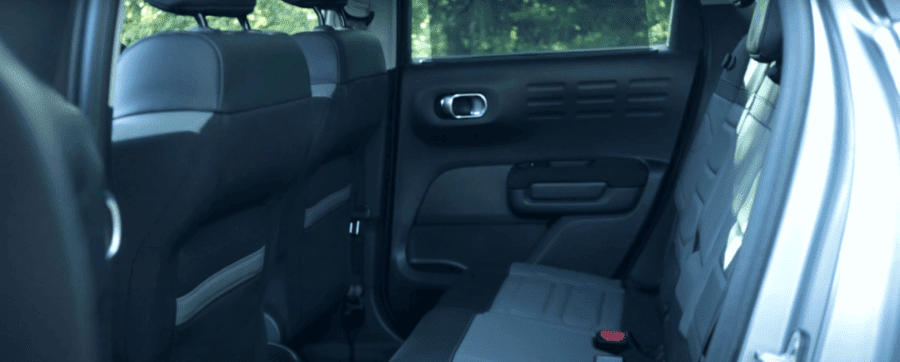
What tech does the Citroen C3 Aircross offer?
What’s the infotainment like? The base setup offers a seven-inch touchscreen featuring DAB radio, six speakers, Bluetooth, Apple CarPlay, and Android Auto. Opt for the mid-range “Shine” spec, and you’ll enjoy a nine-inch touchscreen plus a one-year Citroen Connect Nav subscription.
This subscription provides 3D navigation with real-time traffic, weather updates, and fuel-stop locations – a boon for frequent commuters.
The screen quality is sharp, displaying options clearly. However, the positives dwindle from there. Lag and unresponsiveness mar the experience, with noticeable input delay. Loading times can frustrate while on the move, impacting your focus on the road.
Navigation through menus can also prove challenging, especially since there’s no dedicated settings area. This aspect needs refinement.
One glaring downside is the integration of climate controls into the touchscreen. Adjusting air intensity and temperature requires navigating a separate menu and pressing quite firmly. Physical buttons below the display would be more intuitive and user-friendly.
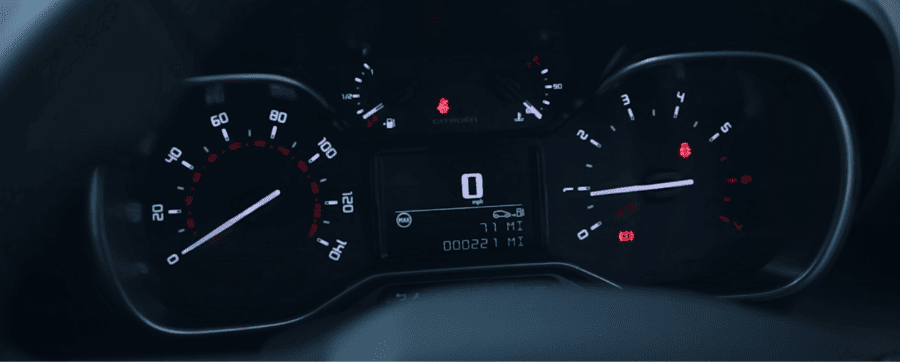
Worth noting are the analogue instrument dials behind the steering wheel, hosting a 3.5-inch colour touchscreen displaying vital data like speed, mileage, and fuel level. For those seeking sophistication, an optional head-up display can be configured.
This projects speed, cruise control settings, and navigation directly in your line of sight. While a nice addition, it’s not essential. However, if you want to maximize your C3 Aircross’s potential, it’s certainly worth considering.
What is the Citroen C3 Aircross’ exterior like?
Examining the car’s exterior design, the standard features include eco LED headlights with daytime running lights – a consistent inclusion across all trims, a commendable choice.
Inspired by the CXPERIENCE concept car from 2016, the front boasts a redesigned look, a trend seen in many Citroen production vehicles, including the new C3.
This bold, assertive style, reminiscent of the Juke’s quirky aesthetics, carries an appealing charm. Below the Citroen badging, an intriguing strip of plastic adds character, harmonizing with the design.
The prominent air intake along the bottom contributes to the striking appearance, setting it apart from other small SUVs in the market.
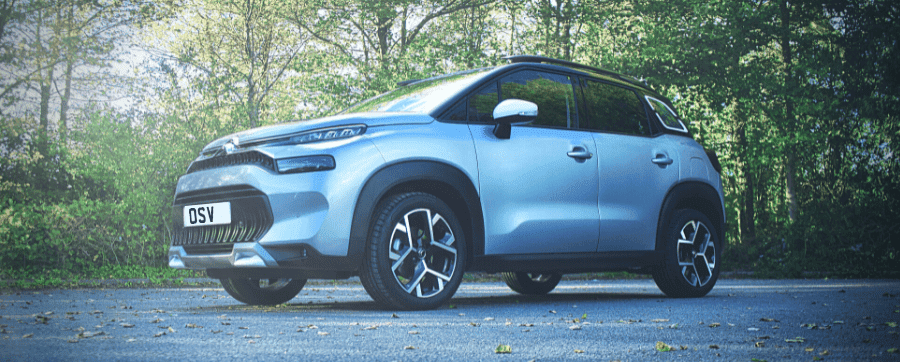
The alloy wheels range from 16 to 17 inches in size. Because we opted for the top-spec “Shine Plus” trim, we have large 17-inch Origami diamond-cut alloy wheels and they look absolutely gorgeous and nicely complement the rest of the car’s design.
The wheelbase, which is the difference between the front and rear axles, has grown by 60 millimetres over the regular C3 to 2,644 millimetres. That’s freed up more space inside the interior, so now comfortably fits four adults on a long journey.
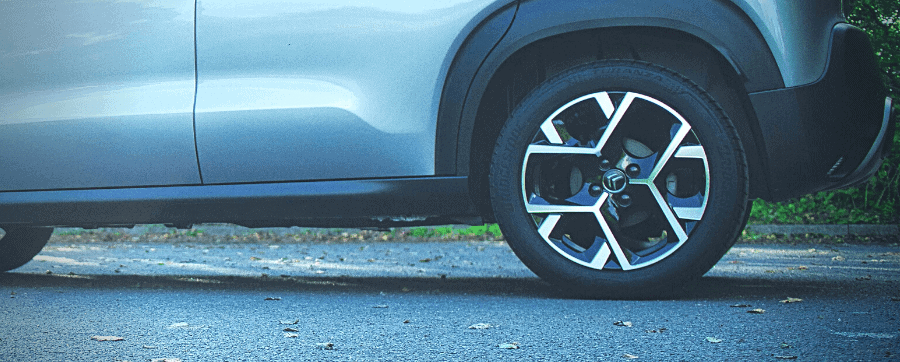
From the side, you’ll see the contrasting roof. You can get that in three new colours with the Mid-Life Refresh. These include Perla Nera Black, Polar White, and Monotone, which is whatever body colour you’ve chosen.
There are also three new exterior body colours: Voltaic Blue, Khaki Grey and Polar White. We went for the Platinum Grey and that added around £545 to our configuration and it really nicely brings out the exterior design flourishes with the C3 Aircross.
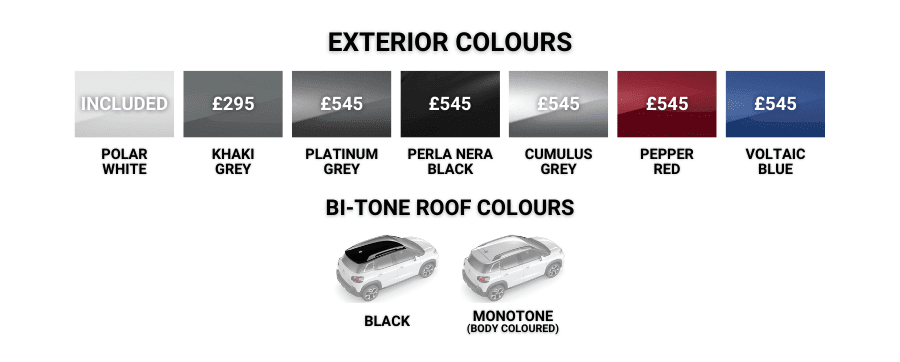
You also get electrically-adjustable door mirrors and these fold inwards when you lock the car. The indicators show up on the side of the mirror, which is handy when overtaking on the motorway.
The side also features body-coloured door handles and tinted rear windows, with the quarter glass being tinted if you opt for the “Shine Plus” trim. With “Shine Plus”, you also get the white exterior colour pack that adds a free glass graphic to the rear quarter glass.
On the left-hand side of C3, you’ll also find the fuel cap. Finally, at the rear, the darkened LED light clusters complete this really extravagant look.
How big is the boot on a Citroen C3 Aircross?
The Citroen C3 Aircross boasts one of the most generous and practical boot capacities in the small SUV category. With 410 litres of space, it accommodates six carry-on suitcases.
Opt for the “Shine Plus” trim, and sliding the rear seats forward expands the capacity to an impressive 520 litres. Fold the rear seats down for a whopping 1,289 litres. To fold the seats, you’ll need to access a lever inside the rear cabin.
This flexibility proves handy for accommodating long items like skis and camping gear. The C3 Aircross’s loading area features a low lip, ideal for effortless loading of heavy shopping bags. With all trims except “C-Series,” a pull-out boot floor comes standard.
When flattened with the rear seats folded, there’s no gap, allowing easy insertion of oddly shaped items. Remove the floor entirely to maximize luggage space, creating a deeper, spacious boot. The level of practicality here is truly impressive.
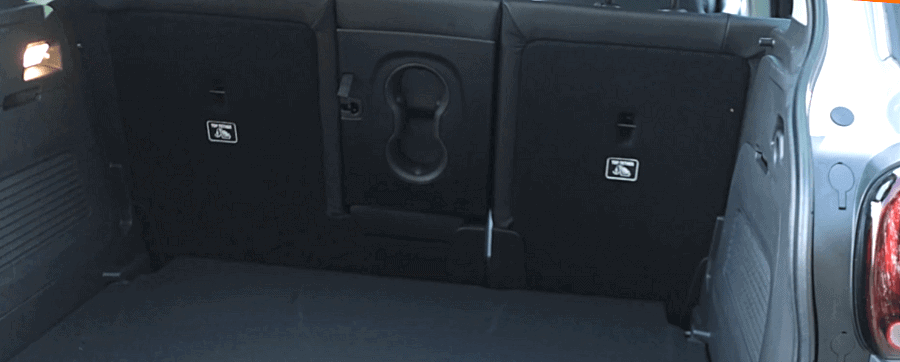
What is the Citroen C3 Aircross like to drive?
The C3 Aircross shares its platform with the regular C3, offering a similar driving experience – both positive and negative. The suspension is notably soft, providing a contrast to the firmer setups found in sportier cars like the Ford Puma.
However, the downside is that road imperfections transmit vibrations throughout the cabin, a concern shared by the regular C3. The elevated ride height in this model helps mitigate the impact, though some reverberation remains noticeable.
Despite its size, the vehicle maintains impressive stability with minimal body roll. Negotiating tight corners and bends doesn’t induce excessive leaning. Its stability is comparable to vehicles like the Ford Puma, an achievement given the C3 Aircross’s non-sporty nature.
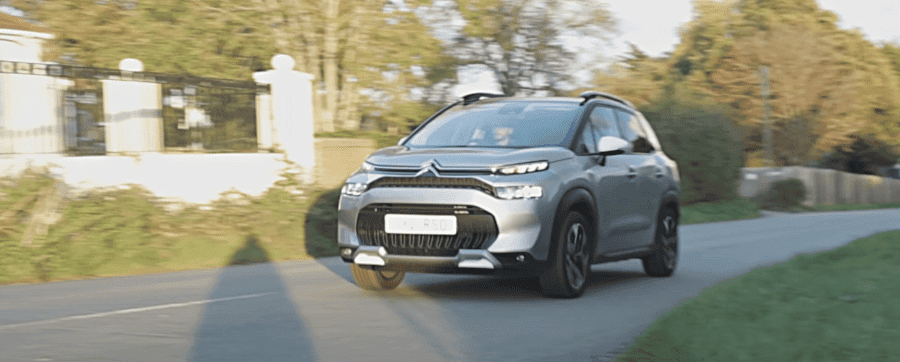
Driving at speeds up to 30 MPH feels remarkably smooth and comfortable, perfect for city driving. Yet, beyond 60 MPH on motorways, wind and road noise become more noticeable, along with a louder engine.
The clutch and accelerator pedals may also generate some buzz, which can be a bit bothersome. In summary, it’s an excellent urban car for short trips and errands. However, be aware that on highways or dual carriageways, cabin noise could disrupt your drive.
The C3 Aircross features light steering, which we found favorable. If you’re accustomed to firmer steering, an adjustment period might be needed.
Unfortunately, the C3 Aircross lacks all-wheel-drive capability, though it does come with the grip control system that enhances traction on various terrains. While off-roading is possible, we recommend it with reservations.
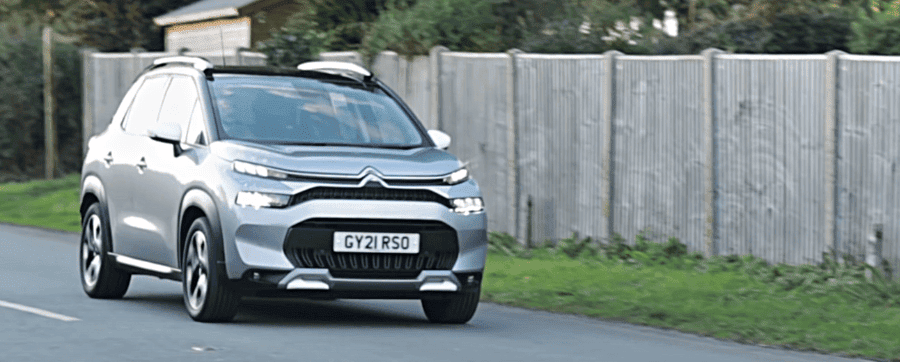
What size engine does the Citroen C3 Aircross have?
PureTech 110 variant
Regarding the engines, the base option is the PureTech 110 six-speed manual. It houses a 1.2-litre three-cylinder engine, likely familiar to Citroen and Peugeot drivers.
Generating 109 brake horsepower and 205 Newton-metres of torque, it accelerates from 0 to 62 MPH in 10.1 seconds – respectable, though worth considering when merging onto highways.
Standard is the six-speed manual, while an automatic Eisen gearbox is also available, operating smoothly akin to the MINI models.
The PureTech 110 stands as one of the market’s most fuel-efficient small SUVs, achieving 47 mpg combined and emitting approximately 134 g/km of CO2. This places it within a reasonable benefit-in-kind tax bracket for company car buyers.
PureTech 130 variant
Moving up, we encounter the PureTech 130 variant, solely available with the six-speed auto transmission – no manual option.
Generating 129 brake horsepower and 230 Newton-metres of torque, it improves acceleration to 0 to 62 MPH in 9.2 seconds. While the added performance is appealing, be prepared for slightly higher fuel and company car tax expenses.
It’s a touch less fuel-efficient than the previous unit, achieving around 45.6 mpg combined, with CO2 emissions ranging from 140 to 158 g/km based on your specific configuration.
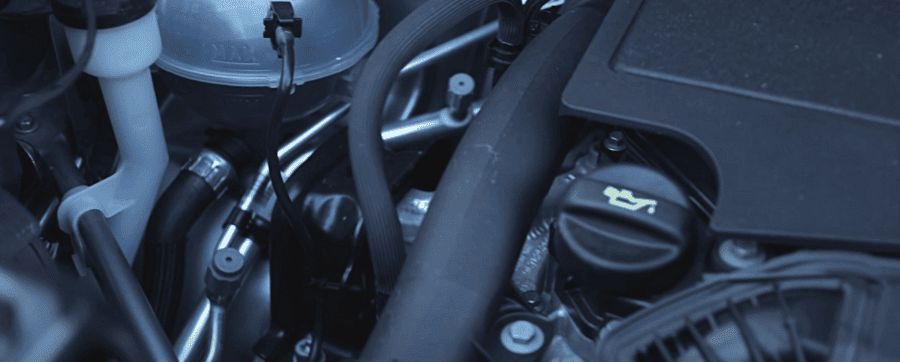
Blue HDI 110 diesel unit
Looking for the most economical engine choice? Then the Blue HDI 110 diesel unit is your pick. It’s commendable that Citroen continues to offer this option while other manufacturers are phasing out diesels.
Generating 99 brake horsepower and 250 Newton-metres of torque, it achieves 0 to 62 MPH in 10.8 seconds, notably faster than a diesel Renault Captur at 14.4 seconds. This unit’s mileage is impressive, reaching up to 58.8 mpg combined.
If you face a lengthy daily commute and desire fewer fuel stops, this is an enticing choice. It emits up to 125 g/km of CO2, landing in a reasonable benefit-in-kind tax category.
This diesel variant exclusively offers a six-speed manual gearbox – no auto option. It’s important to note that the Blue HDI 110 is pricier than the PureTech 110, despite lesser performance capabilities. Your decision hinges on whether the fuel efficiency justifies the added cost.
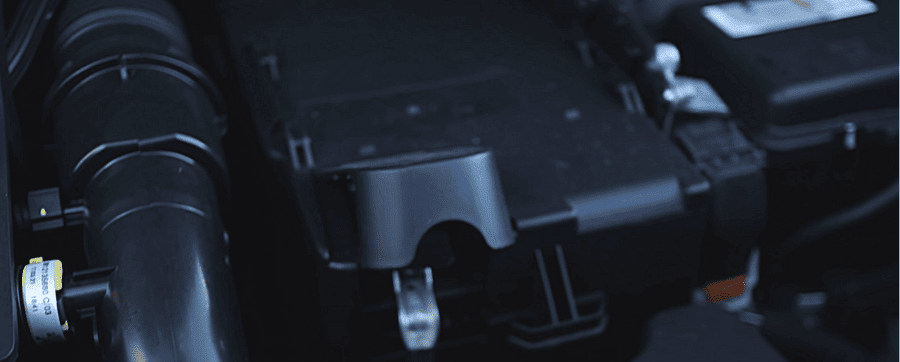
What trim levels does the Citroen C3 Aircross offer?
C-Series
Let’s start with the entry-level variant, the “C-Series” trim. Prices for this variant start from £20,635, which we think is quite reasonable for a small SUV.
The equipment on offer here is pretty good for a standard spec: you get eco LED headlights with daytime running lights, 16-inch X cross/ cross-cross diamond-cut alloy wheels, rear parking sensors, cruise control, lane departure warning safety system, and Apple CarPlay and Android Auto.
We think it’s a pretty good spec on offer for this entry-level trim.
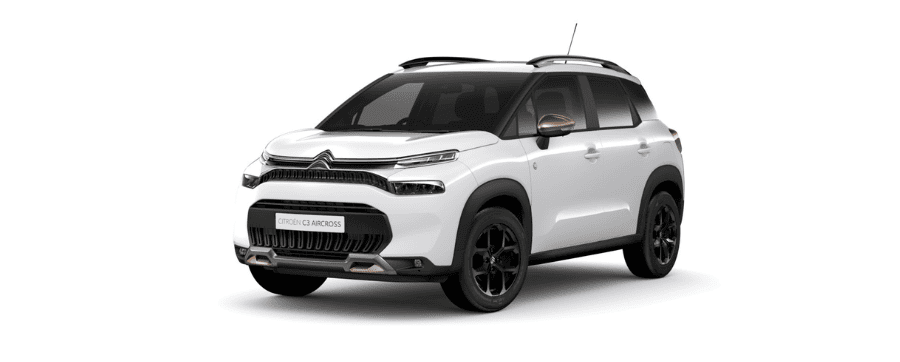
Shine
Next up is “Shine“. This trim level starts from £21,565 and you get extra safety features, like the active safety brake with forward collision warning, and the Citroen connector box emergency and assistance system whereby you can use the SOS button, near the rear-view mirror, to alert the emergency services in the event of an accident.
Other highlights of the “Shine” trim include the larger nine-inch touchscreen with the Citroen Connector Nav system, “Mica” grey upholstery and chrome inserts around the dashboard, steering wheel, and centre console, and a flexible pull-out floor to adjust the height of the boot. You can also upgrade to larger 17-inch alloys with this trim too.
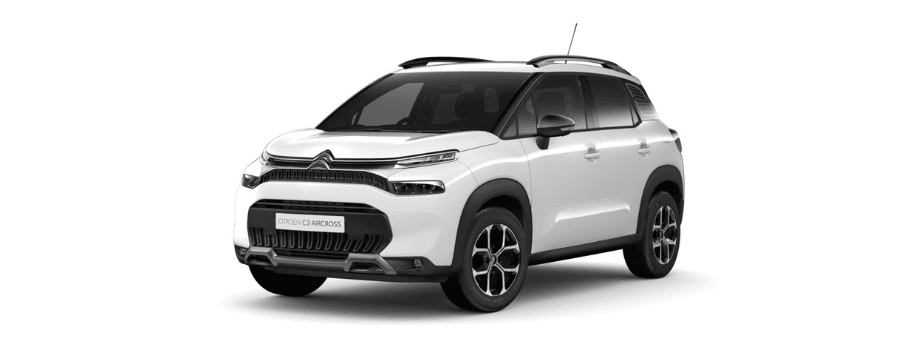
Shine Plus
The top-spec trim level is “Shine Plus“. This starts from £23,175. For this price, you get larger 17-inch Origami diamond-cut alloy wheels and you can upgrade them to full black wheels that, we think, look absolutely gorgeous.
You get the “Brasilia” black leather effect and grey flecked upholstery with the advanced comfort seats, an adjustable central armrest on the driver’s side, keyless entry and start, and front parking sensors with the reversing camera.
So, if you really want to make the most out of your C3 Aircross, this is the trim that you need to go for. If you have any questions about the trim levels and the engines that need answering, one of our vehicle specialists will be more than happy to help.
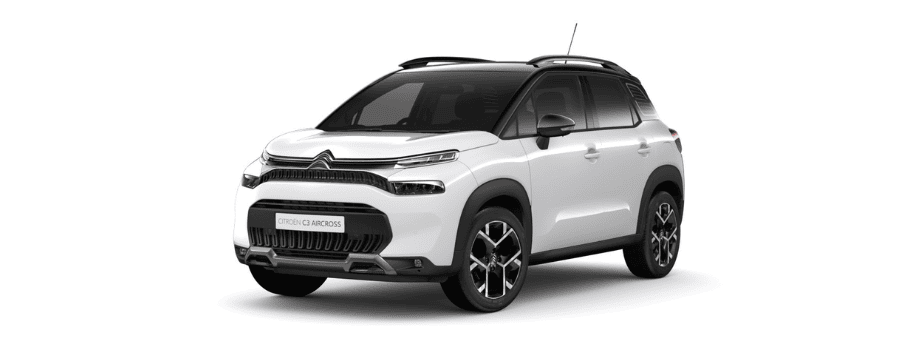
Is the Citroen C3 Aircross a good buy?
Considering whether to buy, lease, or finance a Citroen C3 Aircross? If your focus leans towards comfort rather than performance, this is among the finest small SUVs available today.
Its standout comfort sets it apart – a true pleasure to drive. The attractive design extends both inside and out, offering an appealing aesthetic. With a comfortable cabin for driver and passengers alike, the elevated driving position grants a commanding road view.
Notably practical, the cabin features abundant storage and cubby holes, while the sliding rear seats add an extra layer of versatility – a recommended configuration.
A capacious boot provides ample space for weekly shopping or the occasional camping trip. Its competitive pricing places it more affordably than the Ford Puma and Škoda Kamiq.
Moreover, you’ll enjoy the peace of mind from Citroen’s reliable reputation, ensuring the vehicle’s reliability matches, if not surpasses, its competitors.
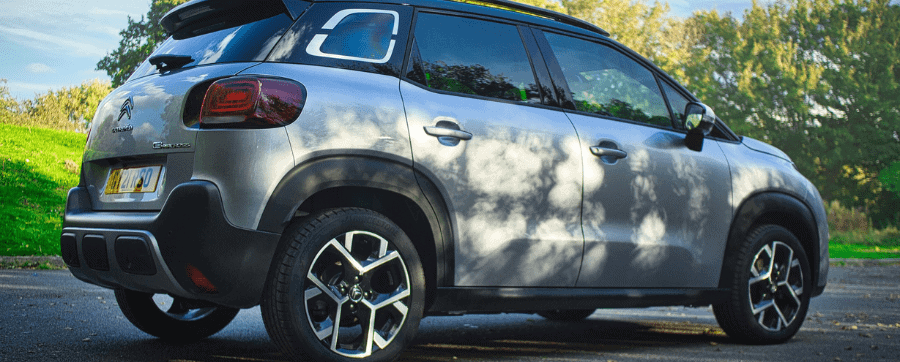
Yet, there are drawbacks to consider. The infotainment system proves laggy and complex, especially while driving. Climate controls integrated into the display hinder ease of use, with physical buttons below being a more practical choice.
If you seek an impactful driving experience, this isn’t the car for you. Its deliberate, comfort-oriented design prioritizes leisurely travel from A to B rather than spirited performance. Despite lacking in excitement, the Aircross offers numerous advantages.
Overall, our experience with this SUV was positive. It’s a comfortable and stylish ride that handles everyday journeys with ease.
To explore the Citroen C3 Aircross further, our vehicle specialists are here to assist. Reach out at 01903 538835 or click below to book a free consultation at your convenience. Also, don’t miss our official OSV Car Reviews and other motoring content on our YouTube channel, along with reviews on our website.
Lexus LC500 convertible review: a truly luxurious car?
- How is the exterior of the Lexus LC500 Convertible designed?
- What is the Lexus LC500 Convertible’s boot like?
- How does driving the Lexus LC500 Convertible feel?
- How has Lexus styled the interior of the Lexus LC500 Convertible? What tech does it feature?
- What do you need to know about the Lexus LC500 rear seats?
- What are the Lexus LC500 engine specs? What about the car’s carbon emissions?
- How can you configure the Lexus LC500 Convertible?
- Should you buy, lease, or finance a Lexus LC500 Convertible? Is the Lexus LC500 reliable?
On the hunt for a sleek, stylish, and professional convertible with an outstanding reliability record and exhilarating performance? The Lexus LC500 Convertible could be your perfect next car.
How is the exterior of the Lexus LC500 Convertible designed?
Jumping straight into the review, let’s start with the design of the car, particularly the front end. It’s rather prominent as it sticks out on the road. It’s also relatively wide.
With the Lexus LC500 Convertible, you receive the signature Lexus grille at the front, housed in between is the Lexus badging. This grille acts as an air intake to cool down the engine, with some nice side intakes in front of the front wheels.
Those nicely complement the “Deep Blue” metallic colour that we configured with the model we chose to review. That also nicely complements the Ochre Smooth Leather that we chose for the interior. There are plenty of metallic options for the exterior and 5 options for the interior.
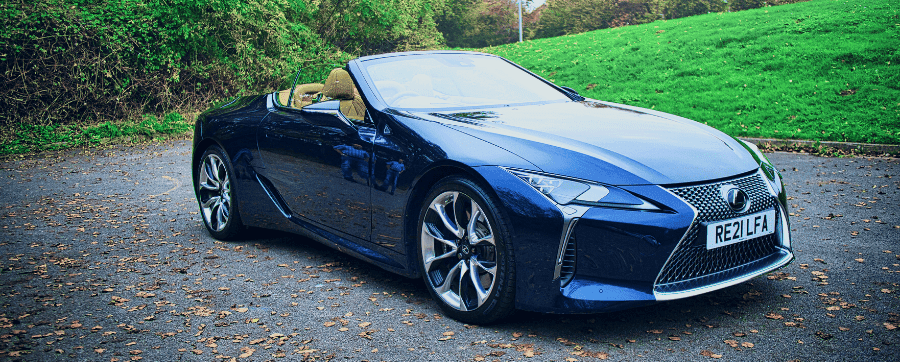
LED headlights come as standard, with automatic high-beam and the “Follow Me Home” function.
This function allows the headlights to stay lit for approximately 30 seconds after the engine is switched off, allowing you to exit the vehicle and head inside without worrying about needing a torch or other light source.
You also receive daytime running lights and LED side lights. We found it great to see LED headlights as a standard option.
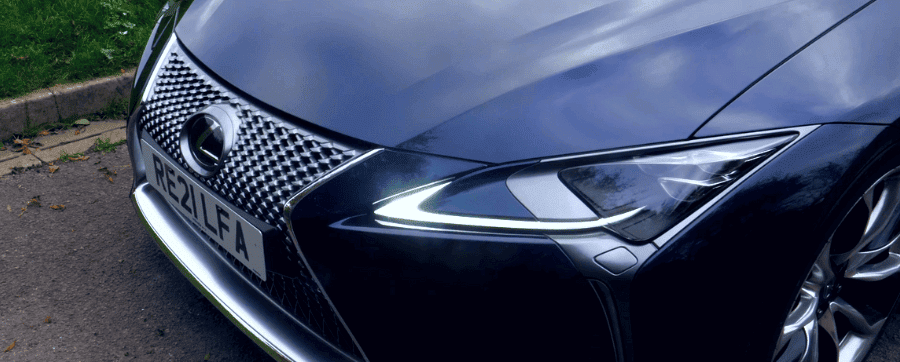
As standard, the alloy wheels are 20-inch but can be upgraded to 21-inch forged alloys that come with the Sport+ pack, which is the top-spec trim level.
However, as mentioned, you can also configure these as an optional extra for the standard configuration. We chose the 21-inch forged alloys and thought that they looked gorgeous and will draw everybody’s attention.
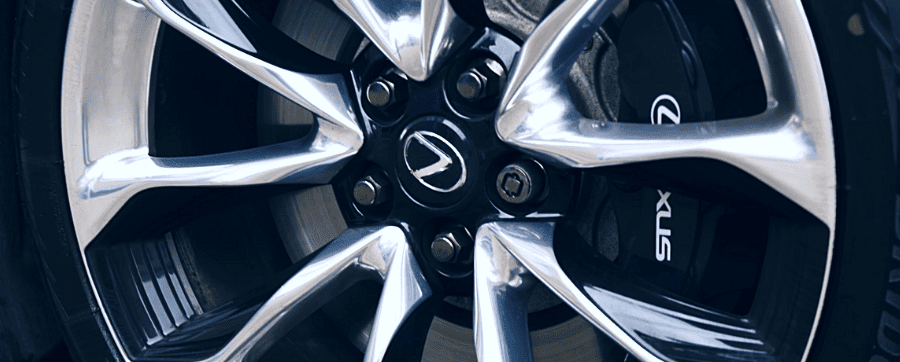
Next up is the side profile. It’s very sleek and exactly what you would expect from a Lexus vehicle. The door handles pop out quite extravagantly and as you pop them out the door mirrors will fold out.
These door mirrors are auto-dimming, auto-folding, and heated, very handy, especially in the winter months. They also have a memory function, remembering how it was set previously and reverting to those settings when you get back into the car.
While they may take a while to get used to, they add a very nice visual flourish to the vehicle’s design.
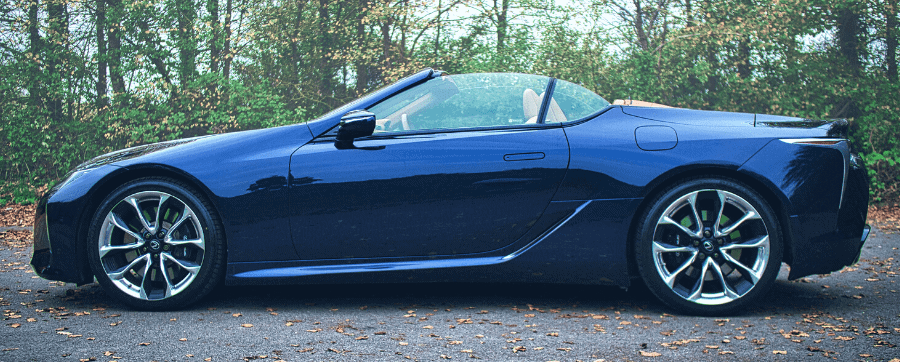
You’ll be able to choose two roof colour options, Black or Ochre. We opted for the Ochre, which we highly recommend as it nicely complements the Deep Blue body colour that we also chose, and it looked gorgeous and stood out on UK roads.
You can fold the roof down, at speeds up to 30MPH, so you can take advantage of the one day of sunshine that we have in the UK, and let some light into that cabin and feel the breeze as you travel from A to B. If the weather takes a turn for the worse, you can just fold the roof back up again rather quickly.
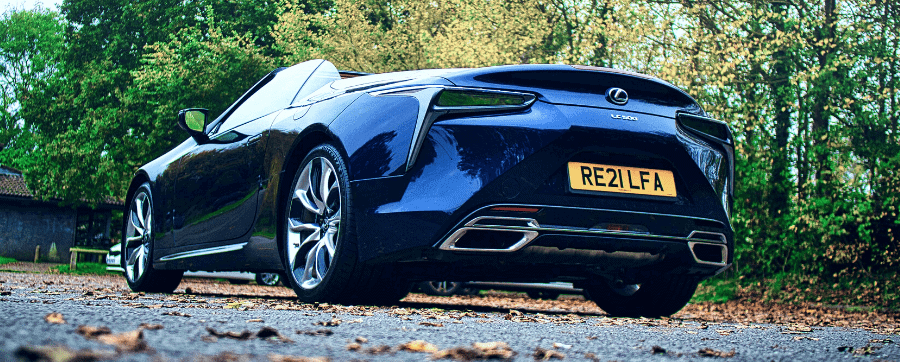
The rear end was probably our favourite part of this vehicle’s exterior design. It looks gorgeous, with multi-LED light clusters. The rear end also has some sharp lines that curve down the sides.
They’re very bold and very prominent. Just at the top of the boot is the brake light that we loved and below that is the Lexus and LC500 badging.
What we liked about this Lexus LC500 Convertible is that it feels a little bit futuristic, while not going over the top and when viewed as a whole, you can appreciate what a fantastic package this vehicle is.
What is the Lexus LC500 Convertible’s boot like?
To get the boot open, you need to hold down a button on the key fob. Unfortunately, there’s no automatic tailgate option. You only get 149 litres to work with, so it’s not a spacious boot.
It’s a very tiny and cramped space, just about enough for two small carry-on suitcases or one mid-sized one, though it will be a tight squeeze.
Unfortunately, we can’t promise that your exact suitcase is going to fit there. There’s also no way to pass objects through into the cabin as it’s all blocked off. There’s also not much space to work with in the rear seats either.
If your boot is fully stocked up with shopping bags or equipment, you can use that rear space for other bits and bobs but you definitely haven’t got a lot of space to work with.
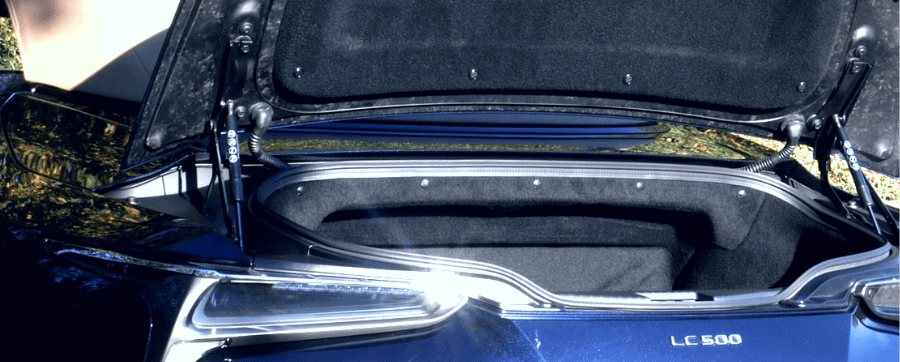
There are several hooks dotted around the boot space to hold in those objects that like to fly around while you’re on the move. But in terms of practicality, that’s pretty much it.
There’s a little bit of space underneath the boot floor, however, it’s mainly for maintenance tools. You could put other objects in there but there’s not a lot of room to work with.
It is a bit disappointing when compared to its rivals, but if you are considering getting behind the wheel of the Lexus LC500 Convertible, then you’re more likely in it for the performance and luxurious cabin and not so much the practicality.
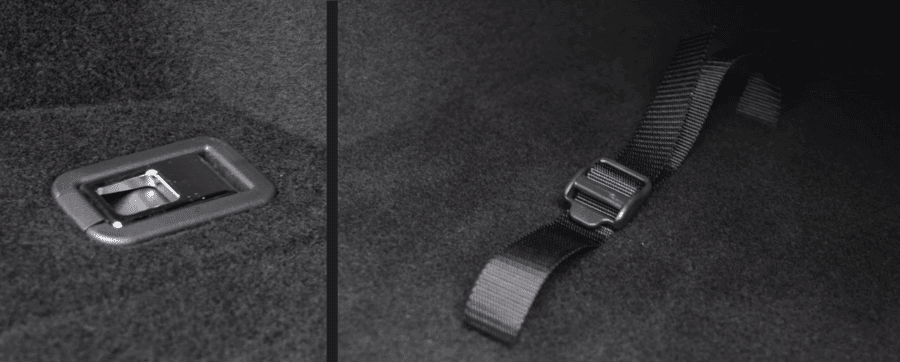
How does driving the Lexus LC500 Convertible feel?
The steering’s quite firm but that gives it a nice amount of feel with the front wheels. You’re able to fly this convertible around corners as it grips the road very nicely.
Thanks to the comfortable seats, you’re nicely held in place as they don’t allow you to sway around too much. The only thing that we struggled with was the lower riding position.
We still had a fantastic view of the road ahead, but we had to be conscious when going over bumps as it doesn’t particularly handle those imperfections in the road very well as you could probably expect from a low-riding car.
As for speed bumps, you’ve got to be very careful and slow down so you don’t hit the front of the car on them, which is something to keep in mind.
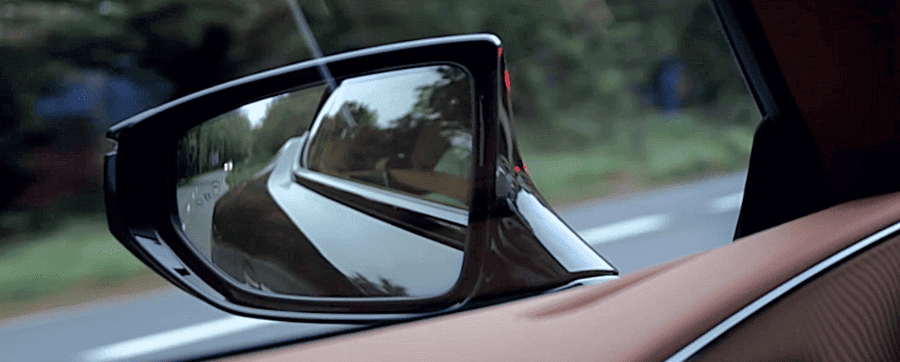
A few technological features that we observed while on the move include the head-up display, showing our current speed.
It projects it onto the road ahead for you so you don’t have to glance down at the driving display. Another feature that we loved was the soft top that when opened, lets in a generous amount of light into the cabin.
It retracts fairly quickly in about 20 seconds. If it starts raining, you can also pull it back up pretty quickly as well.
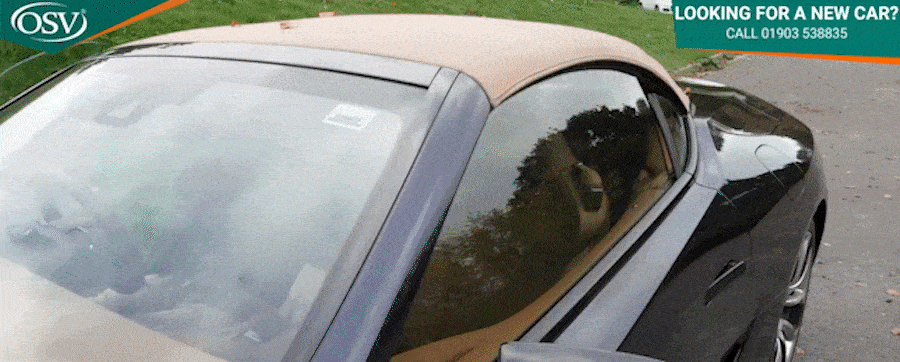
Considering the 5-litre V8 engine under the bonnet, it’s smooth and relaxing to drive at slower speeds. So, when in start-stop traffic, in town or while city driving, you’ll have a relaxed and not particularly taxing driving experience.
Though when you do build up speed to merge onto a motorway or dual-carriageway, the engine roars and it provides you with an exhilarating driving experience.
What is it like in the driver’s seat of the Lexus LC500 Convertible?
As for seat adjustability, we found it very easy to find the most comfortable position. You’re able to slide back and forth quite far and it’s really easy to adjust the position of the seat using the controls located on the side of the seat.
The front passenger also has electric adjustability which is great to see. This car also has a memory function, meaning it will remember exactly how you’ve set up the seat so whenever you get in, you won’t need to fiddle around with the settings.
You can also set different profiles, so if you and your partner drive this car then you can set individual seating positions for the both of you and save yourself some time trying to get back to your original position.
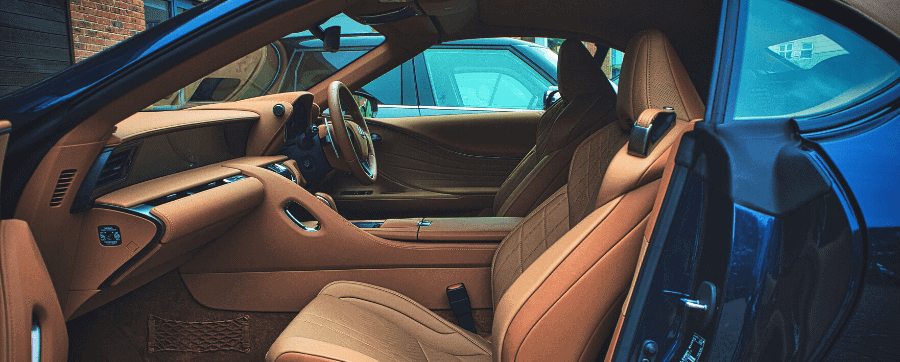
We found the visibility in this Lexus LC500 Convertible to be better than we were expecting. The side pillars on either side of the windscreen are pretty thin, meaning you don’t have a very big blind spot. The mirrors are quite large, providing you with a great view of your surroundings.
The windscreen is also quite big, so even though you sit quite low down in this Lexus, you can easily raise yourself using the electric adjustability. We thoroughly enjoyed driving this car around and we found it to be such a fun car to drive.
How has Lexus styled the interior of the Lexus LC500 Convertible? What tech does it feature?
For our car review, we adorned this cabin in ochre leather which is the smooth leather that is provided as standard. If you opt for the Sport+ pack, you also get semi-aniline leather.
We loved the use of leather with some nice materials dotted around, such as the stainless-steel effect material on the air vents and the gloss black material by the Mark Levinson sound system.
Finally, on the centre console, there are some nice grey and black materials. The inside of the cabin is nicely designed, giving it a very premium and plush feel, which is definitely what you want to feel from a car that costs nearly a hundred thousand pounds.
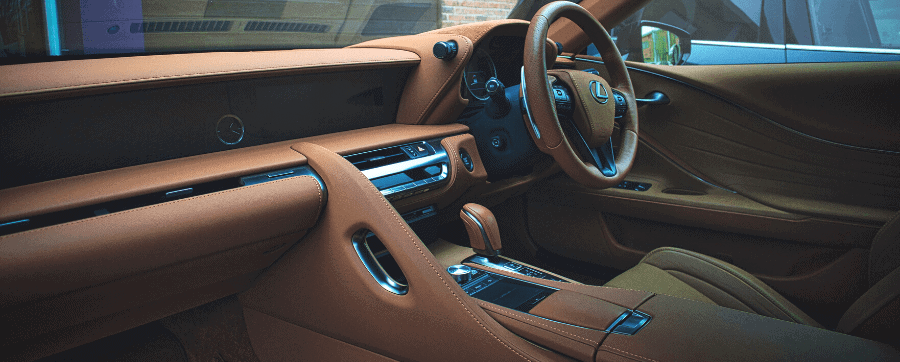
As for the steering wheel, this car is fitted with a three-spoke wheel, which comes heated as standard, perfect for those cold winter mornings.
On the left-hand side of the wheel, there are buttons for the media, and on the right-hand side, we’ve got buttons for the cruise control.
There are also some magnesium paddle shifters, which are perfect if you love the convenience of an automatic transmission, but also love the feeling of changing gears on the fly, like with a manual.
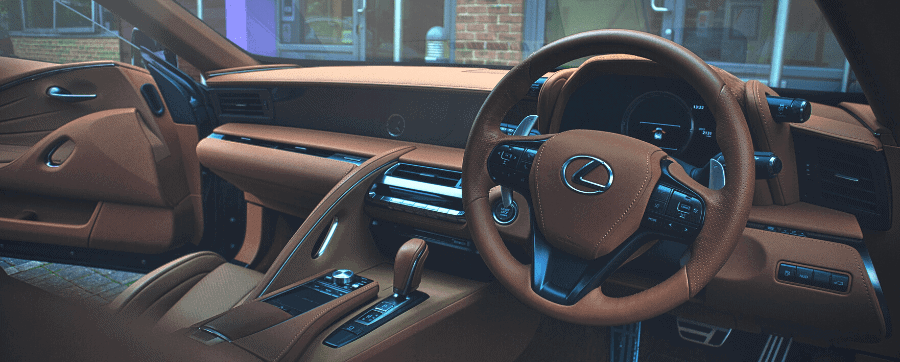
Up from the left of the wheel is a toggle to change between the different driving modes. We recommend you keep the car in Comfort or Eco mode for the majority of your time as you’ll be maximizing fuel efficiency.
This Lexus LC500 also comes with a Normal, for everyday driving, and a Sport mode. While this car is already fast, doing 0 to 60 in five seconds, if you want to get even faster off the block or maybe you’re merging onto a dual carriageway or motorway, you can choose the Sport mode and have fun driving.
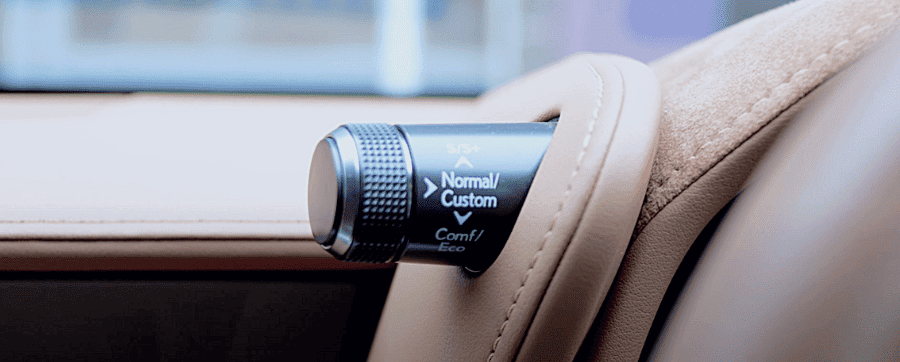
Behind the steering wheel is an eight-inch driver display, which has all the information you would expect, such as how fast you’re going and how much fuel you’ve got left (which is quite important as the miles per gallon with this car isn’t great).
We configured this car with the optional heads-up display and we recommend this feature, however, it doesn’t come with the top-spec Sport+ pack.
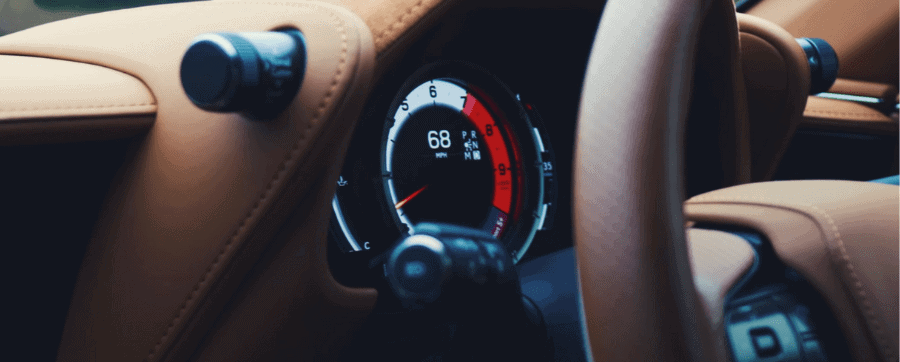
The infotainment centre comes with a 10.3-inch Lexus Navigation display with full European maps and connected services. Apple CarPlay and Android Auto also come as standard, perfect if you want to mirror your smartphone apps onto the display, instead of using the Lexus integrated infotainment service.
We enjoyed how Lexus has styled their system, despite receiving a bit of slack from other reviewers. It’s quite easy to navigate and it’s quite easy to cycle between the different options just by sliding your finger along the touchpad near the armrest, as you would on your smartphone.
It’s intuitive and there’s not a lot of input lag, which makes it easy to use while on the move. However, it’s not as good as what you’d find in a brand-new BMW or MINI as they’ve got their systems down to a T.
The biggest complaint we had is that due to how it’s placed into the leather dashboard, it can sometimes be hard to see, and we did find ourselves leaning over sometimes to see the screen.
It would have been a lot better if the screen was angled slightly more towards the driver so it’s easier to select those options while still focusing on the road ahead.
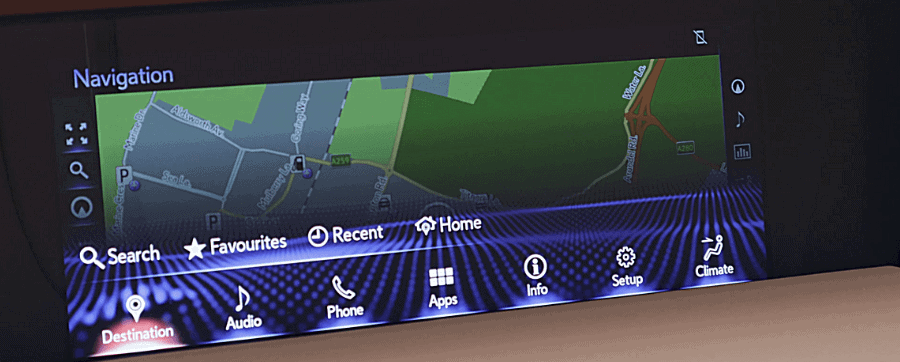
Below the screen is a nice compartment for the climate controls. We were happy with how this works as it’s not too intense, it’s not like someone has put a fan to your face, and it’s not too light either, making for a nice balance.
We also enjoyed that the climate controls were all physical buttons while also having the option to control them through the infotainment centre. It was very easy to adjust the intensity of the climate. Below those climate controls, there is a CD player.
So, if you’re somebody who hasn’t yet abandoned physical media and hasn’t made that transition to Spotify or Apple Music, and want to play Queen’s Greatest Hits or something like that, you can pop it in there and have fun while on the move.
If you’re looking for somewhere to store the CDs, there’s a button to the left of the centre console that smoothly opens up the glovebox. While it’s not the biggest glove box in the world, you can slide a few things in there.
Further down the centre console, there is a little compartment with a single cup holder which you could also use to store your keys if you just want to put your bottle in one of the door bins, in which there’s enough space for a small flask.
We also configured this car with the optional Mark Levinson sound system which sounds phenomenal.
It is an optional add-on, like the heads-up display so it doesn’t come with that Sport+ pack but if you’re an audiophile, this is worth considering as we think that you’re going to love playing your albums and podcasts while on the move.
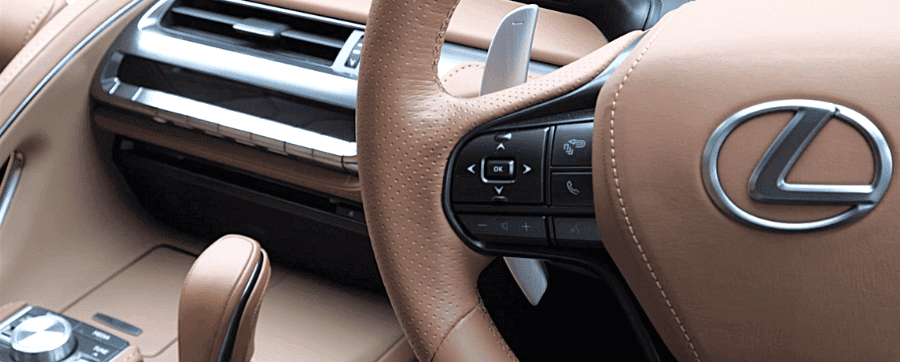
As we’ve already touched upon, the Lexus LC500 Convertible has an automatic transmission and 10-speed auto, with all of the controls conveniently placed next to the driver.
Next to these controls are the media controls, so you can easily navigate between the radio and your media if you connected your phone with Bluetooth, Apple CarPlay, or Android Auto. From there, you can select a track, tune the radio, and adjust the volume quite easily while on the move.
There is also a touchpad for the infotainment screen. Further down the centre console are the roof controls and the driver’s window control, hidden by a flip-up cover that matches the interior.
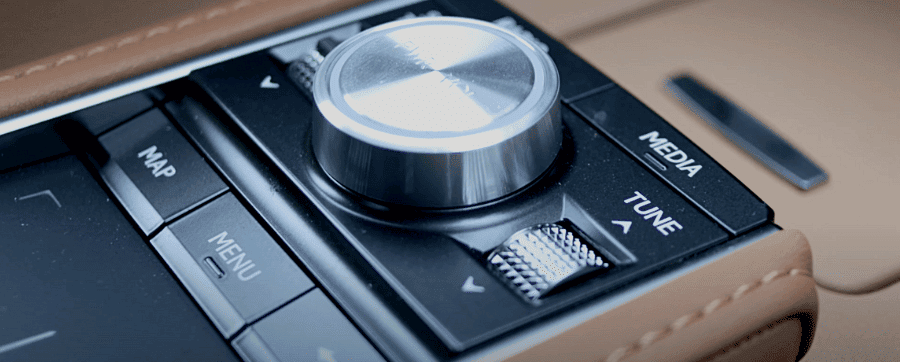
Between the seats, under a sliding top, is a small storage compartment, perfect for sweets or snacks, but if you slide the top back, it will open from the side, revealing a deep storage compartment.
Inside are a couple of USB ports, an Aux-in socket for your phone, and a 12-volt socket for charging your devices. We were impressive as there’s quite a lot of storage to be had in the cabin overall.
Other features inside the cabin include a handle to the left of the centre console for the passenger to hold on to if you’re skyrocketing down the road.
Lexus has also continued to include analogue clocks, complementing the infotainment display, highlighting a contrast between old and new technology, which we enjoyed.
The front passenger also has a net to the right of their feet, on the side of the centre console, which we don’t often see.
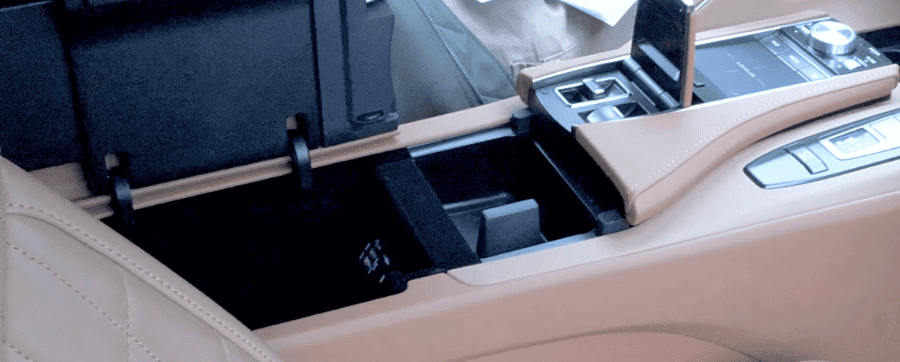
On the whole, aside from the rear space, we were impressed with the quality of the interior with the premium and plush interior materials and with the high-quality tech on offer.
What do you need to know about the Lexus LC500 rear seats?
To get in the back of this Lexus, you do need to mess around with the seat adjustability and slide the seat forward. Once the seat is pushed as far forward as possible, you still are left with quite a tight gap.
Once, you’re able to get in the back, once the driver or front passenger pushes the seat back, it does feel cramped with the seats touching our knees quite aggressively.
There’s not a lot of storage either: there’s no door pocket and there’s no pocket in the back of the seats for a tablet or magazine. You can take advantage of the centre compartment, but you have to awkwardly reach over into the front cabin to open it.
There are a couple of Isofix fittings on either seat, so, you could attach a child’s chair but overall, we were quite disappointed with the “backseats”.
On a positive note, the seats themselves are quite comfortable as they’re nicely padded and adorned in the same gorgeous leather, found in the rest of the interior.
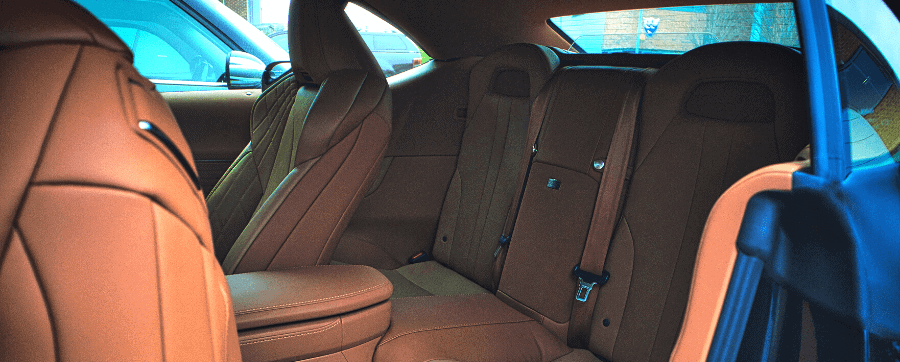
What are the Lexus LC500 engine specs? What about the car’s carbon emissions?
This Lexus LC500 Convertible is powered by a mighty five-litre V8 engine, producing up to 457bhp and 530Nm of torque, providing you with an incredible 0 to 62MPH time of just 5 seconds, with a top speed of around 168MPH.
As touched upon earlier, this car is configured with 10 Speed Auto, a fantastic transmission which smoothly glides through the gears and gets up to speed extremely quickly.
If you want to experience a manual driving mode, you can turn on that option and play around with the paddle-shifters to mimic the gear changes.
All the previously-mentioned power is sent to the rear wheels, allowing the car to be very sporty and quite agile when navigating around tight corners and bends. It’s certainly an extremely fun car to drive.
Unfortunately, this exhilarating performance comes at the cost of poor fuel efficiency, so, expect around 24.1mpg on the combined cycle which isn’t great.
If you want to maximize this as much as possible, you can put the car in the “Eco” or “Comfort” mode, however, you won’t be enjoying this car as much as you can.

Again, CO2 emissions are not very good, outputting around 275g/km on the combined WLTP cycle, meaning this Lexus LC500 is in the highest band for the benefit-in-kind company car tax rates.
If you want to take advantage of these significant savings there is a hybrid version of this model that may be worth considering.
How can you configure the Lexus LC500 Convertible?
Standard Convertible Trim
Let’s start with the standard Lexus LC500 Convertible trim. This will set you back £99,845 and it comes with a wealth of standard equipment, which is great considering the price tag of this vehicle.
Firstly, you get 20-inch alloy wheels and a gorgeous four-layer soft-top roof with a very premium feel. You also get a host of safety features courtesy of the Lexus Safety System pack.
This includes road sign assist, blind-spot monitoring, lane keep assist, cruise control, and lots of other safety features, making sure all of your safety needs are met.
The vehicle is also fitted with adaptive variable suspension with six different driving modes, allowing you to customize the driving experience to your particular needs, whether you want to stick it in Eco to save on fuel, Comfort, if you just want a leisurely experience, or if you want to eke out as much performance as possible, then you can stick it into Sport S or even the Sport S+ mode.
You also get 3i LED headlights with automatic high beams. Front and rear parking sensors come with this vehicle; these are especially handy if you’re moving over from a different body style to this rather long vehicle as it can take some time to get used to it, so the parking sensors will come in handy when navigating in and out of tight gaps.
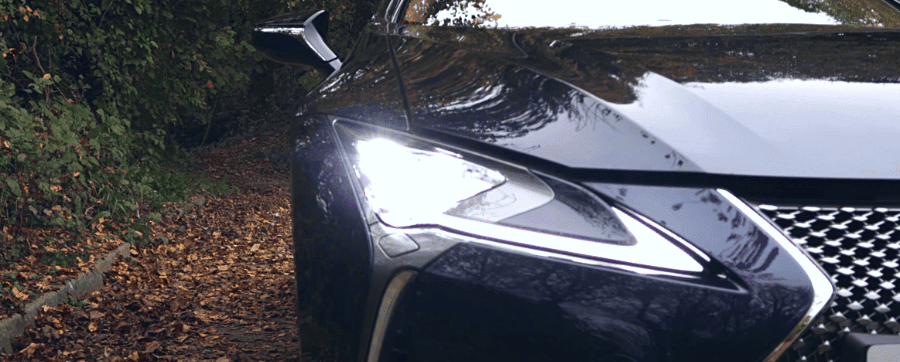
Inside the cabin, you get smooth leather upholstery for the front seats. On the other hand, the back seats are adorned in Tahara man-made leather.
The front seats are also heated and ventilated, and they’re also eight-way electrically adjustable with two-way power lumbar support, allowing you to find the most comfortable driving position.
Additionally, they also come with a memory function that allows you to press a button and the seat’s configuration will be saved, allowing you to have the perfect driving position when you re-enter the car. The steering wheel is also electrically adjustable and heated.
In terms of tech, the Lexus LC500 Convertible is fitted with the 10.3-inch Lexus premium navigation system, which is also hooked up to a 12-speaker audio system.
You also get Apple CarPlay and Android Auto and a reversing camera, which, again, is handy for getting out of tight parking spaces, especially when considering the length of this vehicle.
Overall, an extremely impressive wealth of equipment is offered by this entry-level model. Surprisingly, you would expect to see a lot of these features on higher-grade Lexus and Toyota models, so we enjoyed seeing these high-tech equipment features offered on the entry-level trim.
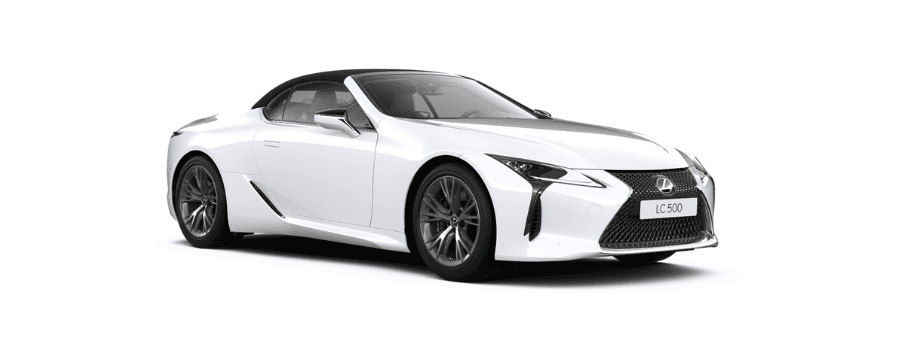
Sport Pack Plus
The only other trim level or “pack” as Lexus calls it, is the Sport Pack Plus. This starts from £105,695 so quite a significant premium over the entry-level model.
With this grade, you get gorgeous 21-inch forged alloy wheels, semi-aniline leather upholstery for the front seats, and neck heaters, which is not a common feature as it’s something you don’t see in a lot of cars these days.
The car is also fitted with carbon-fibre scuff plates with Lexus inscription and a Torsen® Limited Slip Differential.
So, if you want to maximize the sportiness out of the LC500 as much as possible, then you do need to go for the Sport Pack Plus, however, do weigh up if these couple of features are worth the almost £6,000 premium.
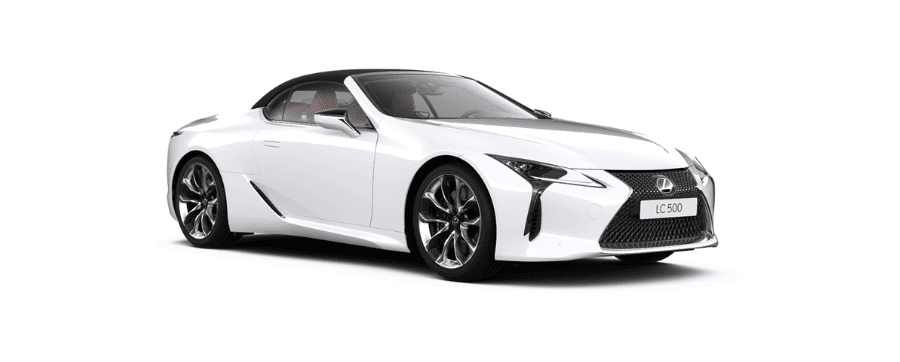
What optional features are available?
It’s also worth highlighting the available optional features: you can configure the 21-inch forged alloys, semi-aniline leather upholstery, and neck heaters to the entry-level model as they’re available as optional extras.
Other optional features include the head-up display (£1,250), which we selected and found to be very helpful, so make sure to consider that if you want your driving information projected right in front of you, so you don’t miss it while on the move.
There’s also the 13-speaker Mark Levinson ® premium surround sound system (£1,000), which sounds brilliant. There are also some “Special Metallic” paint options for an extra £500.
If you like the sound of any of these features, make sure to have a look through them and see if you want to add any of those to your configuration.
Should you buy, lease, or finance a Lexus LC500 Convertible? Is the Lexus LC500 reliable?
Well, if you’re looking for a car that’s extremely fun to drive, thanks to that exquisitely powerful roaring engine, coupled with a nicely and beautifully-designed interior, with lots of high-quality materials, then this is a fantastic convertible for you.
Another thing you do need to take into account is Lexus’ incredible reliability record. This car is very unlikely to break down on you and even if it does, the service that you’ll get from the Lexus team is second to none, which we can’t say is going to be the case for this car’s premium German rivals.
What are some downsides of this vehicle? Firstly, you have to be very conscious when going over speed bumps due to that low-riding position as you don’t want to knock the front of the car.
Also, it doesn’t do a great job of handling imperfections in the road, meaning you will feel the impact of potholes and awkwardly sized drains when driving over them as they’re going to reverberate throughout the cabin.
We have seen some motorists have complaints about the infotainment system, and while we prefer the infotainment setups in BMW and Mini models, we didn’t mind it that much.
Lexus is introducing a new infotainment set-up with the new NX and hopefully, the next revision of this model will have the newer set-up which looks much more promising.
However, our biggest complaint was the poor level of practicality: the boot space is pitiful and the rear bench needs to go entirely as you can’t fit two adults in there as it’s an incredibly tight squeeze.
We found this car to be made for two adults and two adults only. By getting rid of that rear space, it could hopefully make the boot space a lot larger to fit more stuff in the back which would just increase the practicality.
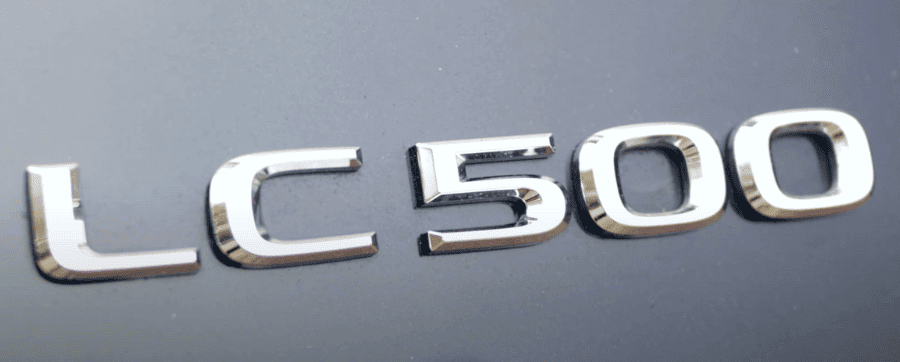
Overall, we enjoyed our time with the fabulous Lexus LC500 Convertible.
If you’d like to find out more and get a bit more info from OSV’s Vehicle Specialist and get the ball rolling on delivery, then make sure to get in touch today on 01903 538835 or click the banner below to book a consultation at a time that works for you.
If you’d like to get a better look at this convertible, check out our full Lexus LC500 Convertible video review over on our YouTube Channel, and make sure to subscribe if you want to see more in-depth vehicle reviews. Alternatively, you can also read more of our written car reviews.
Lexus RX 450h Review: Is this Hybrid Perfection?
- What do you need to know about the exterior of the Lexus RX 450h?
- What boot space does the Lexus RX 450h offer?
- What is the Lexus RX 450h like to drive?
- Is the Lexus RX 450h’s interior as good as it looks? What tech does it feature?
- How is the rear of the Lexus RX 450h’s cabin?
- What Lexus RX 450h engines and trims are available?
- Should you buy, lease, or finance a Lexus RX 450h? Is the Lexus RX 450h reliable?
Want to go hybrid with your next car? How about a comfortable spacious tech-laden and quiet luxury hybrid SUV, perfect for businesses or families? This is the Lexus RX and, in this review, we’re going to give you all the information that you need, so you can decide if this is your perfect next car.
If you’re in the market for a premium SUV, you are truly spoiled for choice. Popular offerings in this segment include the BMW X5, the Audi Q7, and the Volvo XC90, just to name a few.
This Lexus RX aims to stand out from its competitors with a keen focus on distinctive styling both inside and out. With a nicely upholstered interior with gorgeous build quality and, perhaps most importantly for most drivers, a comfortable and refined driving experience.
Unlike the majority of its rivals, it’s thankfully pretty easy to get your head around the RX line-up; there are just two models to choose from. We had the regular five-seat RX to review, however, the larger 7-seat RX L is also available in case you need extra space.
Both models are equipped with the same engine, as there is just one engine option, and they come with a choice of three different trim levels: the standard RX, the sporty “F Sport” and the refined “Takumi”.
What do you need to know about the exterior of the Lexus RX 450h?
Let’s explore what makes this RX so special by starting with the striking front end. The design is very familiar if you’ve seen a Lexus on the road before, but it’s still quite distinctive and unique when compared to its rivals, and it does stand out on UK roads.
We were quite a big fan of Lexus’ spindle grilles and loved how it flows down the front of the car. We also loved how the badging is housed in the middle and displayed prominently, letting you know that this is a luxury car.
We loved how the design flows inwards towards the side vents, giving the car quite a lot of personality. We were also a fan of the steel material that just wraps around that grey grill, with sleek lines flowing back, over the bonnet, towards the sides of the vehicle.
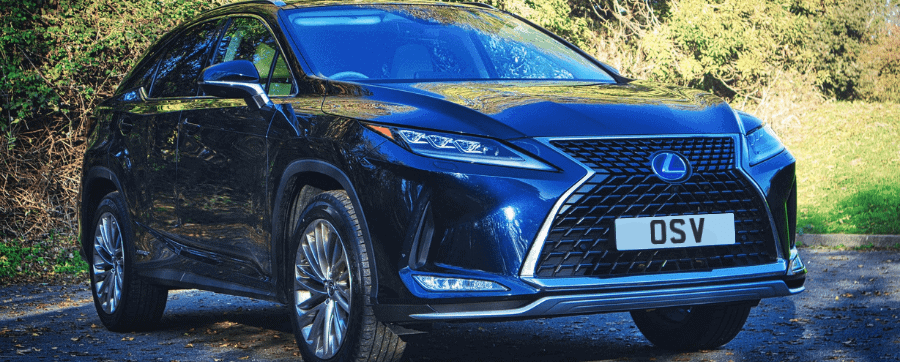
LED headlights come as standard, regardless of which model you go for, which is great to see. If you just opt for the standard RX and RX L, you get the auto-high-beam systems which are particularly handy for night-time driving.
If you upgrade to the “F Sport” or “Takumi” trims, you also receive the BladeScan adaptive high-beam system, which is essentially an auto-dimming system, able to identify pedestrians and road signs from a greater distance, giving you greater night-time visibility.
So, if you’re somebody who gets anxious about driving at night in those cold winter months, then we do recommend upgrading to those higher spectrums to just ease your worries. Other highlights of the front include LED daytime running lights and fog lights that come as standard.
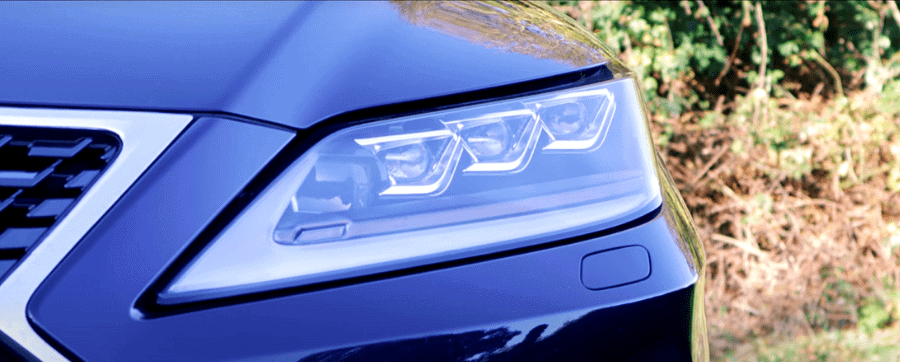
The side profile is also really sleek, we loved the sharp lines flowing down the length of the car as it makes for a very clean and uncluttered appearance.
As for the door mirrors, they’ve been designed to reduce wind noise as much as possible and they’re heated so very convenient for those cold winter months. They tilt downwards when you reverse, making it easy to see the curb and manoeuvre out of tight parking spaces.
If you opt for one of the higher-spec trim levels, they will be auto-dimming, reducing the chances of you getting dazed by other road users. As you can tell, a lot of thought and care has been put into the mirrors.
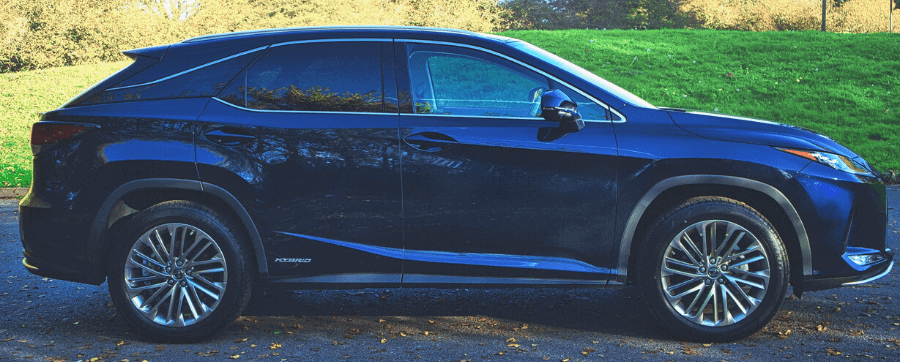
As for the alloy wheels, we had gorgeous 20-inch 10 twin-spoke alloys, in a chrome finish. These are included with the “Takumi” trim level, however, as standard, the wheels will still be 20 inches (though these will be five twin-spoke wheels in a dark grey finish).
You can also configure the car with optional 18-inch silver wheels which are designed to provide optimal driving balance. It is worth noting, however, that we had no issues with the 20-inch wheels, which ended up reducing the impact of aggressive humps and bumps, so that is something to consider.
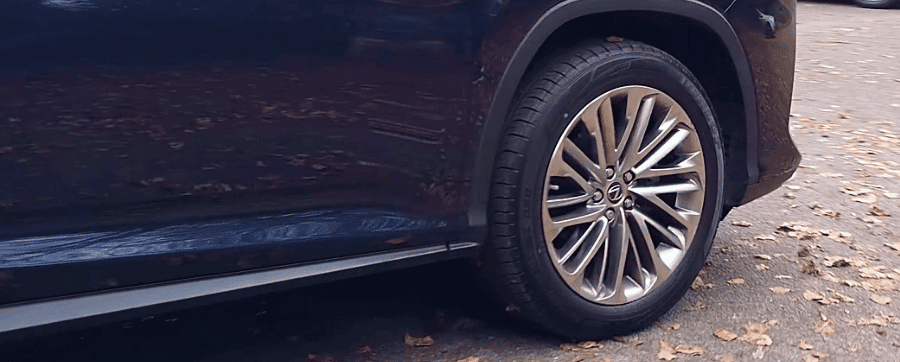
There is hybrid badging on the rear passenger door to remind you that this is a self-charging hybrid vehicle, which we’ll go more in-depth about further in the article. The door handles will be in the same body colour you’ve chosen.
We opted for “Deep Blue”, which is a metallic option. That will set you back around £670 and you see the rest of the colour options below, including the special metallic colours that will set you back around £920, so you’ll have to weigh up whether it’s worth spending nearly a grand on just the colour of this vehicle.
If you’re not interested in paying extra, “Velvet Black” is the standard colour.
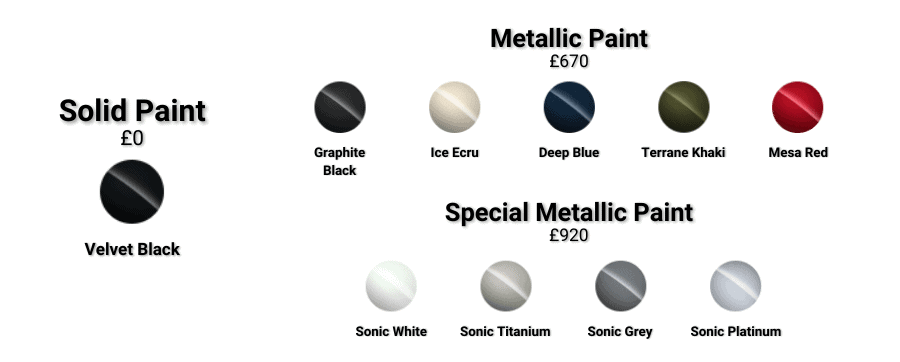
Towards the rear, you’ll spot the rear privacy glass and roof rails that come as standard. We also had a panoramic sunroof, which you receive the top-spec “Takumi” trim level.
The fuel cap is quite rigid, it’s not going to fall off, which is great to see. On the rear of the Lexus RX 450h, you receive a rear spoiler to give the impression that the car is sporty, which it most certainly is not. However, we did love the design of the rear LED light clusters.
We loved how angular they are and how they flow into the steel material. This is a very clean looking rear-end, while also being angular and not over-complicated, which we liked.
What boot space does the Lexus RX 450h offer?
To get the boot open, you don’t have to do much as it’s a power-operated tailgate. It takes a little bit of time to open up but it will get there eventually. There are 453 litres of space to work with, which is okay but not great. Lexus has prioritized interior passenger space over boot space here.
Meanwhile, you’ve got rivals like the BMW X5 that offer a whopping 650 litres of space, so by comparison, it’s a little bit disappointing. This is enough room to fit six small carry-ons and there’s hardly any kind of lip so it’s easy to load awkwardly sized items into the back.
Alternatively, you can fit two large suitcases instead. While this is not as cavernous as other luxury SUV offerings, there should be more than enough space for the weekly grocery shop or small family holiday up the country.
If you do need to maximize luggage capacity as much as possible, you can do so by folding down the rear seats in a 60-40 arrangement, without needing to awkwardly lean over to pull a lever or head over to the passenger side.
On the right-hand side of the boot, there are buttons that you hold down, causing the seats to fold down electronically. We loved this feature and its convenience. It comes as standard across the RX range, giving you around 1,924 litres in total, which is enough room for one adult bike without needing to remove the wheels.
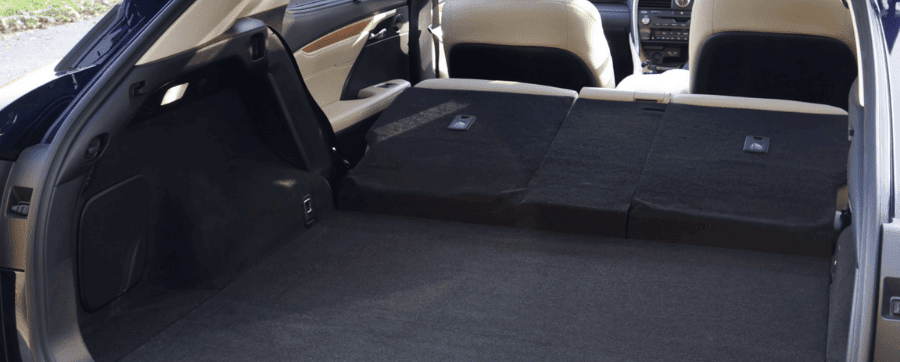
The tonneau cover can extend outwards and attach to indents on the side of the boot. You could put some objects on the tonneau cover; however, it is slightly flimsy and they may roll around while you’re on the move.
Alternatively, you might want to attach those to one of the hooks dotted around the boot space. There’s one on the right side of the boot and some more towards the back. The under-floor storage is okay.
We had a spare wheel taking up a lot of the space, however, if you didn’t have one, there would be a fair bit more space to work with.
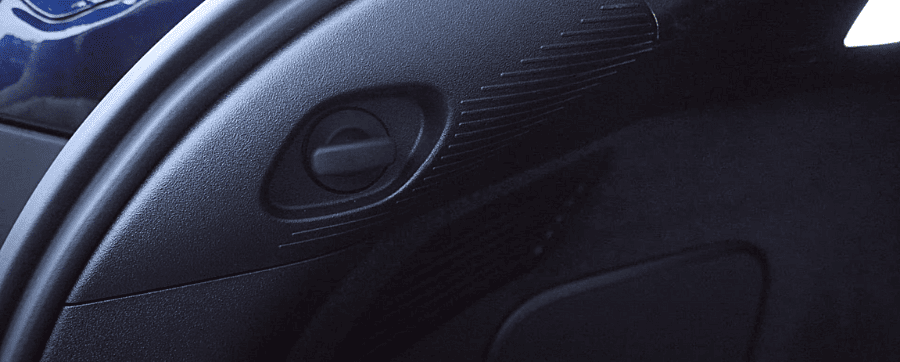
The rear bench, when it’s folded down, lays at a slight angle and there is a lip in the floor, making it awkward to load objects such as long bits of wood or skis.
We would have preferred this section to be completely flat but that is just a minor criticism. A fantastic feature of the bench is that you can slide it forwards and backwards.
So, if you’ve got a rear passenger who’s willing to sacrifice some leg room, you can increase the size of your boot. We found it fantastic that the RX offers such an excellent level of practicality in this regard.
What is the Lexus RX 450h like to drive?
When we got behind the wheel of the RX 450h, our first impressions were very positive; it was incredibly comfortable, smooth, and relaxing to drive, the seats hold you in place when turning, and the steering is nice and light for a vehicle of this size, it makes it very convenient and easy to get from A to B.
The accelerator pedal is quite soft and responsive, which is great as it doesn’t take too long to get used to. The brake pedal was quite firm, which you’ll notice when you come to a junction or a roundabout when you need to make a complete stop.
We didn’t have any problems with this whatsoever. It was also responsive, meaning you won’t need to start braking too early.
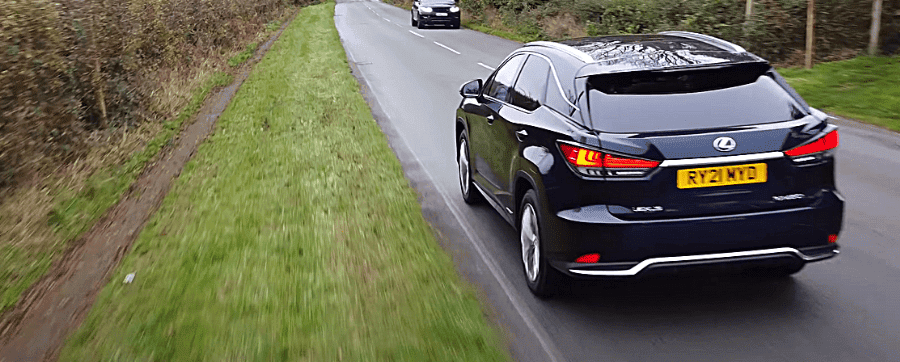
What’s the tech like while you’re on the move?
We configured this car with the head-up display, which we found to be handy. It projects your speed, and the speed limit of the area, directly in front of you so you don’t need to glance down at the driver display.
We loved this and would configure it in the majority of vehicles if given the option. Just below that is the driver display with quite a lot of information.
There’s a smaller display in between the speedometers that shows information such as how efficient you’re being on your journey, the temperature outside, and the time.
We found it very nice that you can cycle between lots of key information, while also being quite easy to glance down and read it.
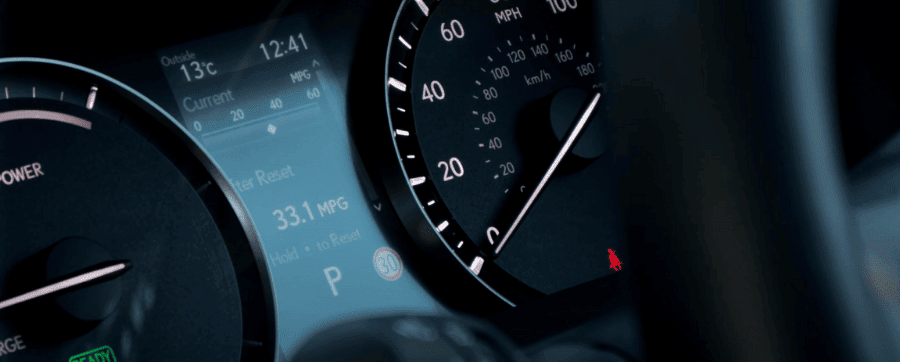
Next up is the infotainment setup, we liked how high up it was on the dashboard, making it very easy to glance over and see what you need to see and then glance back at the road.
We would have liked it to be angled slightly more towards the driver, however, otherwise, we liked where Lexus has positioned it in this vehicle.
What is the ride height like?
Well, you sit quite high up in this car, which gives you fantastic visibility of the road ahead and the area around you. The windscreen is nice and wide and the pillars don’t affect the visibility with their size, allowing you to have great visibility.
We found the door mirrors to be, quite frankly, humongous. You’re able to see a large distance behind you, which is great, and the view outside the rear window isn’t too bad either, it’s a lot better than what you would find in a coupé SUV.
Because they have physical buttons, the climate controls are also very easy to use while on the move. You do also have the option to change them through the infotainment screen.
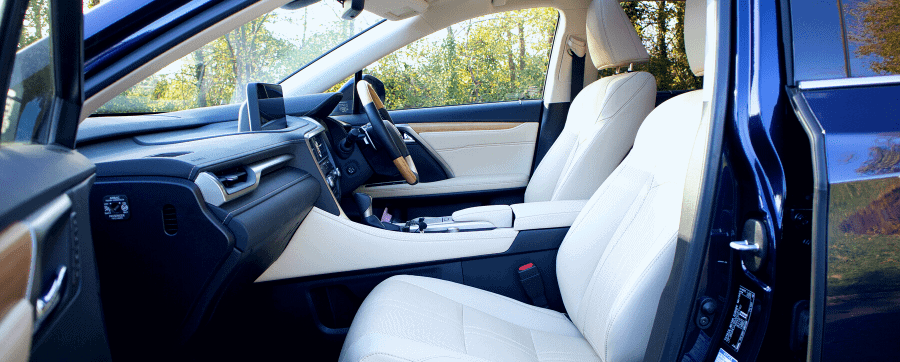
Are you impressed by the RX 450h so far? Let us know what you make of it and if you’d like to find out more at this stage or you’d like to explore your options to find your perfect specification.
Get in touch with OSV’s Vehicle Specialists on 01903 538835 or you can just click the banner below to book a date and time that best works for you to have a chat.
Is the Lexus RX 450h’s interior as good as it looks? What tech does it feature?
Let’s dive into the Lexus RX’s gorgeous interior. We opted for the rich cream semi-aniline leather, complemented by wood inlays dotted around the cabin which are only available with the “Takumi” pack.
We loved how the wood inlays are used very effectively and sparingly providing the cabin with a quite minimalistic feel, meaning when it’s used, it stands out nicely. It’s used on the inside of the doors and down the centre console, as well as the steering wheel, sliding into the leather.
There are a variety of interior options, so if you’d like to find the one that suits you perfectly, then make sure to get in touch with one of our Vehicle Specialists.
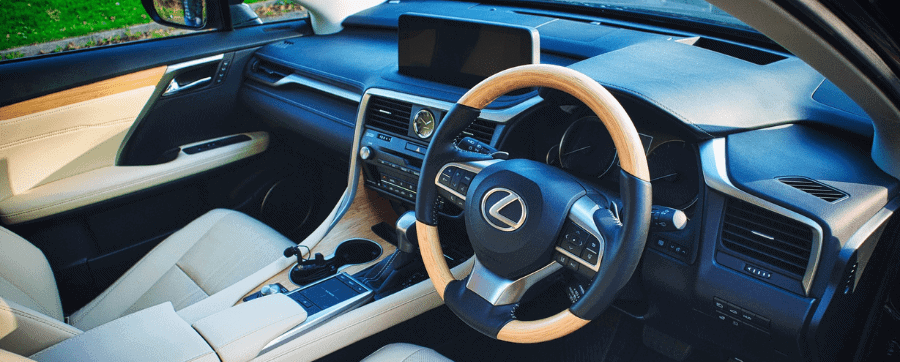
Speaking of the steering wheel, there are media controls on the left-hand side and cruise controls on the right. You’ve got paddle shifters behind the wheel, allowing you to do manual shifts should you so choose.
Further behind the steering wheel is the driver display. Once the car is booted up, it shows you all the key information that you will need when going from A to B.
On the right-hand side is the speedometer and, on the left, it shows you how much charge is left in the self-charging hybrid battery. In between these dials is a compact 4.2-inch media screen. You can toggle between the different options by pressing a button on the right-hand side of the wheel.
It will cycle between different pieces of information, including how fuel-efficient you are on your current journey, a compass and which radio station, album, or podcast you’re listening to. We found it very nice to have all that information right where you need it.
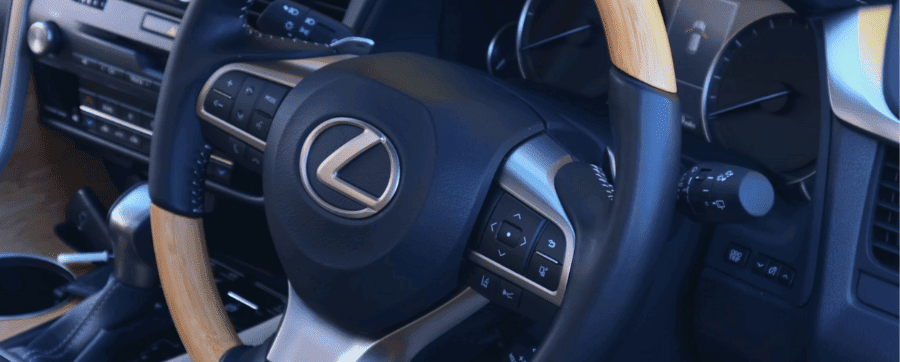
As for the infotainment display, the 12.3-inch media touchscreen comes with Lexus Navigation, Apple CarPlay and Android Auto as standard, so if you get fed up with Lexus’ software implementation, then you can always mirror your smartphone apps onto the display.
Overall, we were a fan of the Lexus setup, while it is a little fiddly to type into an address using the touchpad, especially on the move, it is good that you can also just use it as a touchscreen if you want to.
As mentioned earlier, we would have liked the screen to be angled slightly more towards the driver. It does sit quite high, which makes it convenient to just glance over and get a good look at the screen, and then go back and focus your attention on the road ahead.
Above the screen, there’s an auto-dimming rear-view mirror preventing you from being dazed by cars behind you.
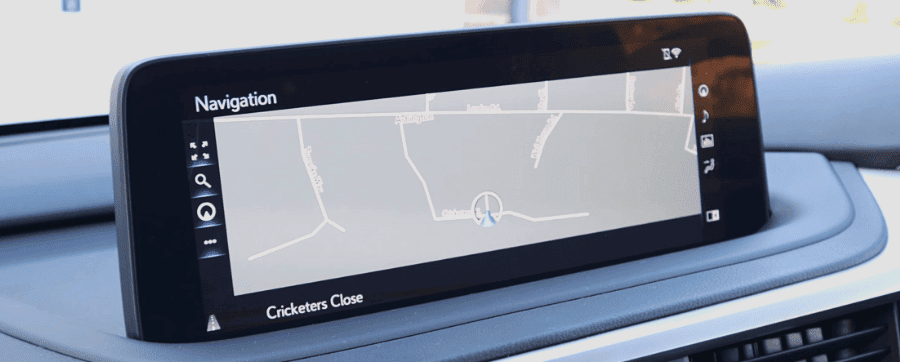
As for the centre console, we loved the implementation of the Lexus analogue clock in the middle, in-between the air vents. This gives the cabin more of a premium feel. The climate control is dual-zone with the wider air vents working well. Just below is the “Takumi” pack-exclusive 15-speaker Mark Levinson premium sound system.
As you would expect, it sounds fantastic. In the centre compartment area, there is a 12-volt socket for charging a laptop or tablet and a couple of USB ports. Right next to these sockets is a little storage area, perfect to put your phone in while it’s charging.
There is also a wireless smartphone charging pad, which comes as standard, which you rarely see as a standard feature. Behind that are the controls for the heated and ventilated seats. We did have a bit of an issue with these as they are a little hidden away behind the gear selector, making it inconvenient while on the move.
Further down the centre console, between the two seats and next to the gear selector, there are a couple of adjustable cup holders, meaning you can fit bottles, cans, or cups comfortably inside. There is also the touchpad for the infotainment display and there are shortcuts to the map and menu, with a nice bit of haptic feedback while you’re scrolling your finger across, which we liked the implementation of.
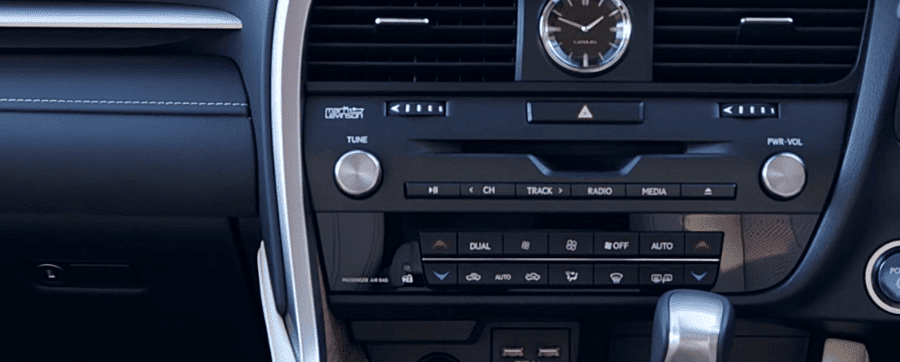
You also have the toggle for the driving mode selector. However, like the Lexus UX 300e and the LC 500 convertible, we wished it was up on the dashboard, making it easier to toggle while you’re on the go. That being said, we didn’t have any issues with it while driving.
As standard you get four different driving modes these are Eco, EV, Normal and Sport. “F Sport” and “Takumi” trimmed models and Sport S, the sportier driving modes, get adaptive variable suspension which either sharpens or softens the ride, depending on your driving style.
It also improves engine responsiveness, makes the engine a whole lot louder and adds a bit of weight to the steering. We recommend keeping the car in Eco for a lot of your time, though the performance won’t be particularly exciting, you’ll be maximizing fuel efficiency as much as possible.
Then, when you get to a junction and you want to get off the block quickly, stick it into Sport and you’ll have no problems doing that. You can also do short journeys around town using that 288-volt battery pack when you stick it into EV mode, however, it won’t last long as it does deplete quickly, but it’s nice to have the option of doing an all-electric journey.
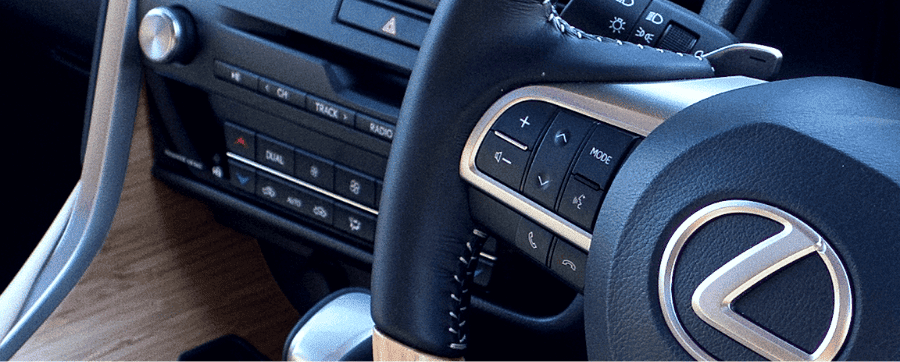
The last couple of storage areas include a nice deep and spacious centre compartment between the two front seats. There are a couple of USB ports, an Aux Port, and another 12-volt socket, so all of your charging needs are very well covered by the Lexus RX.
As for the glove box, it’s pretty spacious, but our highlight of the storage is the fold-out door bins. While it is simple, we found it to be such a great idea, allowing you to fit a 500ml bottle or a flask inside.
With the “Takumi” trimmed models, you do get the panoramic sunroof that stretches about three-quarters of the way across the roof lining. However, the roof itself only retracts about the length of the front passenger side, which is a little bit disappointing.
But it’s really easy to do while you’re on the move as the buttons are just above the rear-view mirror. By holding it down for a second, it will retract and let lots of light into the cabin, which greatly benefits from being brightened.
The seats inside this Lexus RX 450h are exceptionally comfortable for long journeys and there’s a great amount of adjustability to be had. You’re able to adjust the height and you can almost fully recline. Finally, the sun visors are wrapped in a luxurious and soft material, matching the rest of the interior.
How is the rear of the Lexus RX 450h’s cabin?
As for the back of the Lexus RX, it is very comfy and passengers over six feet tall are not going to have any issues with headroom. The legroom is equally as generous as we were able to stretch our legs out all the way which is always great to see.
There are also some nice soft-touch materials just below the driver’s seat, which cossets your feet in place. The pockets behind the front seats are very spacious, with plenty of space for your tablet or magazine.
There’s also another showcase of the wood inlays and leather effect on the door which complements the steel door handle.
You also receive a retractable privacy shutter which you can put up, covering the window, if you want to stop people peering in or if you’ve got kids in the back and you want to get some shut-eye after a long day at a theme park or something.
In between the front seats, you have a couple of air vents, though you will be at the mercy of the front passengers as there are no controls in the back, however, “Takumi” trimmed models get heated rear seats, which is fantastic to see.
There are also a couple of USB ports below the vents, perfect for charging your phone. Isofix fittings are also fitted on either side of the rear passenger seats.
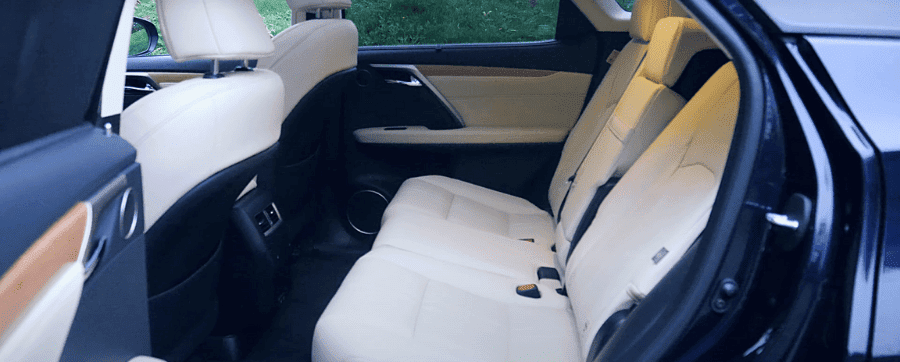
If there isn’t a middle passenger, you can fold part of the seat down and open it up to find a nice storage area that you can use to put some snacks in for example and there’s a button to fold out the cup holders.
While these aren’t adjustable, they will still hold your drinks in place and stop them from spilling while on the move. The middle seat isn’t too bad to sit in, however, due to the cupholders inside the seat, it does stick a little into your back.
Also, there is no elevated floor for the middle seat passenger, making it a much more comfortable seat than what you’d see in a lot of other vehicles. We were wowed with this Lexus RX’s interior.
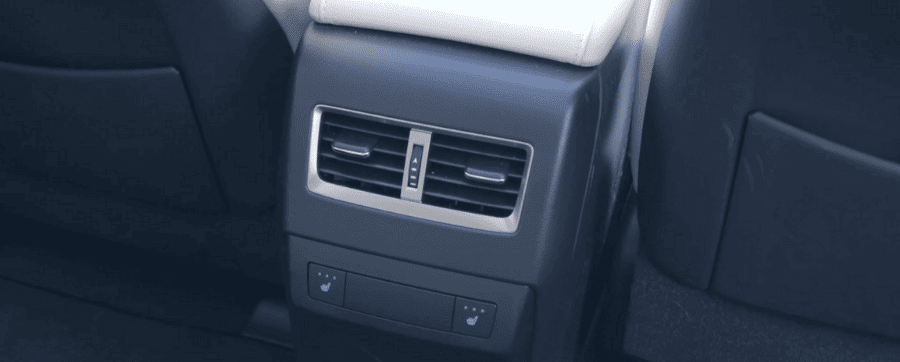
What Lexus RX 450h engines and trims are available?
3.5L Hybrid Engine
There’s only one powertrain available, which keeps things simple, it’s a 3.5-litre hybrid engine, paired with an eCVT automatic gearbox that sends power to all four wheels via two electric motors.
This powertrain setup produces around 308 brake horsepower and achieves a 0 to 62 MPH time of around 7.7 seconds. While that sounds pretty quick, this car is quite sluggish off the block, especially in Eco mode.
That is due to poor throttle performance and also the eCVT transmission, which, unlike a conventional gearbox with the mechanical setup, it doesn’t change through the gear seamlessly, it just switches between a different gear ratio.
This does add to the smooth and relaxing driving experience, but it doesn’t mean that it’s particularly exhilarating. We were a little bit disappointed by the fuel efficiency and CO2 emissions, considering the hybrid nature of this vehicle.
It quotes around 35 to 36 MPG on the combined cycle, which isn’t great as you’ll be making regular fuel stops as a result. Additionally, CO2 can be as high as up to 180 grams per kilometre, which puts it in one of the top benefit-in-kind tax brackets, meaning this isn’t the best option for a company car.
However, you do have other Lexus models like the UX 300e, which is all-electric and in that 1% BIK tax bracket, so you can take advantage of all those amazing savings with that vehicle instead.
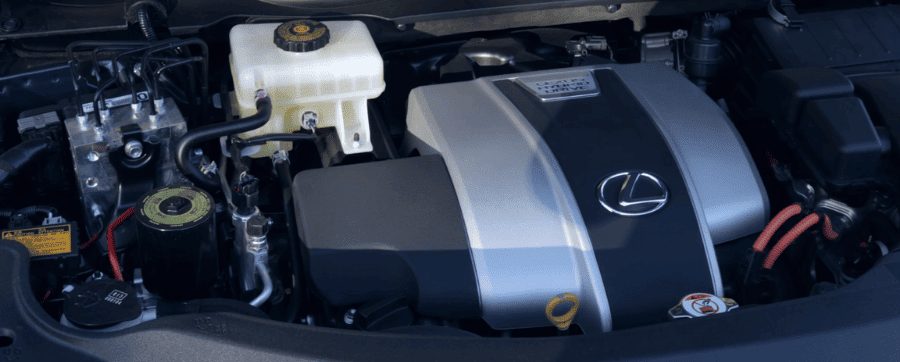
Standard Trim
As for trim levels, let’s start with the “RX Standard”. This starts from £53,865 and for this price tag, you receive a lot of standard equipment. This includes 20-inch alloy wheels and a host of our safety features courtesy of the Lexus safety system pack.
This includes road sign assist, adaptive high beam, cruise control, and lane keep assist, all the features you would expect in a modern vehicle. Inside the cabin, you will receive the 12.3-inch Lexus navigation display, which we loved, and Apple CarPlay and Android Auto.
You also get intelligent front and rear parking sensors, so if you’re not used to a vehicle of this size, it will be especially handy when trying to manoeuvre in and out of tight parking spaces.
You also receive electrically-adjustable eight-way adjustability for the front driver’s and passenger’s seats. Meaning, that both the driver and passenger can play around with their configuration to find the most comfortable position for them.
Finally, you also get an electric tailgate which is especially handy for when you go shopping and need to throw your shopping in the boot.
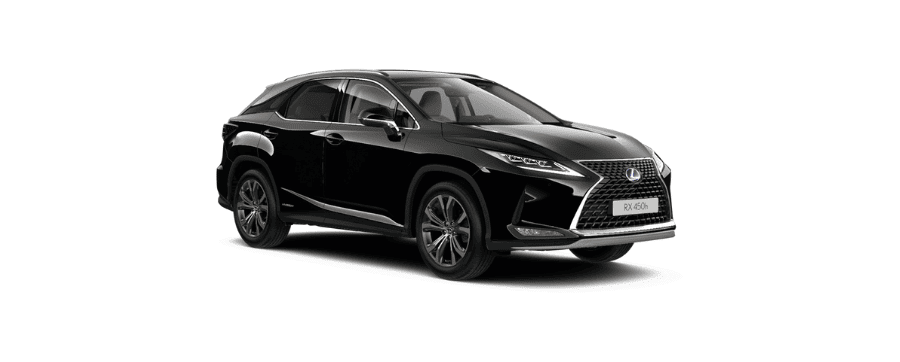
Premium Trim
Next up the ladder is the “RX Premium”. This starts from £55,515 and if you want to maximize as much as you possibly can out of the basic RX specification then you do need to go for this trim.
This adds two-way lumbar support for the driver’s seat, so another additional comfort feature, as well as smart-keyless-entry, so, you just have to walk near the car and if the key is in your pocket, it’s going to open for you, which is another practical feature.
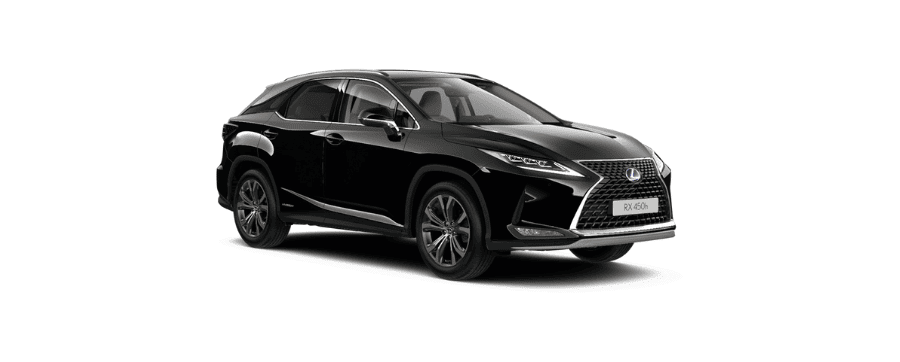
Premium Sport Trim
The mid-level trim is the “Premium Sport” edition, and this starts from £57,165. The wheels are still 20-inches but they have a black sputtering effect to suit that black exterior styling which affects the front grille and the mirrors.
The overall package looks extremely nice and if you like what Audi does with its “Black Edition” models then you’ll love what Lexus has done with the RX. In addition, you get heated outer rear seats, so your rear passengers should not be moaning while on the move.
You also get smooth leather upholstery inside the cabin, as well as a head-up display, which we loved as it displays all the information that you need right onto the road ahead, which is very handy.
You also get a panoramic sunroof which lets lots of light into the cabin. We were quite pleased with the really impressive equipment on offer with this mid-range trim.
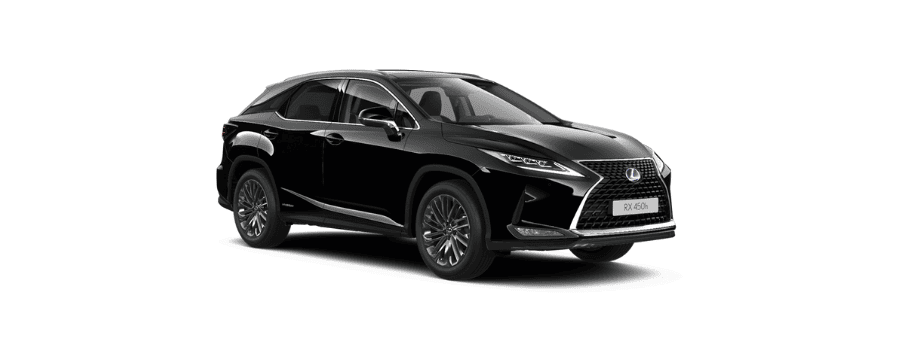
F Sport Trim
If you’re all about that sporty lifestyle, you have to go for the “F Sport” trim level. That starts from £58,015 and the 20-inch alloy wheels are outfitted with “F Sport” styling as has the overall exterior.
F Sport badging is dotted around the vehicle, and the black spindle grille and metallic front bumpers create a stylish overall look. You also receive the additional “Sport+” mode, meaning you get five driving modes to play with.
The vehicle is fitted with adaptive variable suspension to adapt to whatever kind of terrain you’re driving on. This maximizes your driving experience. Finally, you also get ventilated front seats inside the cabin.
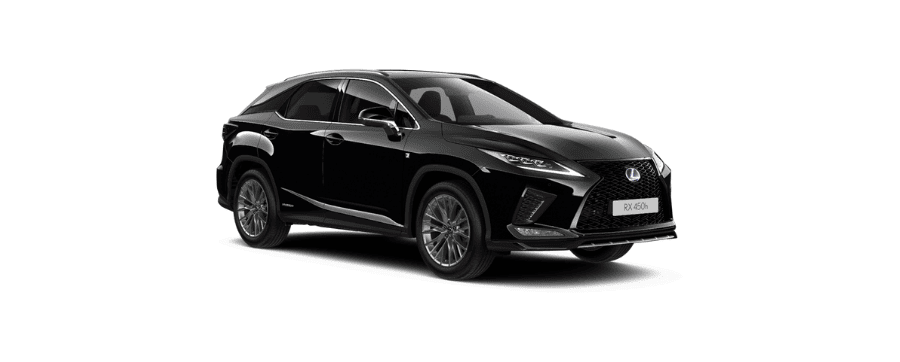
Takumi Trim
Last up is the top-level trim, the “Takumi”, which is the configuration we chose for our review. It starts from £64,515 and it maximizes the overall package.
With this trim, the cabin is fitted with a 15-speaker Mark Levinson surround sound system, which audiophiles will adore. The alloy wheels are still 20-inches, but they’re in a gorgeous “Takumi” design. You receive extra safety features, such as blind-spot monitoring and rear cross-traffic alert.
So, if you’re particularly anxious about driving a vehicle of this size, these features should alleviate some of your anxiety. You also get a 360° panoramic view monitor which we had a lot of fun playing around with.
As for comfort, you receive four-way power-adjustability for the lumbar support. You get the most out of the RX with the “Takumi” pack, however, you do need to decide whether these additional features are worth the extra £10,000 premium, compared to the basic model.
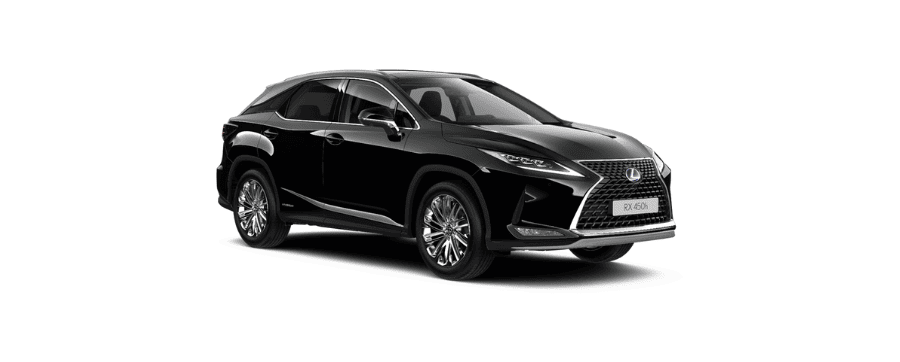
Should you buy, lease, or finance a Lexus RX 450h? Is the Lexus RX 450h reliable?
Is the Lexus RX 450h a good car?
Well, if you are looking for a luxury hybrid SUV, then we think you definitely should, due to many different reasons.
Firstly, the cabin is fantastic, it’s very well-designed and full of high-quality materials, has advanced technology, and it’s comfortable for five adult passengers, even for long journeys.
You can also take advantage of Lexus’ incredible reliability record as even if this car does break down, you’ll be safe in the knowledge that you’ll be on the road again very quickly as Lexus is one of the most reliable brands out there.
The car is also very smooth and relaxing to drive, and if you’re somebody who favours driving experience over performance then this is the model for you. We additionally loved the design of this Lexus RX 450h, it’s very clean and sleek, and not too over complicated as it’s very well thought out.
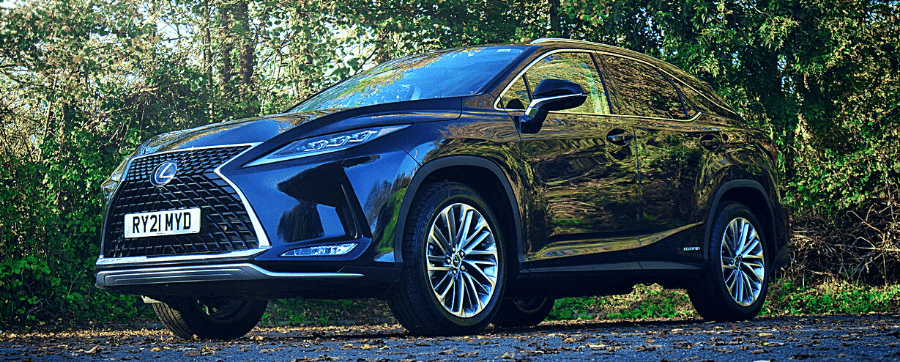
What are some Lexus RX 450h problems?
In terms of downsides, firstly, the performance has the potential to be more exciting. As a result, BMW and Audi rivals are more fun to drive.
There’s also no diesel option available as well unfortunately which means drivers who like to take advantage of the most fuel-efficient engine option can’t do so because there’s only one engine option.
Some drivers may also be disappointed by the boot space that pales in comparison with some of this vehicle’s rivals. However, in our opinion, the sliding rear bench makes up for it and it’s going to be suitable for most people’s daily needs.
Unfortunately, our biggest downside is the poor levels of CO2, especially considering that this is a hybrid vehicle. We hope Lexus improves upon this in the next-generation model.

But all-in-all, we loved our time with the Lexus RX 450h. If this is a car that you can see yourself driving, and you’d like to get the ball rolling on delivery, then make sure to get in touch with OSV’s Vehicle Specialists on 01903 538835, or you can click the banner below to book a FREE consultation to get in touch with our team of experts. Make sure to head over to our YouTube channel to watch our full Lexus RX 450h review or watch any of our other car reviews.
Lexus UX 300e Review UK: The BEST Luxury EV?
- What does the exterior of the Lexus UX 300e feature?
- What boot space is offered with the Lexus UX 300e?
- What is the Lexus UX 300e like to drive?
- What’s the interior of the Lexus UX 300e like? What tech is included?
- Is the back of the Lexus UX 300e comfortable?
- What are the Lexus UX 300e’s specs? What are the UX 300e’s range and charging times?
- Which Lexus UX trim should you buy?
- Should you buy, lease, or finance a Lexus UX 300e? How reliable is it?
Want to electrify your lifestyle with your next vehicle? Looking for something that offers superb build quality and attractive looks from a brand that delivers class-leading reliability? The Lexus UX 300e could be your perfect next car.
Lexus has been leading the way with its class-leading hybrid offerings for nearly two decades, but this Lexus UX 300e marks the luxury Japanese brand’s first foray into full electrification.
It’s essentially a fully electrified version of the UX, the brand’s smallest SUV and a very popular offering in its line-up. This review has been a long time coming as we first covered the UX 300e in a Behind The Wheel episode, in October of 2020.
We loved and had a great time with this car and we’ll tell you why in this article.
What does the exterior of the Lexus UX 300e feature?
Let’s start with the exterior design. If you’re familiar with the standard UX, you’ll be quite familiar with this front end. There have been a few, slight, exterior changes.
Firstly, there’s a larger radiator grille, acting as an air intake to cool down the battery. Of course, it doesn’t need a conventional grille as it’s fully electric. There are purple accents surrounding the Lexus logo, which we loved as it brings out the vibrancy of the design.
The headlights are LED headlights with automatic high-beam. They come as standard, however, if you upgrade to the “Takumi” pack, which is essentially the top-spec trim level, which we chose for our review, you get triple LED headlights with adaptive high beam.
This will be able to tell how light or dark it is outside and adjust the lights accordingly. Meaning, that it’s something you don’t have to worry about, making the driving experience more convenient for you.
You also get LED daytime running lights and front fog lamps as standard. We also really liked the Lexus UX’s functional side vents with gloss black material surrounding them, nicely complementing the design of the grille.
We were pretty impressed with it, but what do you make of the front end? Let us know.
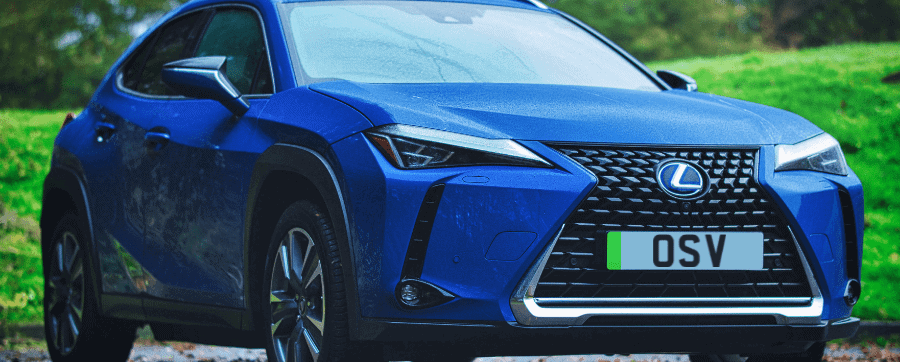
On the side profile, you’ll get 17-inch alloy wheels as standard, though, because we’ve opted for the “Takumi” pack, we have 18-inch alloys. You can also configure these as an optional extra with the mid-range “Premium Plus” pack.
We think that they look fantastic and really suit the vehicle. Of course, they also give you that little bit of extra ride height, which in our opinion, makes a fantastic difference to the driving experience.
It handles imperfections extremely well and it’s a very smooth driving experience, which we’ll talk about a little more in detail further down the review.
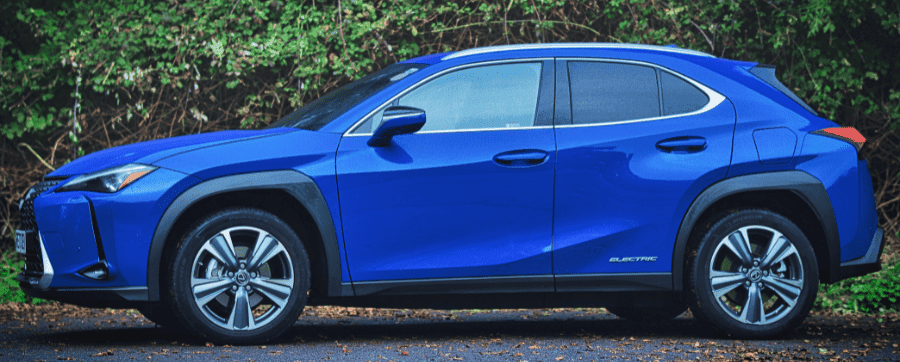
As for the colour, we chose Celestial Blue. It’s a metallic option that you can add to your configuration for around £570.
We absolutely love this exterior colour, as it nicely brings out the design of the vehicle and Lexus is pushing it in their advertisements and on press images and we completely see why as it’s a fantastic exterior colour.
There are four other metallic colours to choose from: Mercury Grey, Satin Silver, Graphite Black, and Terrane Khaki, they will also set you back £570.
There are also three premium metallic options: Sonic White, Titanium, and Blazing Carnelian.
These will set you back £820 so you’ll have to weigh up whether it’s worth paying the extra £800 for an exterior colour option. There are two standard colours to choose from: Velvet Black or Fuji Red.
These door mirrors have a gloss black surrounding them, with the body colour along the sides, which we loved the design of. If you follow the sleek lines from the front passenger door, all the way to the door handles, you’ll notice that they’re also in the body colour that you’ve chosen.
Rear privacy glass is installed for the rear cabin and it’s also nice to see that you get privacy glass on the quarter window as well. On the bottom of the rear passenger seat, there is electric badging and on the left-hand side of the Lexus UX 300e, there is the rapid charging port that can charge up to 50 kilowatts from a DC charger.
There’s another charging port on the other side of the vehicle, to plug into a wall box or domestic socket. We’ll go more in-depth about charging later on in this article.
Hiding just behind these aluminium roof rails (that come as standard) is the sunroof, which you can configure with the “Premium Plus” pack, and it comes with the top-spec “Takumi” pack as well.
We’ve got some sportier elements, such as the rear spoiler in gloss black that brings out that design just a little bit more.
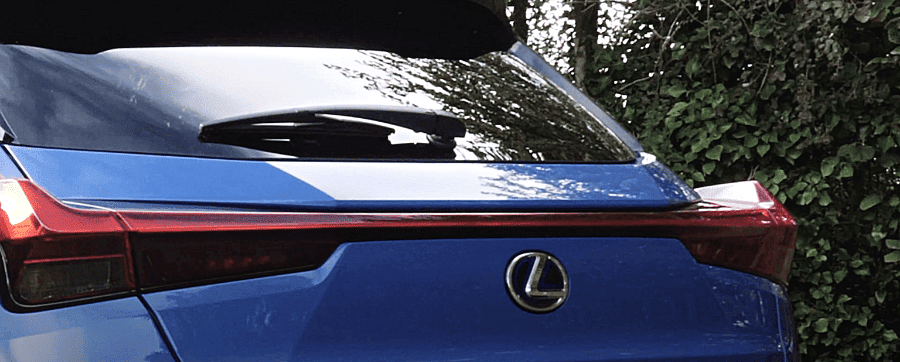
In the rear, bulging out of the sides, there are some darkened LED rear light clusters which we love. It gives the rear end an angular and muscular look, quite similar to the ë-C4.
Matching the rear windows, you get a tinted rear windscreen as well. A gorgeous full-width light bar stretches across the width of the rear end, which looks absolutely fantastic, especially when lit up at night.
Let us know what you make of the exterior and if you love it as much as we do. If you do and you’d like to explore your options a bit further with one of OSV’s vehicle specialists, then make sure to get in touch on 01903 538835 or you can just click the banner below to book a date or time that works best for you.
What boot space is offered with the Lexus UX 300e?
Upon opening the back of the Lexus UX 300e, you’re rewarded with 367 litres of boot space. This is 47 litres more than you get in the standard UX. This is because there’s no hybrid stuff going on underneath the boot floor.
That’s enough room to fit five carry-on suitcases, but if you need to maximize luggage space as much as possible, you can fold down the rear seats in that 60-40 configuration.
Lexus doesn’t give you an official figure for how much storage capacity this gives you, but if you stack everything up to the roof lining, Lexus says that gives you around 486 litres. While this is a lot, it’s not as much as you’ll find in other small SUVs.
One thing we were a little bit disappointed about, is when you fold these rear seats down completely, there’s a slight slant in the floor. This makes it really difficult to load in awkwardly-sized and hefty items like golf bags, camping equipment and things like that. Ideally, you’d like it to sit nice and flush with the boot floor.
That is something you can do when you get a height-adjustable boot floor as you do in the Citroën ë-C4, but in the Lexus UX 300e, it’s just a little bit awkward, unfortunately. Lexus has also gone a bit hook mad in the back, with lots of places to attach objects that like to roll around while you’re on the move.
There’s also a decent amount of space underneath the boot floor, perfect for your charging cables, maintenance bits and bobs and any items that you want to keep out of the prying eyes of Peeping Toms.
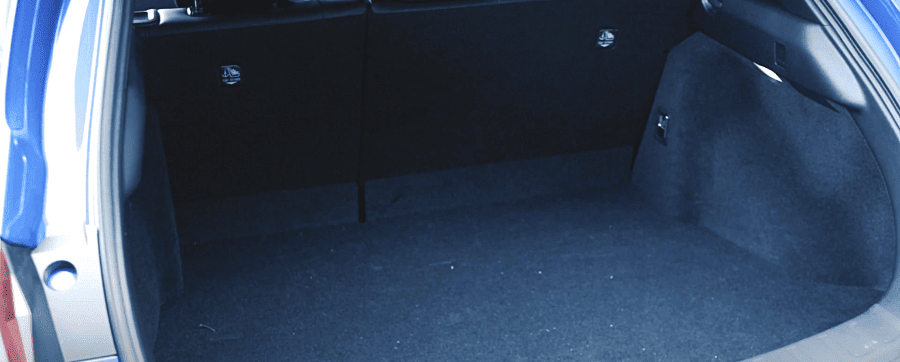
What is the Lexus UX 300e like to drive?
When behind the wheel of the Lexus UX 300e, we recommend having the vehicle in Eco Mode for everyday driving if you want to maximize the driving range as much as possible. It is worth noting that it is a little bit sluggish off the block as it takes a little bit of time to get going. I
f you want to remedy that, we do recommend sticking the car into Sport Mode, then you’ll get an instant hit of torque and acceleration and that’ll allow you to just shoot off across the road. This mode is perfect for overtaking and pulling out of junctions.
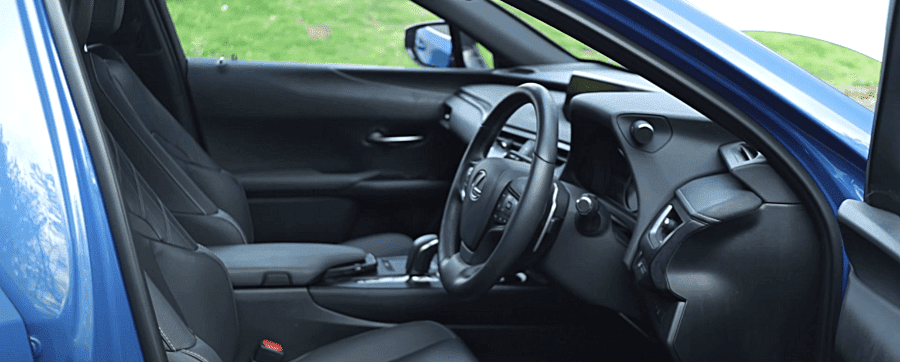
In terms of visibility, you’ve got a great view of the road ahead and that’s thanks to the fairly high-up riding position that this compact SUV gives you. Unfortunately, the view out the side isn’t fantastic, due to the rather wide side pillars.
You’ll find when you come to a junction or roundabout, it’s a little bit tricky to judge a gap and you’ve got quite a big blind spot behind you.
Thankfully, the mirrors are pretty wide, giving you a great deal of visibility of what’s directly behind you. You do also get “warning” sort of indications on the mirror if a car is passing quite close to you.
The view out of the back is okay, it’s not as bad on some of those coupé SUV crossovers, but we were a little bit disappointed with how Lexus has followed the trend of a lot of manufacturers: to touch up any flaws with the design of the car with advanced driver assistance features such as front and rear parking sensors as standard and a rear-view camera to help you manoeuvre into those tight spaces.
While it’s great to have those features and they would be sorely missed if they weren’t there, we feel like the car’s design should make up for those shortcomings in the first place.
A note on the tech when driving, the head-up display shows your speed and speed limit in the area. This is very handy, especially when you’re driving through a town, that then merges onto a dual carriageway and you’re not quite sure what the speed limit is.
We also had the map view up on the infotainment screen when driving the Lexus UX, this was incredibly handy as well. The driver display also showed the driving mode that we were in, the speed that we were going at, and how much charge we had left in the battery.
While all of that sounds distracting, it all works in harmony to add to that very sleek driving experience.
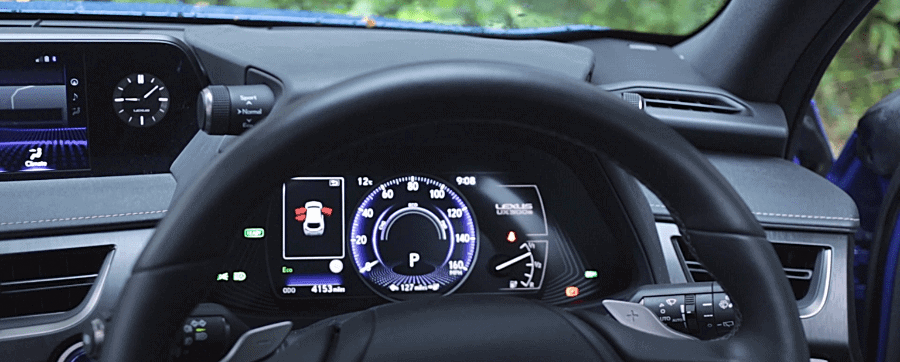
As for the steering, it’s not as light as you’ll find in the Citroën ë-C4 but it’s not as firm as in vehicles such as the Audi e-tron which was far too firm for our taste.
For us, we found it to be somewhere in between which we loved since while the ë-C4 offered a mainly relaxing and smooth driving experience, it didn’t prioritize driving dynamics.
Instead, this car finds a nice balance. You’ll enjoy driving it, especially when you put it in Sport Mode, it’s quite exhilarating but also very comfortable and very smooth to drive.
In Sport Mode, when going for an overtake, you hear the battery just kind of boot up a little bit more. This mode is fantastic for overtakes and just getting out of precarious junctions. There’s hardly any noise from the road or the wind seeping into the cabin.
This car handles any kind of outside noise incredibly well, providing you with an incredibly quiet cabin, making for a very relaxing driving experience. This might come as no surprise, as Lexus has always done this exceptionally well, but the Lexus UX 300e handles imperfections in the road incredibly nicely, seemingly gliding over them with no issues at all.
Even with the harshest of potholes, this car will handle incredibly well. The impact of that will resonate throughout the cabin but it is softened quite considerably compared to other electric cars on the market which is great to see and that’s a massive benefit of this vehicle.
If you are looking for a very smooth driving experience and that is your priority out of your next car, then we can’t recommend another EV as much as this one.
What’s the interior of the Lexus UX 300e like? What tech is included?
We were extremely impressed with the interior as there are lots of high-quality materials on display. We were also quite astounded by how many different materials Lexus has used inside the cabin.
There are some nice, high-quality plastics near the dashboard, a leather effect trim running underneath the infotainment system embellished with some gorgeous grey stitching, there are more nice materials surrounding the air vents, gloss black near the seat functions, and then a gloss black down here in the centre console.
While there’s just so much going on, it all harmonizes really nicely together, so great job Lexus.
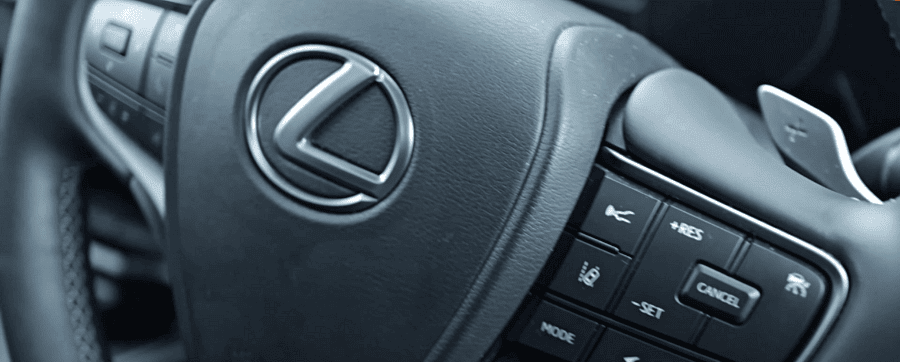
As for the finer details, you get a heated steering wheel with the “Takumi” and “Premium Plus” packs. We loved the feel of this with the leather trim surrounding it. It’s very comfortable and quite squishy, meaning it’s very nice to use while on the move.
Behind the steering wheel, is a Japanese Washi-inspired digital instrument panel that displays your speed, how many miles you’ve got left on the battery, and what driving mode you’ve selected.
To switch between the different driving modes, there’s a toggle above the steering wheel. You can choose between Sport, Eco, and Normal.
As mentioned earlier, Eco is what we recommend you have the car in for the majority of the time as it will maximize driving efficiency and range as much as possible.
Normal is for everyday driving and Sport is when you want to get an instant hit of acceleration and torque, perhaps you want to manoeuvre out of a junction or a roundabout quite rapidly, that’s the mode that you want to put the car in.

In terms of tech, the Lexus UX 300e offers a 7-inch media touchscreen, that can be upgraded to 10.3-inches if you upgrade with the “Takumi” pack.
We love the graphics as they’re very sharp, it’s responsive to use while on the move, there’s very little lag at all, and we love how it’s angled towards the driver slightly, so it’s not too distracting to use while travelling from A to B.
We’ll also note that the “Takumi” pack configures a head-up display that projects your speed and the speed limit of the area directly onto the road ahead, which is a very handy feature so you don’t need to keep glancing down at the driver display behind the steering wheel.
There is a gorgeous analogue clock on the side of the media screen, nicely juxtaposing the digital media screen. Further down the centre console, you get a couple of air vents.
The climate control is fantastic and it’s all controlled using physical buttons which we love to see. These buttons are very nice and responsive and quite “clicky” as well, making for a quite satisfying experience when pressing them.
Just below is an indication that you get the Mark Levinson 13-speaker premium sound system with the “Takumi” pack. It sounds fantastic and you’re going to love playing your albums and podcasts while on the move.
Further down are buttons to control the heated and ventilated seats and the heated steering wheel. This is particularly handy on a cold winter’s morning. You get those with the “Premium Plus” and “Takumi” packs.
Just below that is the wireless smartphone charging pad with the option to turn it on or off to preserve battery life a little bit longer. If you don’t want to use the wireless charging pad, there’s a 12-volt socket for plugging in a laptop or a tablet.
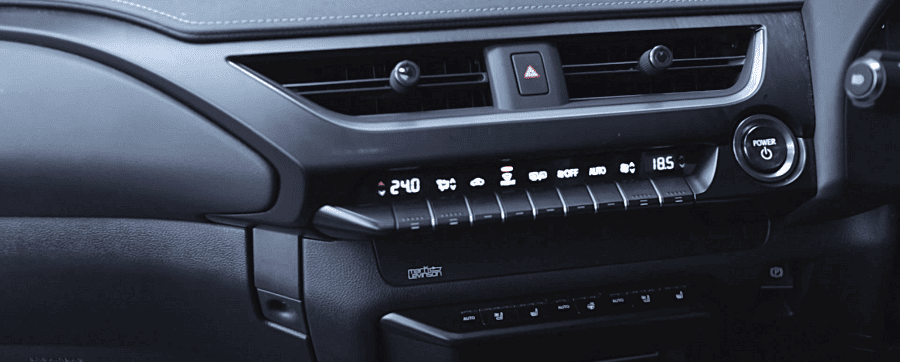
In the nicely-designed centre compartment, you get a couple of cupholders that easily fit your flask full of your morning coffee or tea.
You get a touchpad that’s used for controlling the infotainment display, it’s very responsive to use, it has a nice bit of haptic feedback, and you get shortcuts for the map and menu where you can quickly navigate to both.
We weren’t sure if we liked this as much as the rotary dial that you get in BMW and MINI models, but it’s pretty good. There’s also the gear selector. As it’s fully automatic, you’ve got Drive, Neutral, Reverse, and the parking brake.
There is a weird section of the centre compartment that struts out awkwardly which we weren’t sure what to make of it, but it’s used for navigating between the radio and media and adjusting the volume.
You can open the centre compartment from that side, and it’s quite spacious. There are a couple of USB ports and an area to plug in your phone, if you want to connect it up via AUX, for example.
There are some more other storage areas, there’s the fairly spacious glovebox with enough room to fit your manuals and other bits and bobs and there are door bins on either side of the front passenger and driver’s seat.
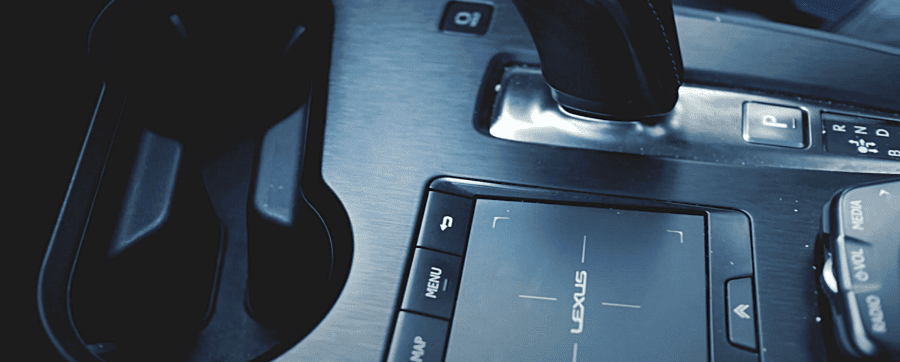
We configured the Lexus UX 300e with a sunroof with the “Takumi” pack. This is great as it lets plenty of light inside the cabin. Because this is quite a compact car, it can seem quite dim inside so it’s nice to have that option to light it up a little inside.
The seats are incredibly comfortable, even more so than in the Citroën ë-C4. We were very happy with them. They’ve got a nice amount of lumbar support, and they nicely hold you in place when going around corners.
You get electric adjustment as standard, which is great to see, and there’s loads of adjustability to be had to find the perfect driving position. Because you sit quite high up in this vehicle, it’s really easy to find a great position where you’ve got a nice view of the road ahead.
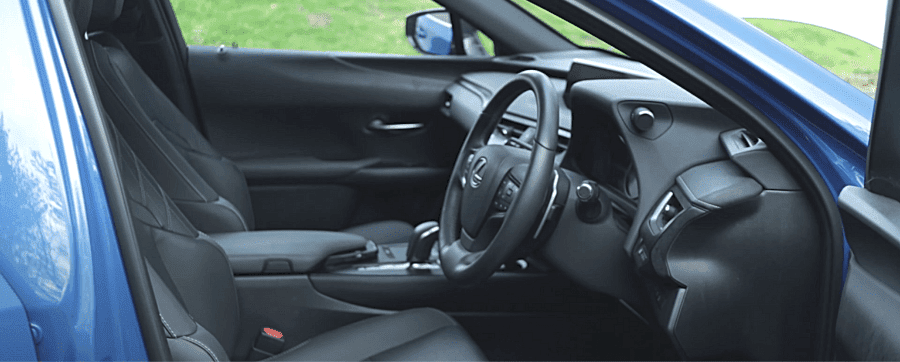
Is the back of the Lexus UX 300e comfortable?
How much space is imported for rear passengers? Well, the back of the Lexus UX 300e is okay, however, it is a little bit cramped. Because the battery is underneath the floor of the vehicle, it means that the rear seats are slightly raised than what you would expect in a petrol or diesel car.
That can result in quite an awkward seating position. This could get uncomfortable on a long journey as your knees are quite high. Legroom isn’t fantastic either, we can’t stretch my legs out all of the way, however, this depends on the front seat’s adjustability.
The headroom is okay and you should be okay if you’re over six feet tall. However, we would imagine three passengers in the back, who are all over six feet, are going to be very uncomfortable, as you’re going to be touching elbows. It definitely won’t be a very pleasant experience.
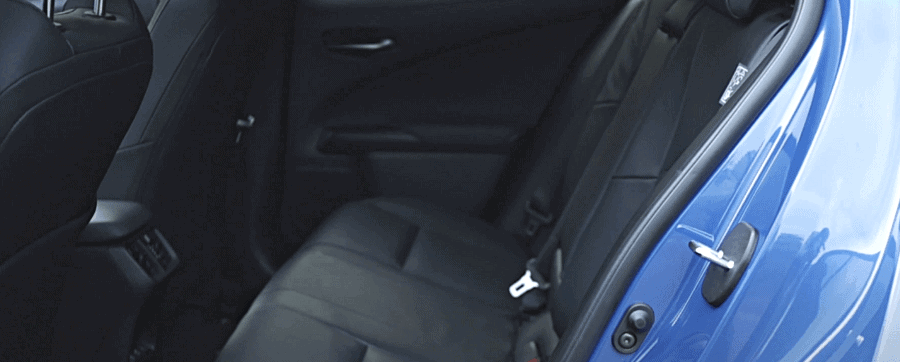
The back of the front passenger seat has a little pouch for your tablet or something, but there isn’t one on the back of the driver’s seat, which is a bit confusing.
Passengers do get a couple of air vents which is nice to see, though you will be at the mercy of whoever’s controlling the climate control in the front.
You also get a couple of USB ports and heated back seats that come with the “Premium Plus” and “Takumi” pack so at least the rear passengers are going to be comfortable to an extent on a winter’s morning.
If you don’t have a middle rear passenger, you can fold down the centre compartment inside the middle seat to get a couple of cupholders, but they do make it a bit awkward when you want to rest your arm on it as your hand is just going to be hovering over them and it’s quite uncomfortable due to that plastic surrounding the cupholders.
The middle seat isn’t fantastic in terms of comfort, the plastic from the compartment sort of digs into your back.
Short journeys (5 to 10 minutes) would be fine but we wouldn’t recommend it for longer journeys as you will be encroaching on the personal space of the other rear passengers as well. There are also a couple of Isofix supports on either seat which is nice to see.
Let us know what you make of the interior and if you’d like to explore your options a bit more closely with one of our vehicle specialists as we can personalize this interior a bit more to your liking, make sure to get in touch today on 01903 538835 or click the banner below to book a date or time for a chat.
What are the Lexus UX 300e’s specs? What are the UX 300e’s range and charging times?
Let’s now talk about the powertrain on offer. There’s only one powertrain option available with the Lexus UX 300e.
Inside the bonnet is a 54-kilowatt-hour battery pack, delivering 201 brake horsepower when combined with the single electric motor, and 300-Newton-metres of torque, for a 0 to 62 miles per hour time of 7.5 seconds, which is pretty quick for a compact SUV, especially when you put the car in Sport Mode and you get that instant thrust of acceleration and torque, it’s exhilarating and it gets you quick off the block.
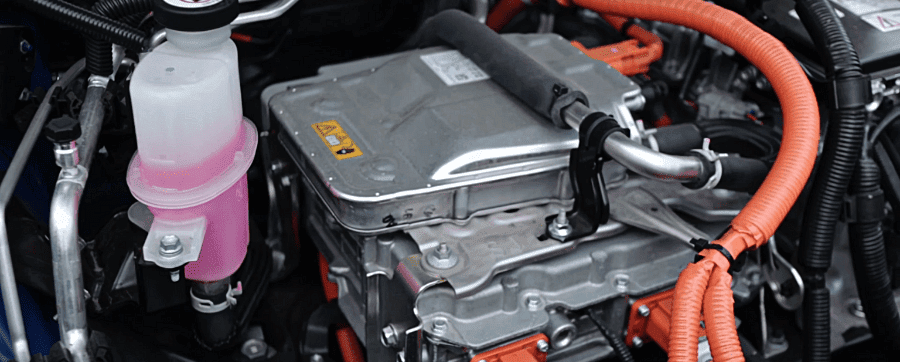
How far can you travel on a single charge? This depends on what wheel size you’ve opted for. With the standard 17-inch alloy wheels, Lexis quotes an all-electric range of 196 miles.
This does of course depend on a variety of conditions, including the road, weather, how fast you’re travelling… etc. If you have the 18-inch alloys that you get with the “Takumi” pack, then Lexus quotes 190 miles.
This isn’t too bad, though both of these ranges are a lot less than you’ll get with the Kia e-Niro and the Citroën ë-C4, so that’s a little bit disappointing.
We would have liked this car to reach the 200-mile range mark as we would have been much more comfortable with that, though, if you do need to take this car for a long journey, you shouldn’t have any range anxiety as you can park it up at a motorway service station and take advantage of rapid charging, which this car does support, and you’ll be off on your way in no time.
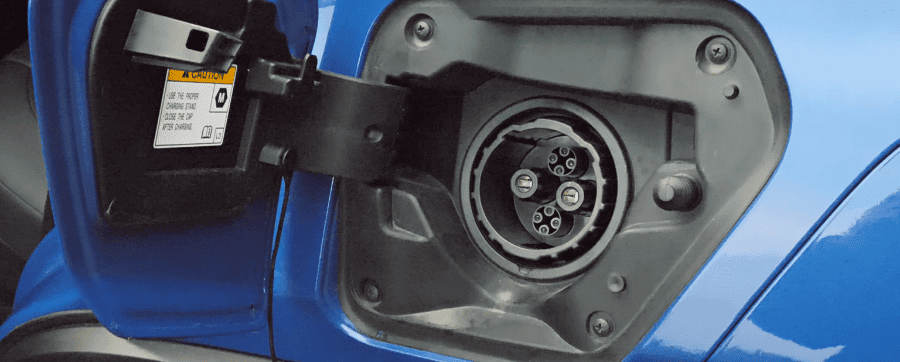
How long does the Lexus UX 300e take to charge? When you plug the UX 300e into a conventional three-pin plug, it will take around 15 hours and 20 minutes to charge from 0 to 80%. That may sound like a lot but compared to other electric vehicles, it’s not too bad.
If you have a lazy Saturday or Sunday, you can plug it in and it will be topped up for you ready for the new week. If you do need it to charge slightly faster, we do recommend installing a home wall box.
From a 6.6-kilowatt AC unit, it will take around six and a half hours to do 0 to 80%, which is much faster. You can take advantage of cheap overnight tariffs as well to make some significant fuel savings, just remember to plug it in when you get home from work, and it’ll be ready for you the next day.
When you travel up the country, take advantage of the 50-kilowatt rapid DC charging, it will do a 0 to 80% charge in just 52 minutes, so you can just grab a coffee and some lunch and then be on your way.
Which Lexus UX trim should you buy?
Standard Trim
As for trim levels, or packs as Lexus calls them, the entry-level trim is just the UX 300e standard car, and prices for this start from £41,745 and you get a wealth of standard equipment which is all that most drivers will ever need to be fair.
Our highlights include the 17-inch alloy machine finish wheels which look fantastic, the bi-LED headlights with auto high beams, the 7-inch media system with Apple CarPlay and Android Auto, front and rear parking sensors, and the reversing camera with rear guidelines.
That’s just a taste of what’s on offer, definitely a lot of equipment to enjoy with this standard spec, so don’t worry too much if you just really want to get the Lexus UX 300e and you’re a little bit paranoid about whether you should go for those higher specs because you’re missing out some extra bits and bobs.
Those high specs just have really “nice-to-have”s which just maximize the overall potential of the package but this standard spec is really good as it is.
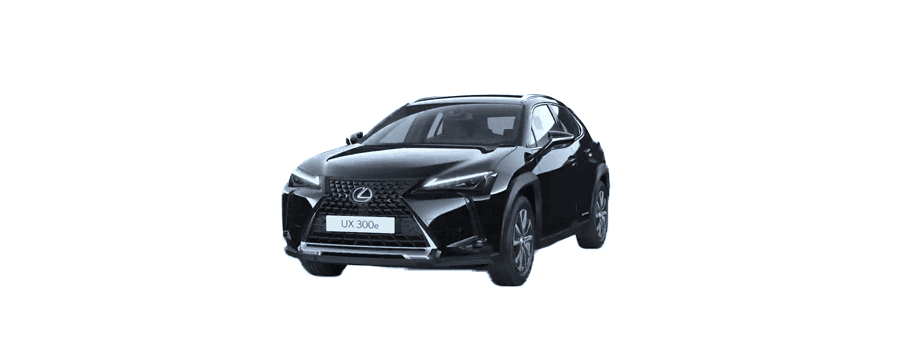
Premium Plus
Next, we have the Lexus UX 300e configured with the “Premium Plus” pack. This will set you back around £45,245 but can climb up to £45,995 if you configure the car with 18-inch wheels.
There’s some really nice equipment to be had with this pack: heated and ventilated front seats, heated rear seats, a heated steering wheel, a wireless smartphone charger in the centre console, and smart entry so you don’t have to unlock the car, it will just know that the keys are in your pocket and unlock for you, plus a load of other equipment as well.
This is really good if you just want to take advantage of some extra features and you don’t mind paying around £3,500 on top of the standard spec.
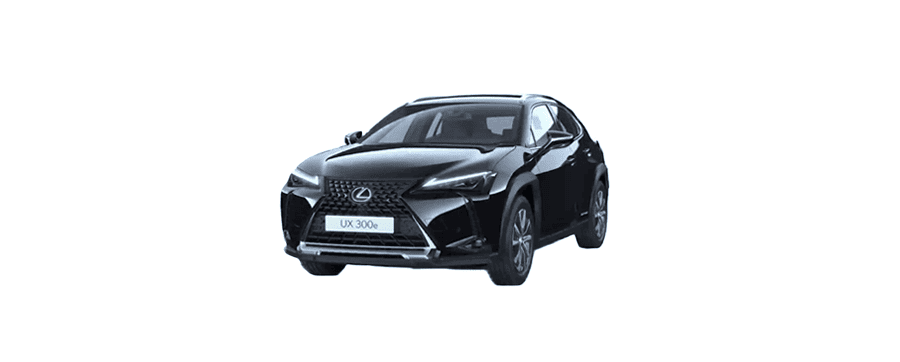
Takumi
The top-spec offering is the “Takumi” pack. This starts from £51,345 so quite a significant premium over that standard specification.
You get loads of really nice equipment with this pack, such as 3i LED headlights with adaptive high beams, a 10.4-inch Lexus navigation system, and the 13-speaker Mark Levinson sound system which sounds extremely nice.
You also get a sunroof, a 360° panoramic view monitor to see everything around the car, which is particularly handy for parking, and lots more as well.
So, if you want to maximize your specification and take advantage of all the equipment that it has to offer, then you need to go with the “Takumi” pack.
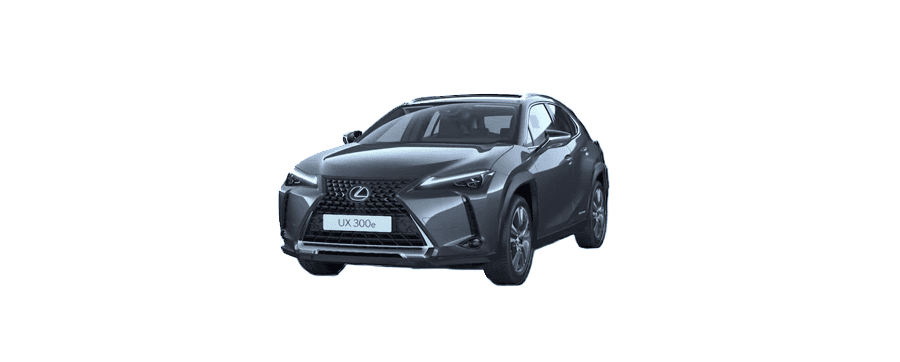
If you have any further questions about the trim levels, make sure to get in touch with OSV’s Vehicle Specialists by picking up your phone and dialling 01903 538835 or you can click the banner below to book a date or time for a free quick chat with one of our team.
Should you buy, lease, or finance a Lexus UX 300e? How reliable is it?
If you’re looking to go electric soon and you want to do so with a premium and up-market model in this really lovely compact-form factor, so it’s not as bulky as something like the Audi e-tron and the Mercedes EQA, this is a fantastic option.
What are some things we absolutely love about the Lexus UX 300e? For starters, it comes well-equipped, even with that standard spec.
You don’t really need to get the “Takumi” pack unless you need to take advantage of everything the car has to offer.
We were very impressed with the overall driving experience, it’s extremely comfortable inside the cabin, we would even say it’s more comfortable than the Citroën ë-C4, which we didn’t expect because we absolutely loved that car, but we think the Lexus just beats out the ë-C4.
It’s very smooth to drive as well, you’ll hardly notice any imperfections in the road, and wind and road noise hardly ever seeps into the cabin.
It’s just so relaxing and comfortable, plus you get a nice bit of performance with that 7.5sec 0 to 62 miles per hour time, so it’s pretty quick off the block and exhilarating to drive at the same time.
You also have to take into account Lexus’ incredible reliability record, they’re constantly topping lists as the most reliable manufacturer out there and it’s not hard to see why.
Our director has owned Lexus models for over 20 years now and she owned one particular model for 11 years. In that time, it broke down a grand total of once and the service she got when it broke down was impeccable, so you have to take into account that Lexus is generally more reliable than other premium manufacturers out there.
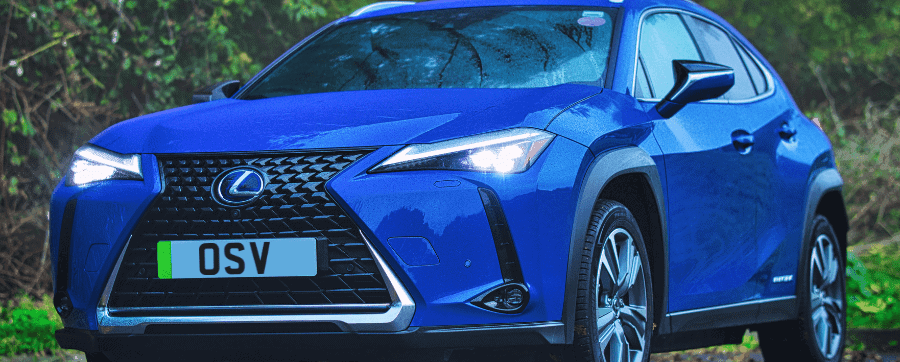
What are some things we don’t like about the Lexus UX 300e?
Well, the visibility could definitely be improved. The side pillars are quite wide inside the car and that makes it difficult to judge gaps at junctions and roundabouts.
It’s also pretty cramped in the back, you couldn’t really fit three adults comfortably for a long journey. Short journeys would be okay but they will definitely be touching shoulders.
The range, while we were generally happy with the 190-196 miles that this car delivers, it isn’t as good as its rivals like the Volkswagen ID4, the Peugeot e2008, the Kia e-Niro, and the Citroën ë-C4.
Those other vehicles all deliver better range than this model so that is something to definitely take into account if that is important to you and you do suffer from range anxiety, but realistically, you’ll extremely rarely do 190 miles on a single charge in a single journey.
As long as you remember to plug it in when you get home from work, this won’t be an issue at all.
If you’d like to explore the Lexus UX 300e a little bit more closely with one of OSV’s Vehicle Specialists, we’ll be more than happy to answer any questions and explore your options to find that specification that meets your needs perfectly.
So, make sure to get in touch today on 01903 538835 or you can just click the banner below to book a date or time that works for you.
If you’re interested, watch our official Lexus UX 300e Car Review, head over to our YouTube channel for OSV Car Reviews and the latest motoring content. Alternatively, you can read our other written Car Reviews.
Car Subscription vs Short Term Rentals
- What is a short term car lease?
- Benefits of short term car leases
- What is a car subscription?
- Benefits of car subscriptions
- Car subscription vs short term rentals
- Which should you choose?
The dawn of a new age in the auto industry is upon us, sparking an intense showdown between car subscription vs short term rental.
A revolution driven by consumer demand for flexibility, affordability, and convenience has paved the road for these innovative services.
But the question that still lingers in the exhaust fumes is – which one will emerge as the ultimate driver’s choice?

What is a short term car lease?
Just as a pit stop provides a brief respite during a race, a short-term car lease offers a temporary agreement between a driver and a leasing company.
Typically, these contracts last anywhere from three to 12 months. However, much like a racecourse, there are specific rules to follow.
Break away from the agreement early, and you’ll face a financial penalty that can feel like hitting a speed bump at full throttle.

Benefits of short term car leases
One of the major advantages of short term rentals compared with car subscriptions, is the flexibility they provide. As drivers, we crave the freedom to navigate our journey, and these leases offer just that.
Plus, they come with a smaller price tag than car subscriptions, making them an attractive option for those on a budget.
What is a car subscription?
Now, let’s rev up and explore the realm of car subscriptions. Essentially, a car subscription is like having a library of cars at your disposal.
You pay a monthly fee, and in return, you get the keys to your chosen car. However, much like a winding road, car subscriptions also have their share of twists and turns.
Potential drawbacks of car subscriptions can include higher costs and a lack of availability in certain areas.

Benefits of car subscriptions
In the high-speed chase for automotive convenience, car subscriptions are taking the lead. Their flexibility is simply unmatched – change your vehicle as often as your mood dictates (within a minimum of 30 days).
Moreover, most car subscriptions come as comprehensive packages, bundling in costs such as maintenance and insurance. It’s as close as you can get to a worry-free driving experience.

Car subscription vs short term rental
It’s time for the main event – a head-to-head comparison of car subscription vs short term rental. In terms of cost, short term leases tend to be more wallet friendly.
However, when you factor in the all-inclusive nature of car subscriptions, the financial scales may start to balance.
When we look at the commitment factor, car subscriptions again edge forward with their unrivalled flexibility. But in terms of convenience, it’s a close race.
See this table below comparing the two options:

Car subscription vs short term rental: Which Option Suits You Best?
Much like selecting a car that suits your taste, your choice between a short term lease and a car subscription will largely depend on your individual circumstances.
Are you seeking low costs or ultimate flexibility? Is long-term commitment a concern, or are you more focused on having an all-inclusive package? Your unique needs and goals will guide your decision.
The Road Ahead: Future Trends in Car Subscription vs Short Term Rental
As we steer into the future, we can expect to see short-term car leases continuing to offer a flexible and affordable solution for many drivers.
However, car subscriptions are fast gaining momentum. With their revolutionary approach, they’re changing the game, putting consumers in control like never before.
Conclusion: Car Subscription vs Short Term Rental
So, who crosses the checkered flag in this intense race of car subscription vs short term rental? Both short-term car leases and car subscriptions offer compelling advantages.
The ultimate choice depends on you, the driver. Your preferences, needs, and circumstances will determine the winner.
One thing’s for sure though – this thrilling race signifies an exciting era in the auto industry, steering us towards a future of greater choice and flexibility. Buckle up and enjoy the ride!

Car Subscription vs Leasing: Which should you choose?
- Pros and cons of car subscriptions
- Pros and cons of leasing
- What to consider when choosing between car subscription and leasing
- Cost comparison of car subscription and leasing
- Car subscription vs leasing – which is ideal for me?
Car subscription vs leasing: two popular alternatives to car ownership that offer various benefits and drawbacks.
The concept of leasing a car gained popularity in the 40s, and whilst leasing has been around for decades – the idea of subscribing to a car is a very new concept to most.
So, what are the differences between car leasing and a car subscription? Most importantly, which is the perfect option for you? Read on for a full investigation of car subscription vs leasing…
Pros and Cons of Car Subscription
A car subscription is a flexible alternative to car ownership that allows you to switch between cars, usually for a monthly fee.
So, what do you need to know about car subscription vs leasing? How do they compare?
Pros:
- No long-term commitment: Unlike leasing, a car subscription doesn’t require a long-term commitment, so you can switch between cars as often as you want. (Hooray for car fanatics!)
- Flexibility to switch between cars: A car subscription allows you to drive different cars depending on your needs and preferences, which is particularly useful for people who like to try out new cars and test going electric before taking the plunge.
- Convenience: A car subscription typically includes maintenance, insurance, and other fees, so you don’t have to worry about additional costs.
- Lower upfront costs: A car subscription usually requires lower upfront costs than leasing or buying a car outright.
- Option to try out luxury cars: Car subscription often includes high-end cars that you might not be able to afford to lease or buy outright.

Cons:
- Higher monthly payments: A car subscription can be more expensive than leasing or buying a car. The higher monthly costs are due to the all-inclusive “package” drivers get. This usually includes insurance, maintenance, and various other things.
- Limited mileage: A car subscription usually has mileage restrictions. So, if you’re planning to take spontaneous trips across the country, you could face fees for going over the agreed mileage.
- No equity or ownership: With a car subscription, you don’t own the car, so you can’t build equity or sell it later on.
- Potential for additional fees: Car subscriptions may come with additional fees, such as cancellation fees, maintenance fees, or excess mileage fees.
- Limited availability in some areas: Car subscription is not available in all areas, so you may have limited options depending on where you live.
Pros and Cons of Leasing
If the idea of committing to a long-term relationship with a car gives you cold feet, fear not, for leasing has emerged as the knight in shining armour!
With leasing, you can seize the wheel of a pristine set of wheels for a fixed period, usually spanning two to four years, all in exchange for a modest monthly fee.
So, if you’re keen on sparing your wallet while indulging in the blissful joy of driving, leasing might just be the sleek and economical choice you’ve been yearning for.
Here’s what you should know…
Pros:
- Lower monthly payments: Leasing typically requires lower monthly payments than buying a car outright, so it can be a good option if you’re on a tight budget.
- No long-term commitment: Like a car subscription, leasing does not require a long-term commitment. This gives you the opportunity to drive a new car every few years without having to worry about selling or trading in your old car.
- New car every few years: On a car lease, you get to drive a brand-new model every few years. This means you always have a reliable and up-to-date car!
- Tax benefits for businesses: Leasing can provide tax benefits for businesses, as the monthly payments may be deductible.
- Option to buy: With car leasing, you have the option to buy the vehicle at the end of the agreement. This is a fantastic option to have if you like the car to begin with and you’re considering keeping it at the end.
Cons:
- Mileage restrictions: Leasing typically has mileage restrictions, so you may have to pay extra if you exceed your allotted mileage.
- Potential for additional fees: Leasing may come with additional fees, such as maintenance fees, excess mileage fees, or wear and tear fees.
- Early termination fees: If you terminate your lease early, you may be charged an early termination fee.
- No equity or ownership: At the end of your lease, you will not own the car.
- Wear and tear: If you decide not to buy the car at the end of the lease agreement and return it instead, the vehicle must not exceed standard wear and tear conditions. If this happens, you are likely to face surprise fees.
- Limited customisation options: With leasing, you may be limited in customising the car to your liking.
Factors to Consider When Choosing Between Car Subscription vs Leasing
When embarking on the thrilling journey of choosing between a car subscription vs leasing, there are a few key factors that deserve your attention. Let’s dive into the pit stop of considerations, shall we?

Flexibility: Car subscription shines in the realm of flexibility, allowing you to switch between different models whenever the road beckons.
If you crave variety and enjoy the thrill of driving a new set of wheels frequently, a subscription might be your turbocharged choice.
On the other hand, if you prefer a more consistent and predictable driving experience, leasing offers stability with a fixed vehicle for a specified period.
Budget: Rev up your financial engines and consider your budgetary constraints. Car subscriptions often involve a higher monthly fee since you’re essentially paying for the flexibility and convenience it offers.
Leasing, however, typically comes with lower monthly payments, making it an appealing option for those who want to keep their wallets from running on empty.
Mileage and Usage: Take a pit stop and assess your driving habits. Are you a long-distance road warrior or more of a weekend explorer?
Car subscriptions often have mileage restrictions, meaning excessive road tripping might incur additional costs.
Leasing, while still having mileage limitations, tends to offer more generous allowances. Consider your anticipated mileage and choose the option that aligns with your driving style.
Maintenance and Repairs: Pit crews and car maintenance go hand in hand. With a car subscription, the provider often takes care of maintenance and repairs, sparing you the hassle and extra expenses.
On the other hand, leasing usually requires you to handle maintenance responsibilities, although warranty coverage might still apply.
Consider whether you prefer the convenience of having someone else handle the upkeep or if you’re comfortable taking the wheel when it comes to maintenance matters.
Long-term Commitment: Are you a commitment-phobe or do you relish in long-term relationships? Car subscriptions offer the freedom to hop in and out of different vehicles without a long-term commitment.
Leasing binds you to a fixed term, typically lasting a few years. Evaluate your affinity for commitment and choose accordingly.
Cost Comparison of Car Subscription and Leasing
When it comes to choosing between car subscription and leasing, one of the most significant factors to consider is the cost.
Here, we’ll break down the costs of both car subscription and leasing, so you can make an informed decision.
Calculation of costs for both car subscription and leasing
With a car subscription, you pay a monthly fee that covers various costs, including insurance, maintenance, and roadside assistance.
Leasing, on the other hand, typically involves a down payment, monthly payments, and potentially other fees, such as taxes, registration, and insurance.
Comparison of total costs over time
Although a car subscription may have a higher monthly fee, it can be more cost-effective in the long run, as it includes all the costs associated with car ownership.
With a vehicle lease, you could face additional costs, such as maintenance and repairs. This can add up over time.
Ultimately, the total cost of car subscription and leasing will depend on various factors, including the car model, the length of the subscription or lease, and your individual driving habits.
Car subscription vs leasing – which is ideal for me?
Picture this: a car subscription is like having a personal concierge for your automotive needs. You pay a monthly fee and gain access to a fleet of cars, allowing you to switch between models whenever your heart desires.
It’s like having a never-ending buffet of automotive delights, where commitment takes a backseat and flexibility reigns supreme.
On the other hand, leasing is the seasoned veteran of car arrangements. It grants you the pleasure of driving a brand-new car for a fixed period, typically two to four years, all while keeping those monthly payments in check.
It’s a more structured affair, offering stability and a sense of ownership without the long-term commitment of buying outright.
So, which road should you take? It all boils down to your personal preferences and driving habits.
If variety and flexibility tickle your fancy, and you can’t resist the allure of switching cars like a chameleon changes colours, then a car subscription might be your ticket to automotive bliss.
But if you prefer a more traditional relationship with your vehicle, one that offers stability and a fixed set of wheels, leasing could be the highway to your driving dreams.
Ultimately, the choice is yours, dear driver. So, buckle up, weigh your options, and let your automotive adventure begin!
Car Subscription vs Buying: Which is more affordable?
- What are car subscriptions?
- How does buying a car work?
- Car subscription vs buying
- Factors to consider – car subscription vs buying
- Car subscription vs buying – which is ideal for me?
Car subscription vs buying – which is the more affordable option? Most importantly, which is the best for you?
Buying a car used to be the only option available to car buyers. However, in recent years, car subscriptions have gained popularity as an alternative way to get behind the wheel.
But which option is more affordable? In this blog post, we will explore the costs of car subscription vs buying to help you make an informed decision.
What are car subscriptions?
Car subscriptions are a relatively new concept in the automotive industry. In essence, car subscriptions are like long-term rentals, where you pay a monthly fee to use a car.
The subscription fee usually covers all costs associated with the car, including maintenance, insurance, and repairs.

There are several types of car subscriptions available in the market. Some car subscription services allow you to switch cars every few months, while others offer a fixed-term subscription with a specific car.
The benefits of car subscriptions include the flexibility to switch cars, the convenience of having all costs included in the subscription fee, and the ability to avoid the hassle of selling or trading in a car.
However, car subscriptions also have their drawbacks, including limited mileage options and potentially higher costs than traditional car buying in the long run.

How does buying a car work?
Car buying is the traditional method of acquiring a car. You can buy a new or used car, and financing options are available to help you spread out the cost of the car over several years.
Buying a car comes with its benefits, such as the ability to customize the car to your preferences and the potential to save money in the long run.
However, buying a car also comes with its drawbacks, including the responsibility of maintaining the car and the hassle of selling or trading in the car when it’s time for an upgrade.
Car subscription vs buying
When comparing the costs of car subscriptions and car buying, it’s important to consider all the factors involved.
Calculating the cost of a car subscription involves adding up the monthly subscription fee, which includes all costs associated with the car, such as insurance, maintenance, and repairs. Additional costs may apply if you exceed the mileage limit, return the car with damages, or terminate the subscription early.
On the other hand, calculating the cost of buying a car involves adding up the down payment, monthly car payments, interest on the loan, insurance, maintenance, and repairs. Additional costs may apply if you decide to sell or trade in the car, or if you face unexpected repair expenses.
Factors affecting the cost of car subscriptions include the type of car, the mileage limit, the length of the subscription, and the availability of different features. Factors affecting the cost of car buying include the age and condition of the car, the financing terms, the type of car, and the resale value of the car.
Comparing the costs between car subscriptions and car buying can be challenging, as it depends on several variables, such as the type of car, the length of ownership or subscription, and the usage habits of the driver. However, in general, car subscriptions tend to be more expensive in the long run than buying a car outright.
Factors to Consider – Car Subscription vs Buying
When deciding between car subscription and car buying, it’s important to consider your lifestyle, driving habits, and financial situation.
If you value flexibility and variety, and don’t want to worry about maintenance and repairs, a car subscription may be a better fit for you.
However, if you prefer long-term ownership, and don’t mind taking on the responsibility of maintaining and selling the car, buying a car may be a better fit.
Other factors to consider include the frequency of car usage, the length of time you plan to use the car, the resale value of the car, and the potential maintenance and repair costs over time.

To illustrate the differences between car subscription vs buying, let’s look at two case studies.
Case study 1: Kevin opts for car subscription. Kevin is a young professional who values flexibility and variety in their car choices. They subscribe to a car service that allows them to switch cars every few months, and the subscription fee includes all costs associated with the car. Over the course of two years, Kevin switches cars four times, and the total cost of their subscription is £16,000.
Case study 2: Jane opts for car buying. Jane has a young family who values long-term ownership and doesn’t mind taking on the responsibility of maintaining and selling their car. They buy a used car for £15,000 and finance it over five years with a 4% interest rate. Over the course of five years, the total cost of their car ownership is £19,194.
Analysis and comparison of the two case studies reveal that, in this scenario, a car subscription is more affordable than buying a car in the short-term.
However, in the long-term, car buying may be a better financial decision, as the total cost of ownership is lower over five years.
So, the choice between car subscription vs buying can be decided by cost, but it really boils down to your individual needs and requirements.
Car subscription vs buying – which is ideal for me?
When it comes to choosing between car subscription vs buying, there is no one-size-fits-all answer. It ultimately depends on your lifestyle, driving habits, and financial situation.
Car subscriptions offer flexibility and convenience but may be more expensive in the long run. Car buying offers long-term ownership and potential cost savings but comes with the responsibility of maintenance and selling the car.
Consider all factors involved, and weigh the pros and cons of each option, to make an informed decision that fits your needs and budget.
Next Page » « Previous Page





































